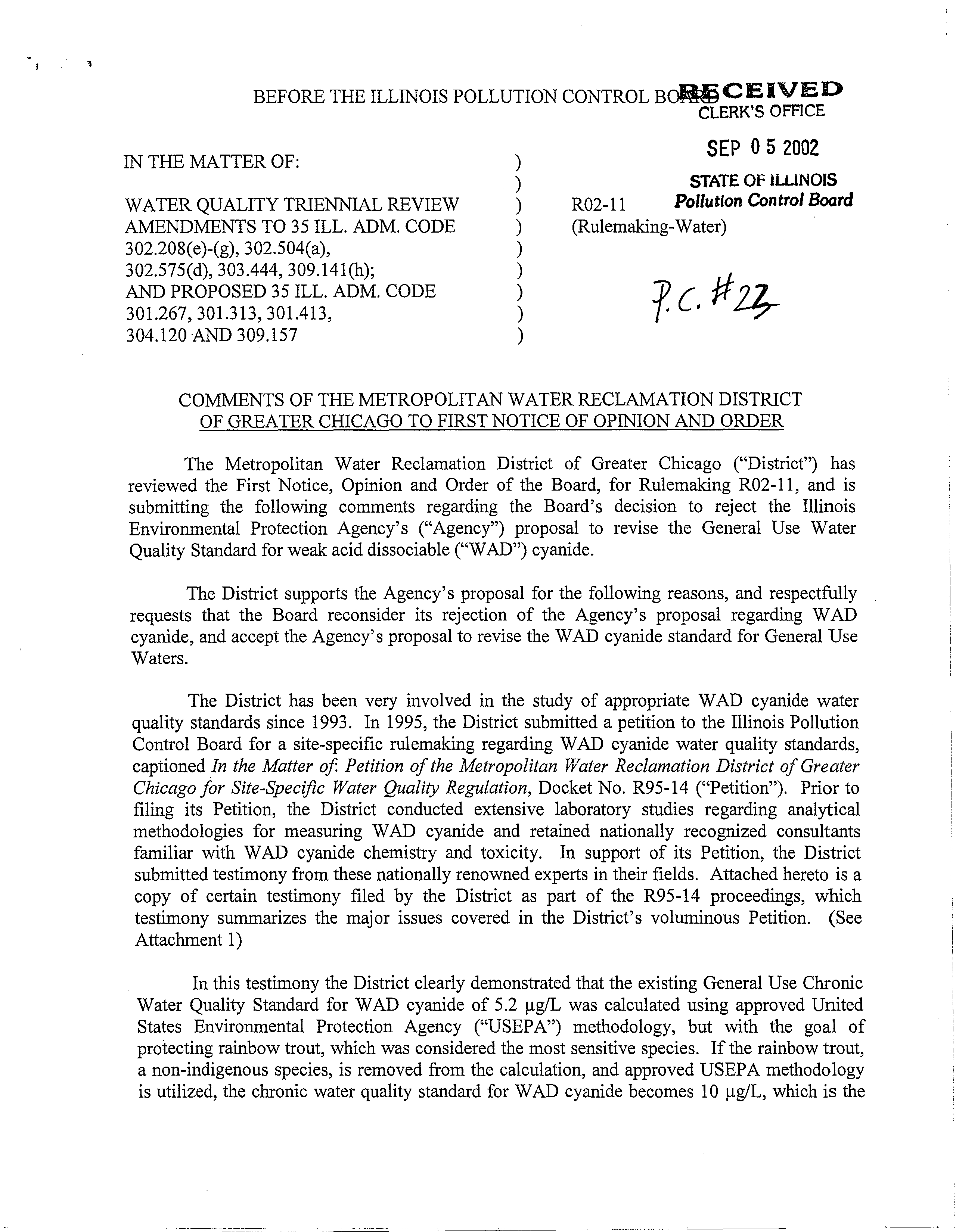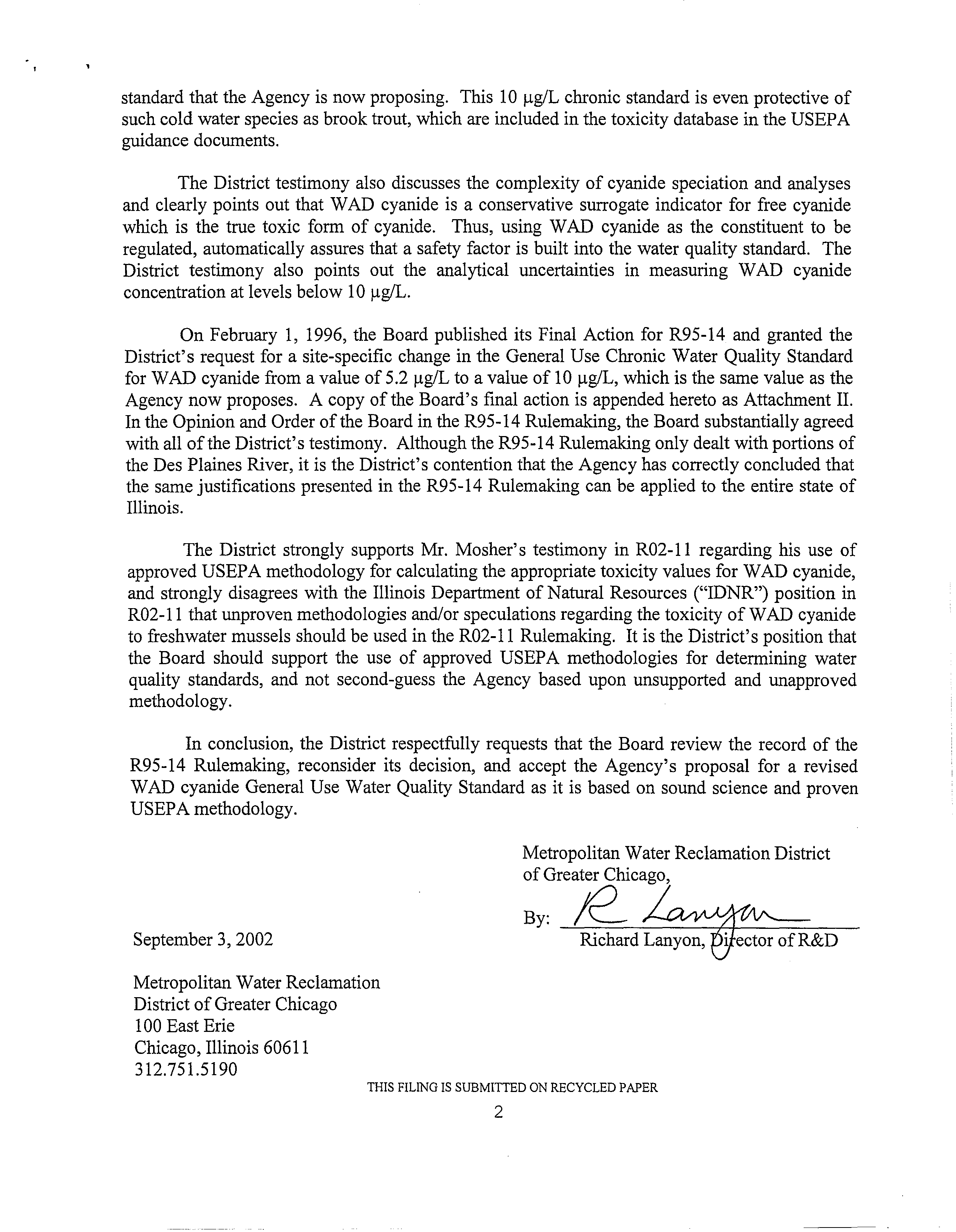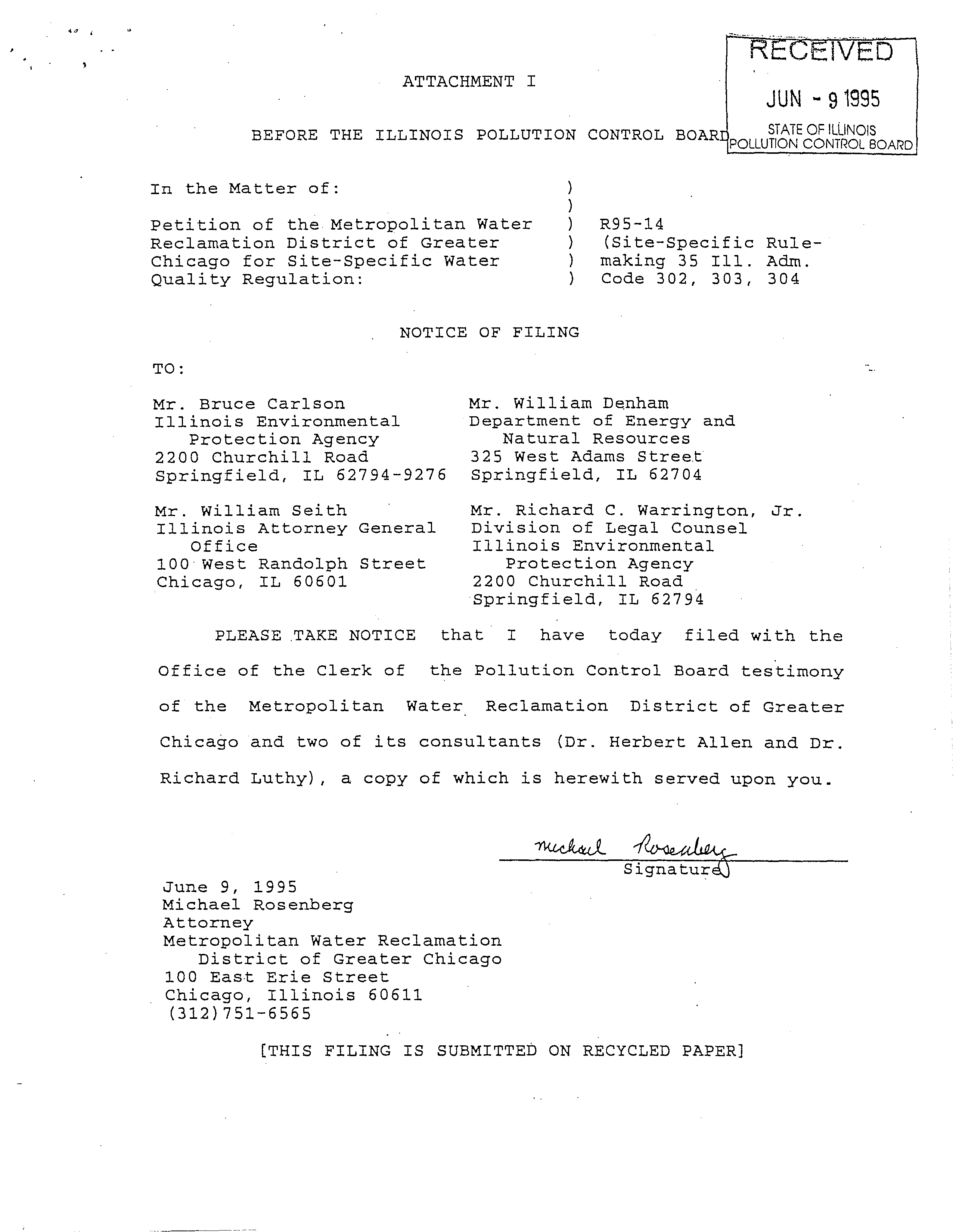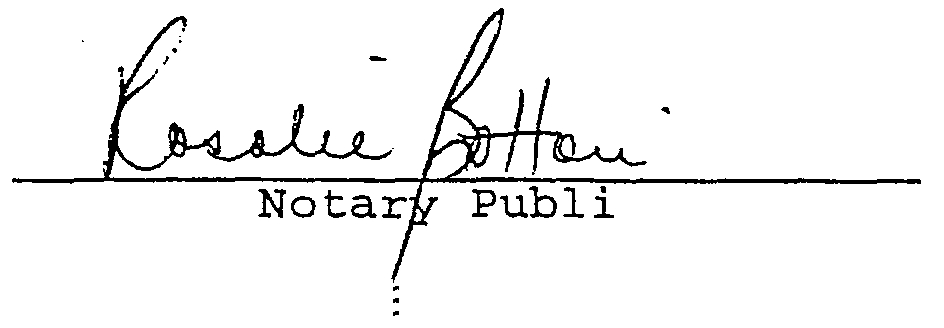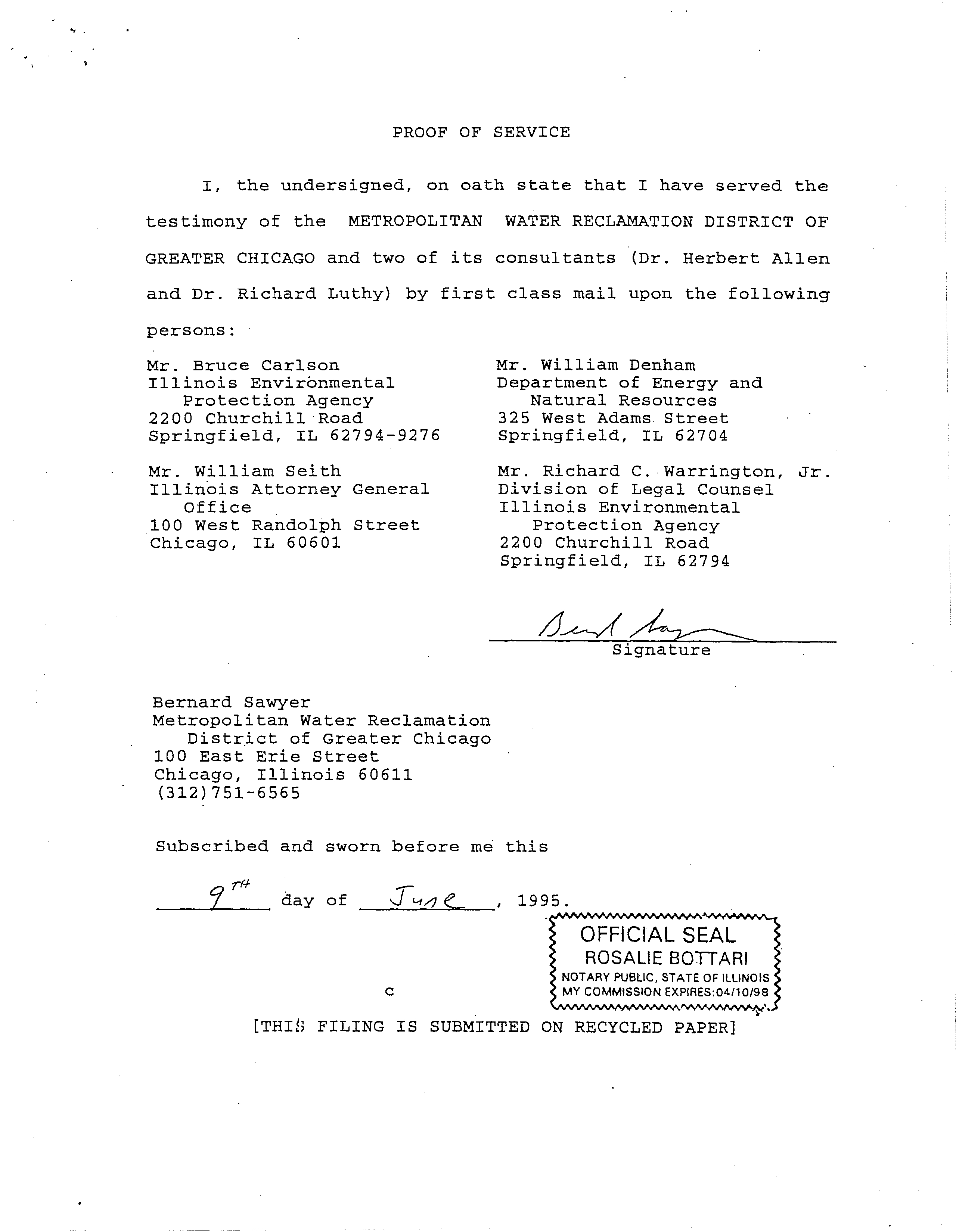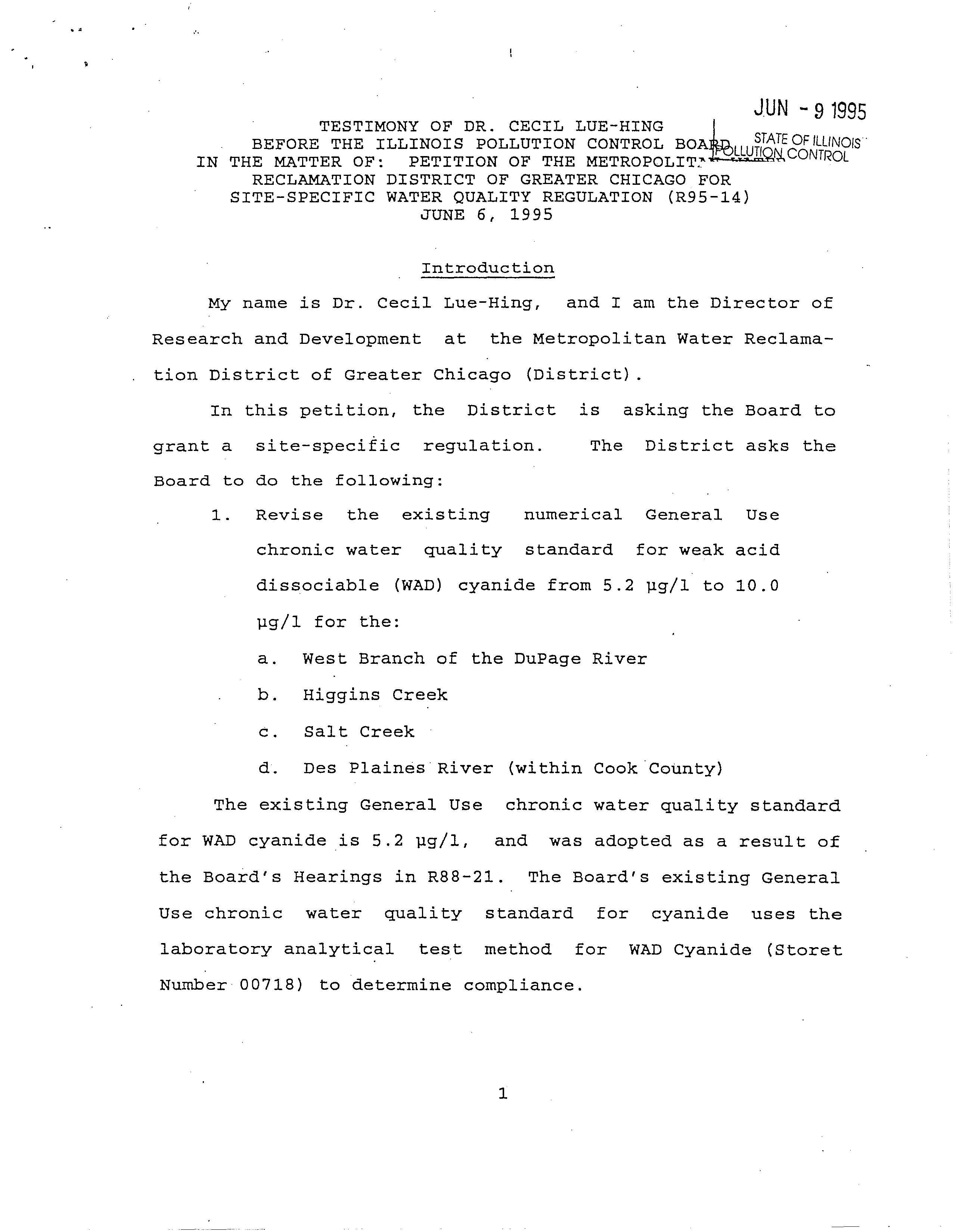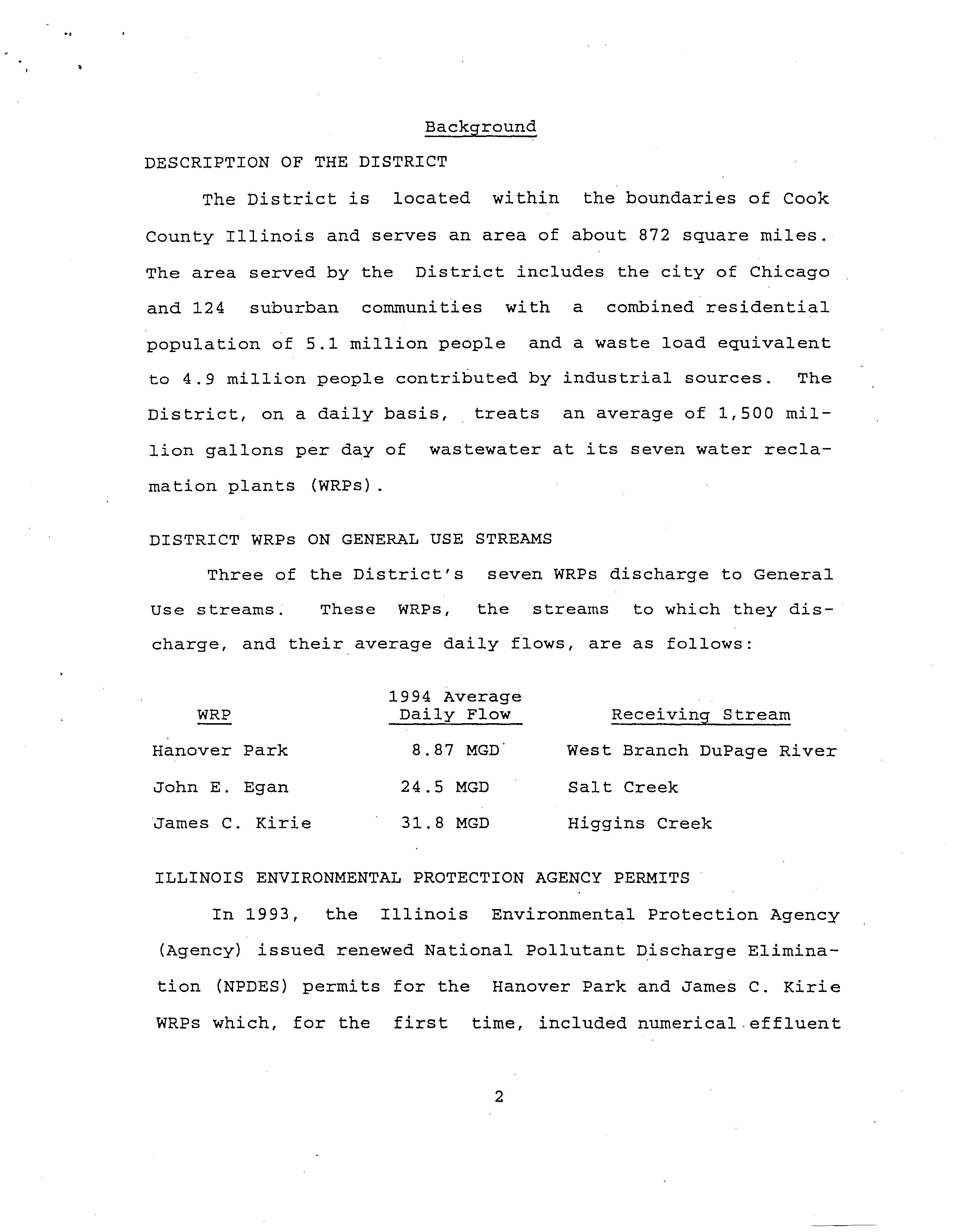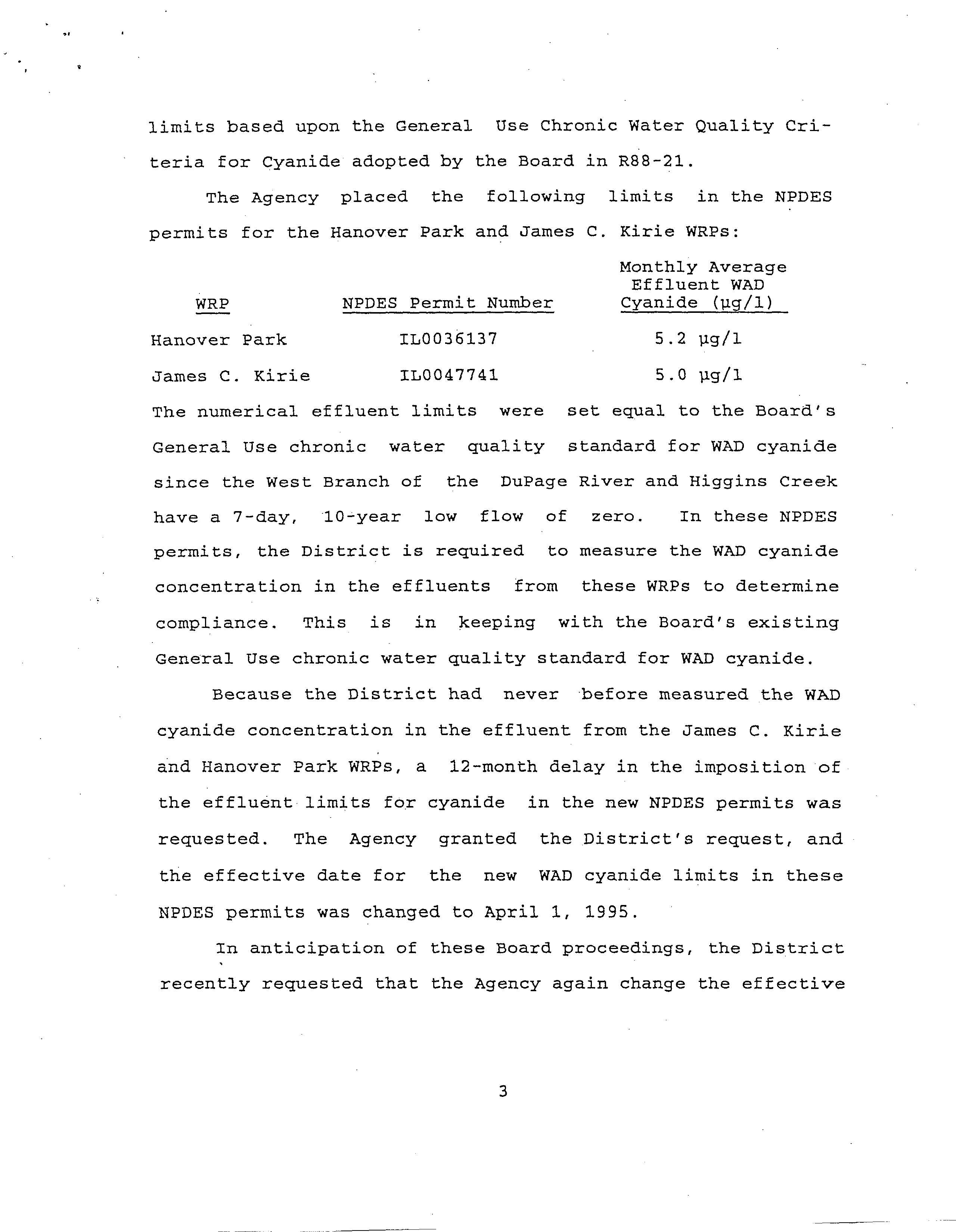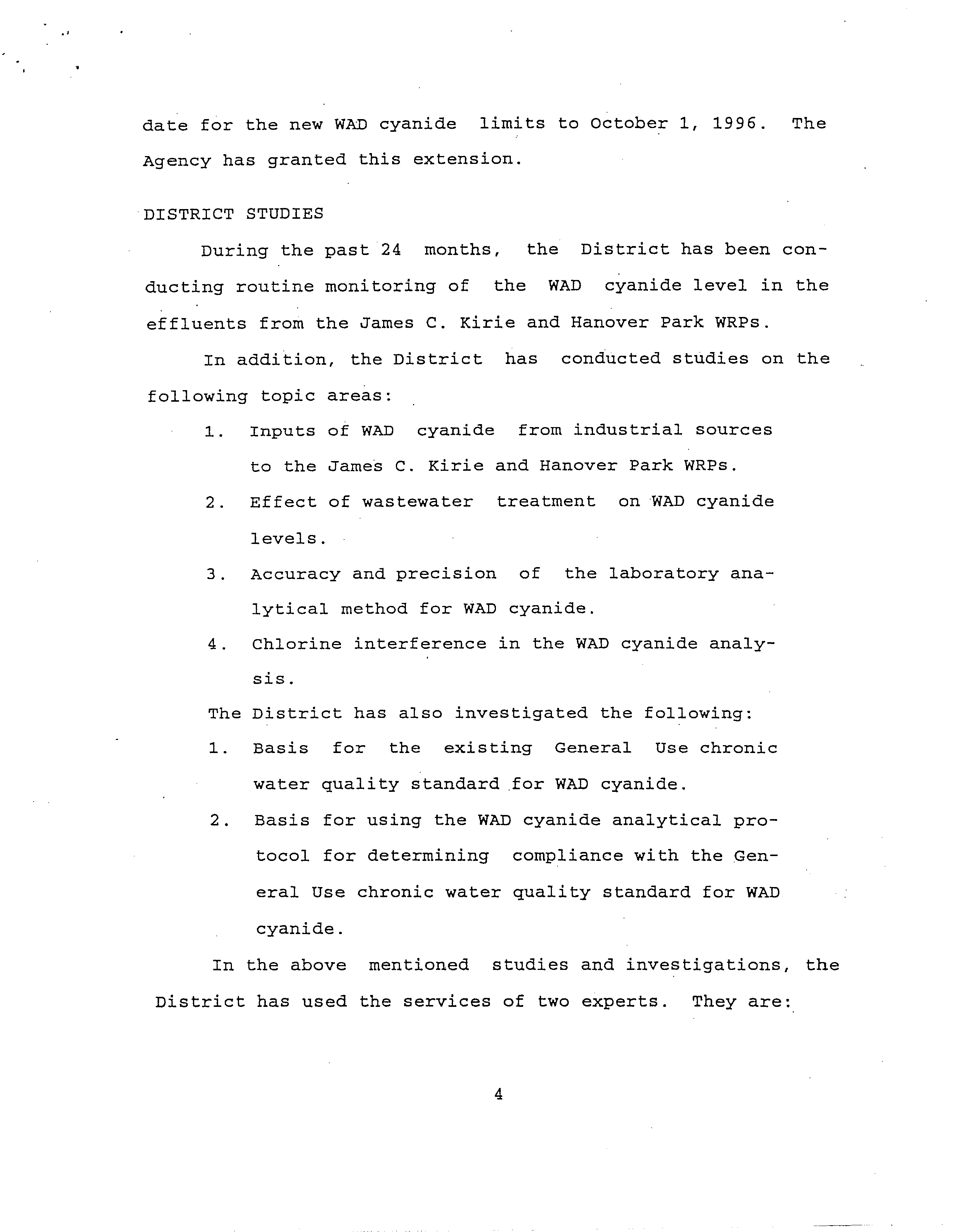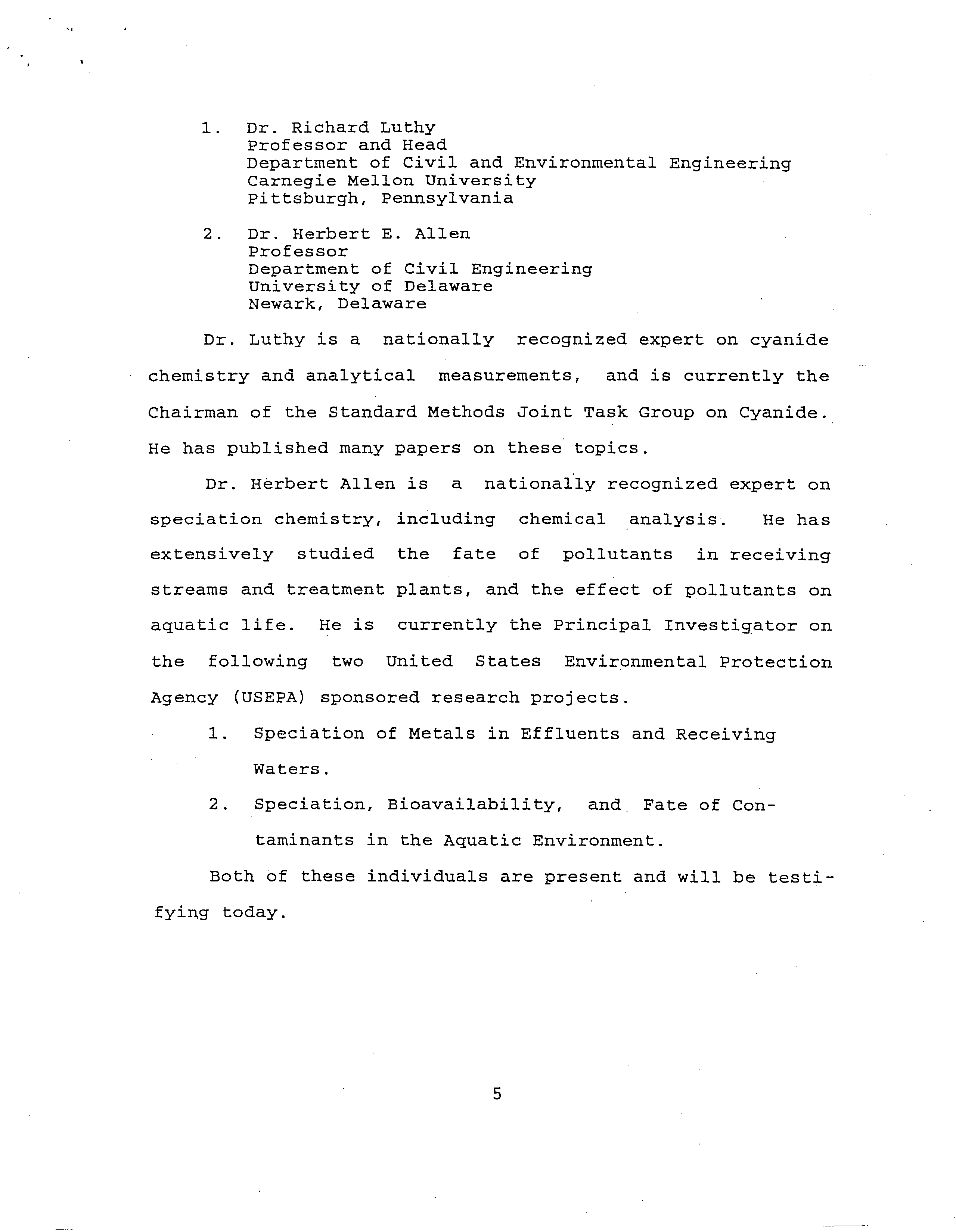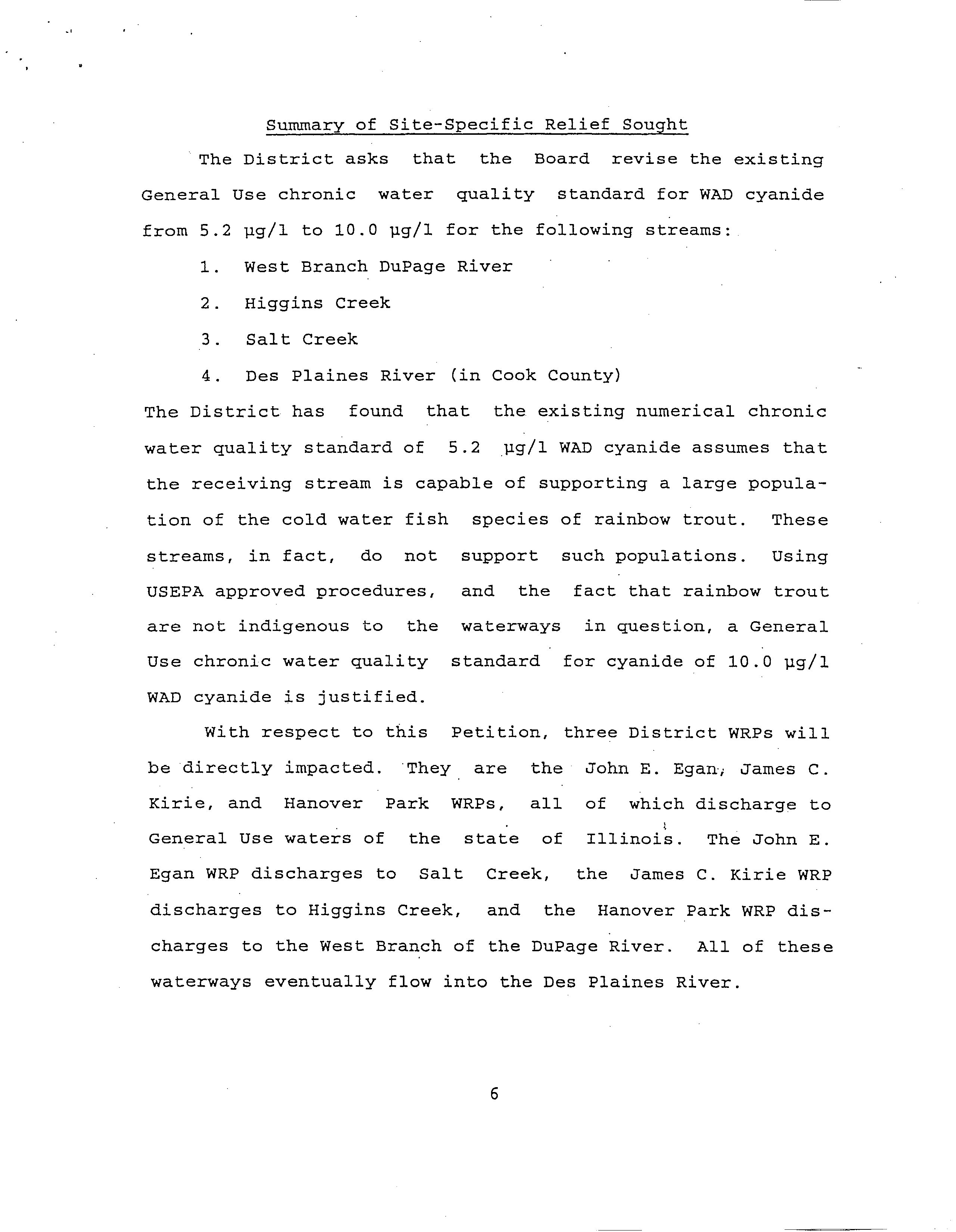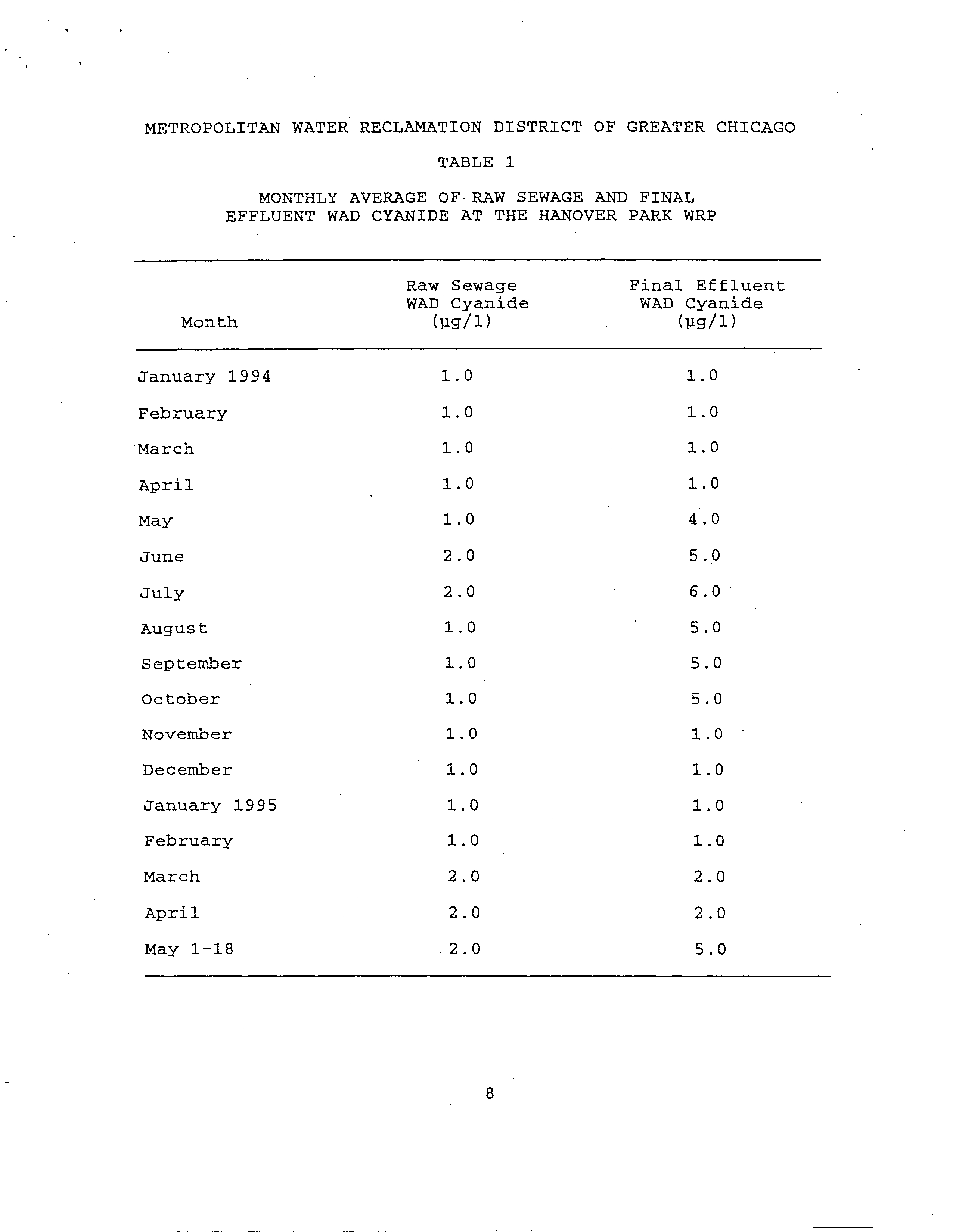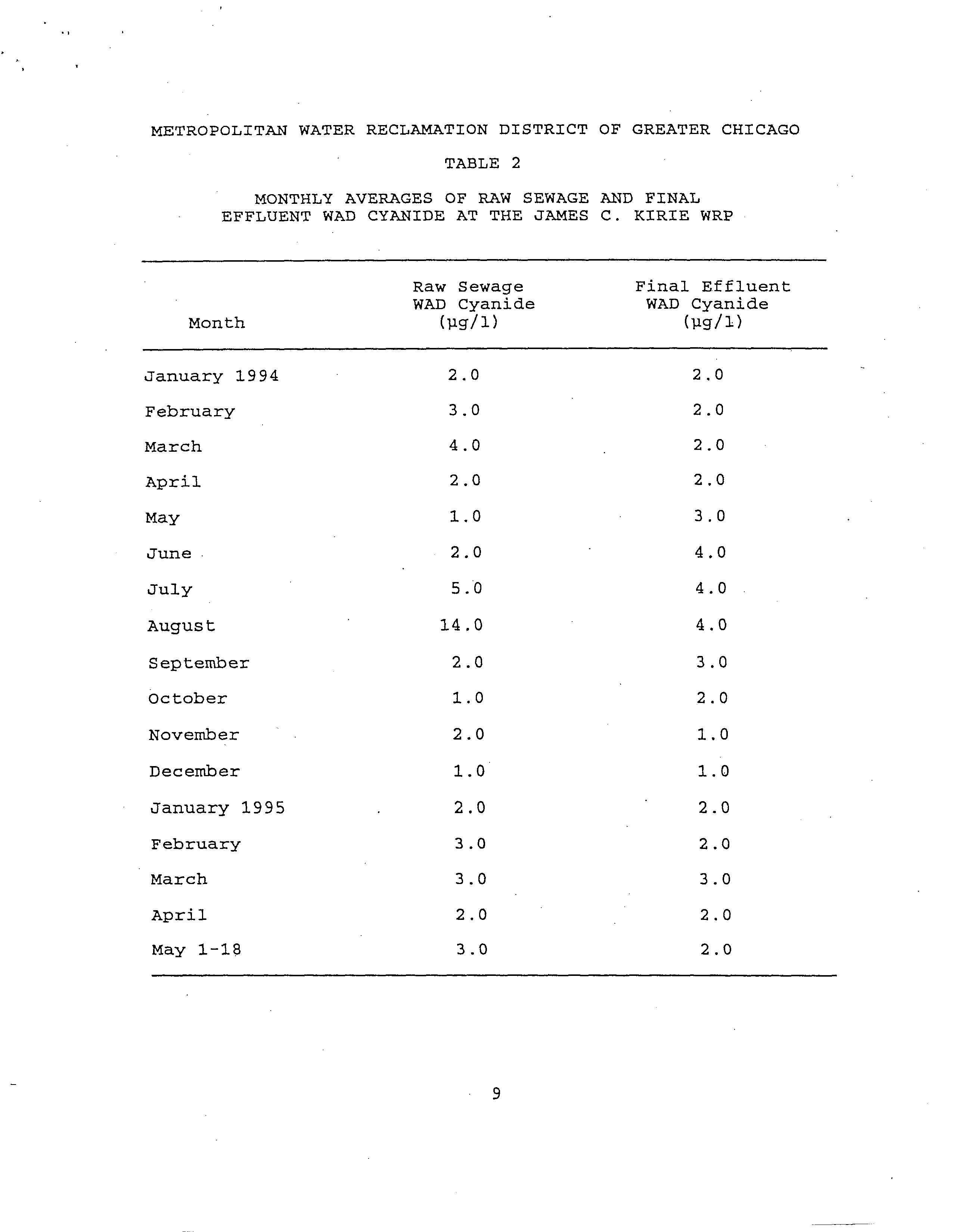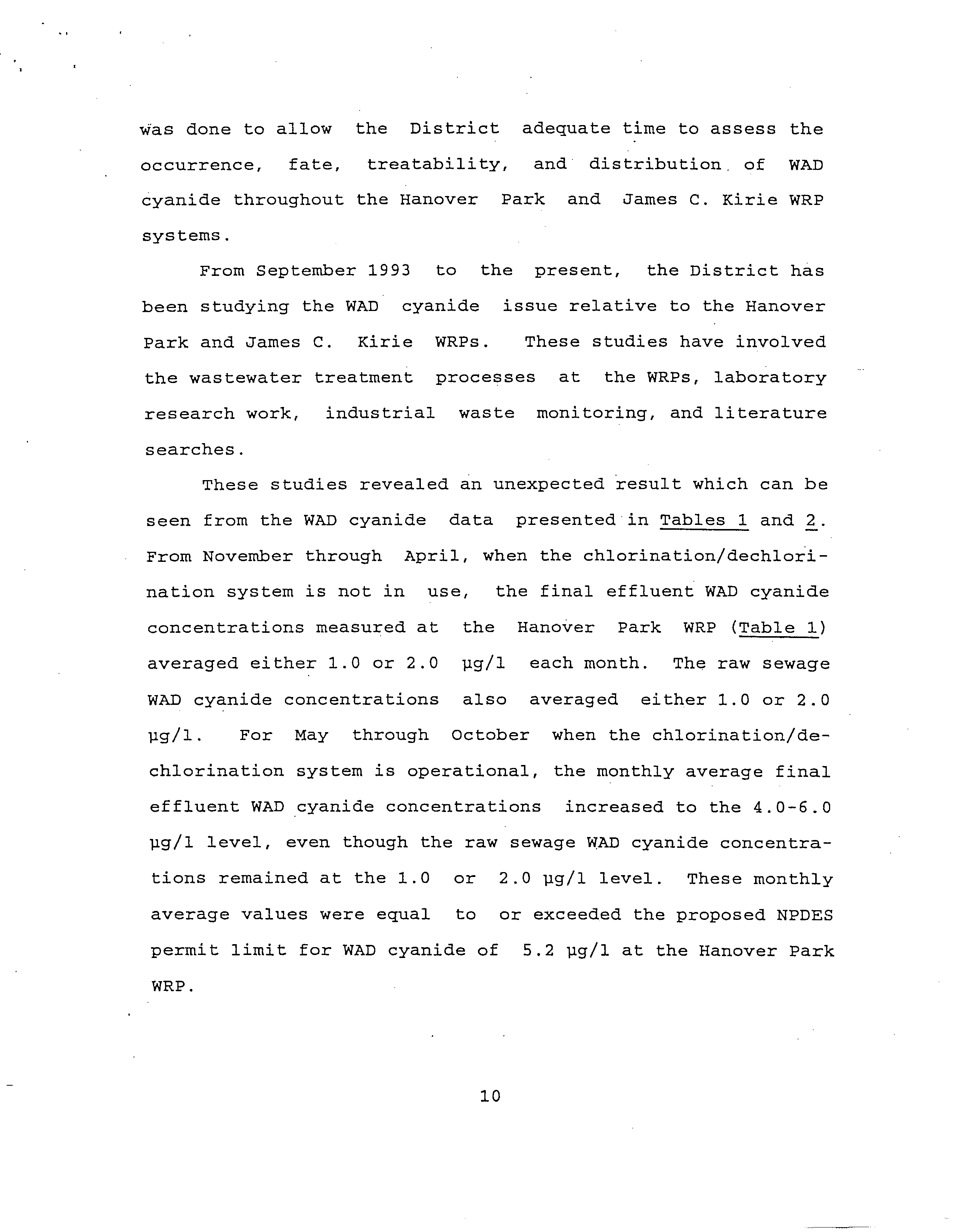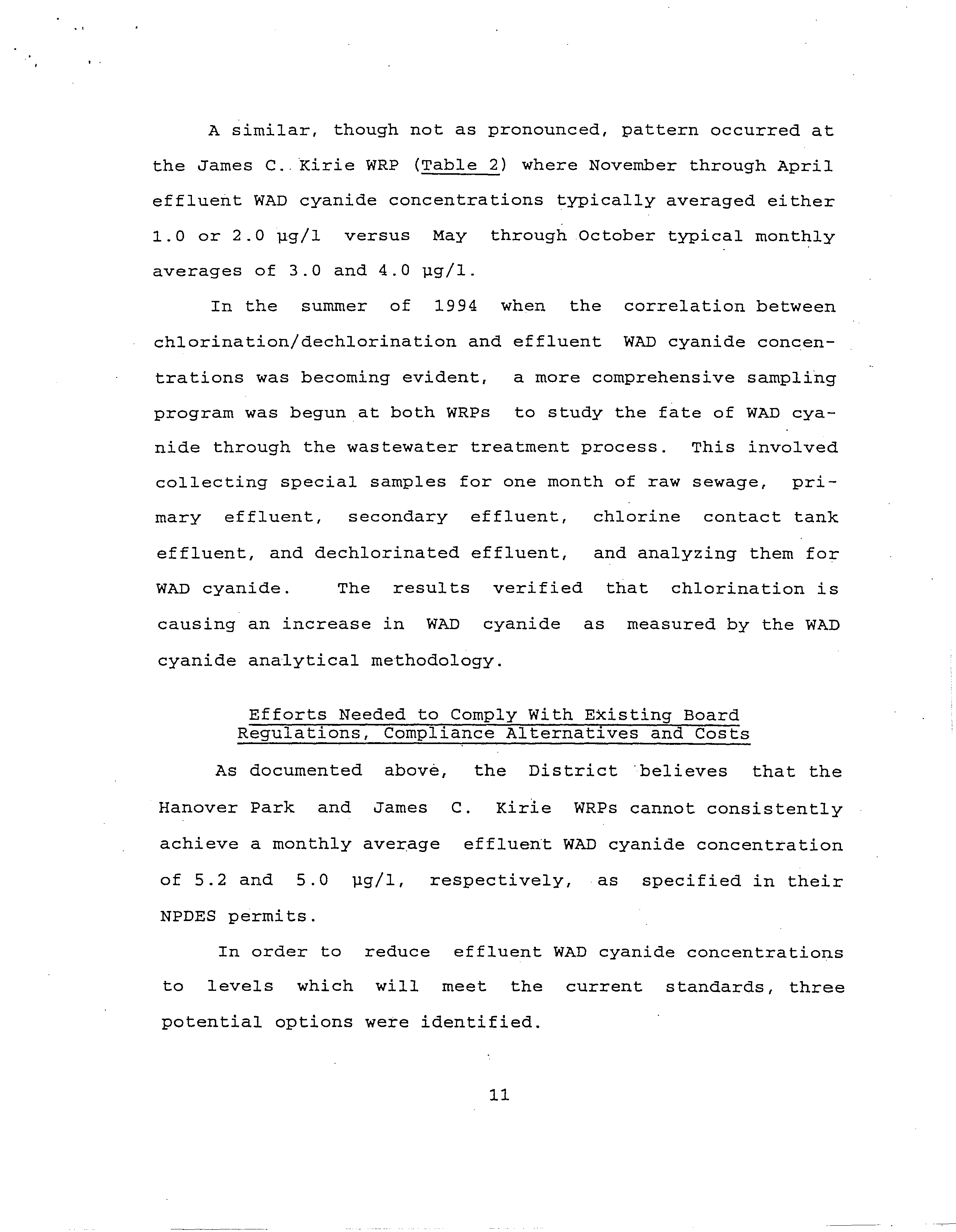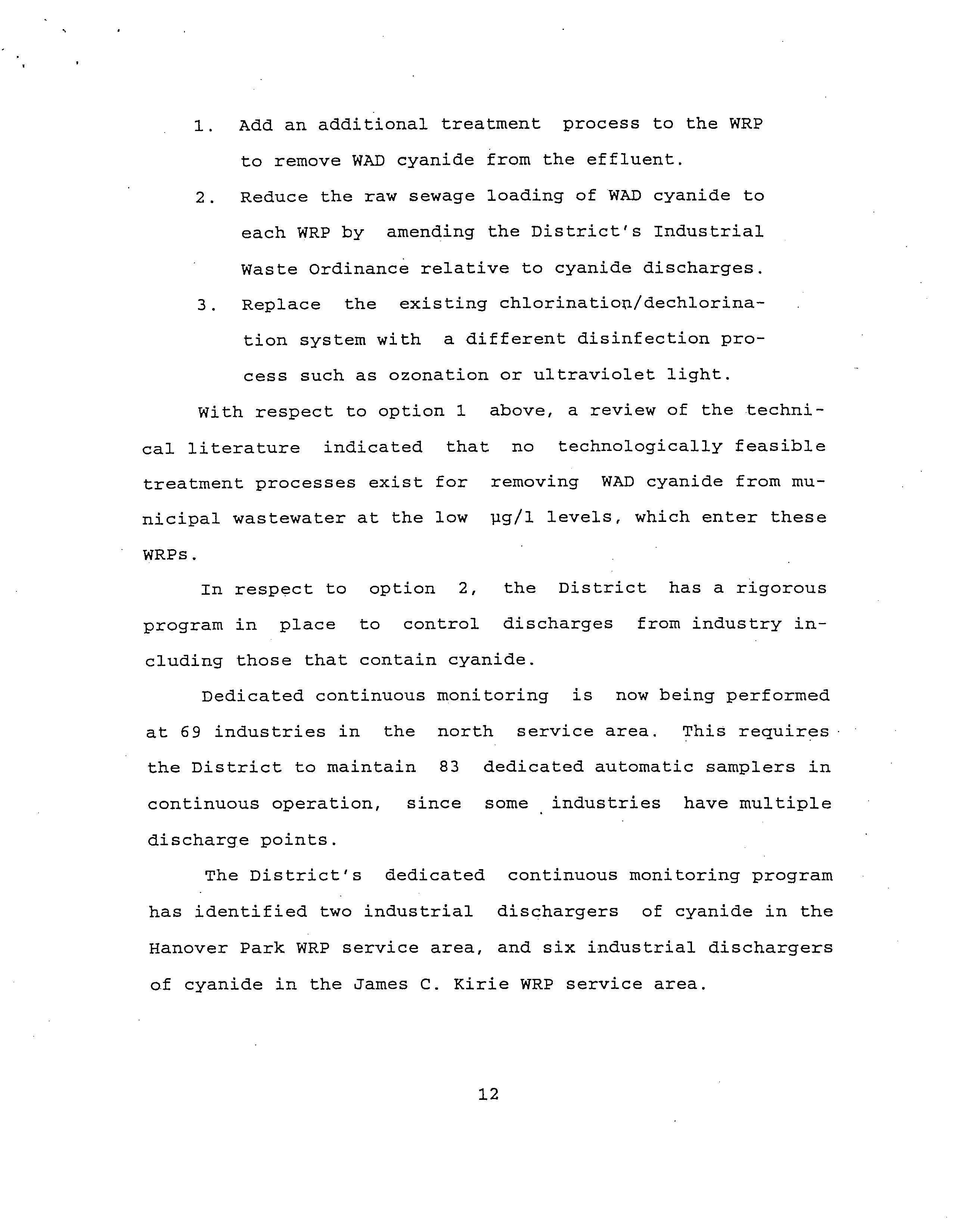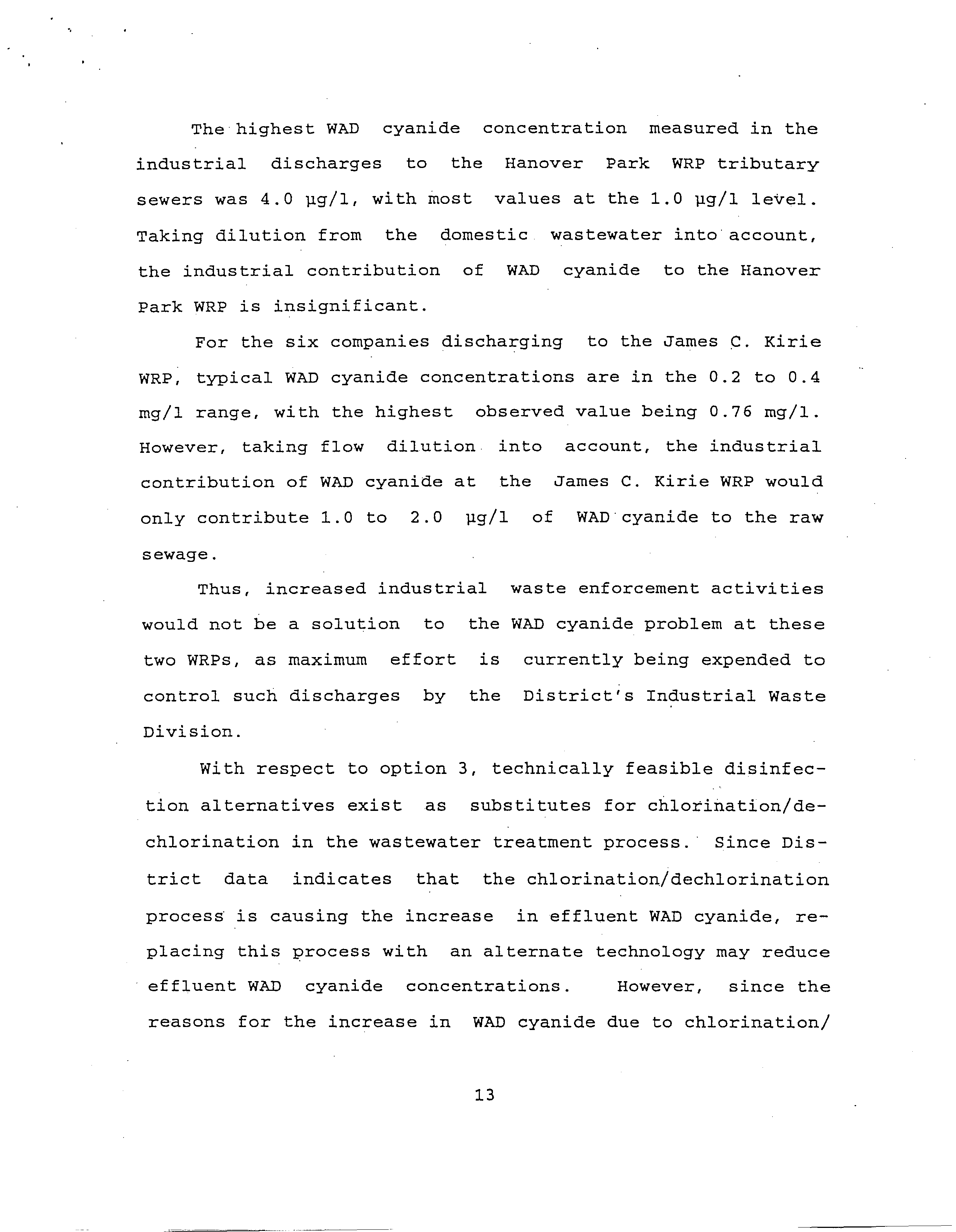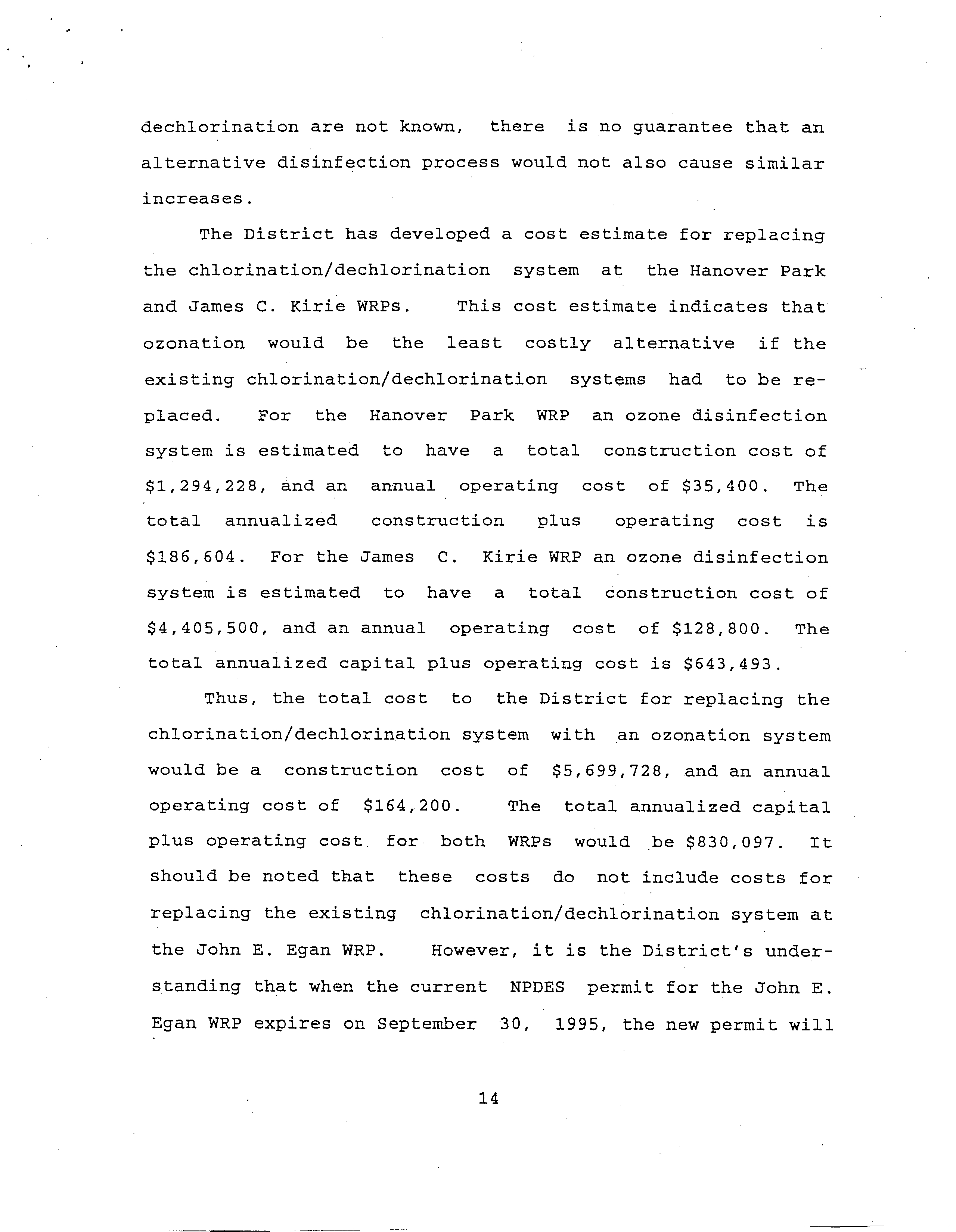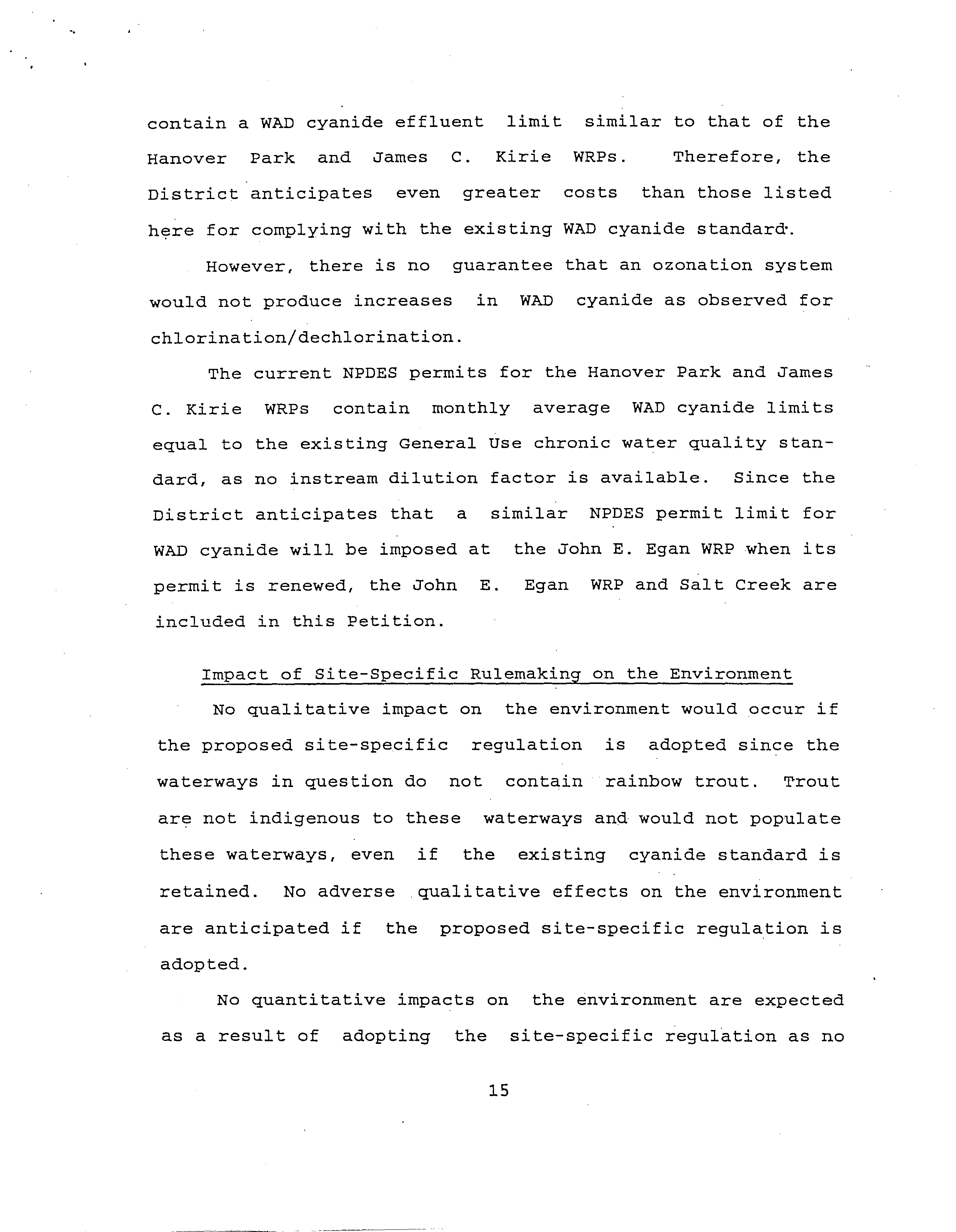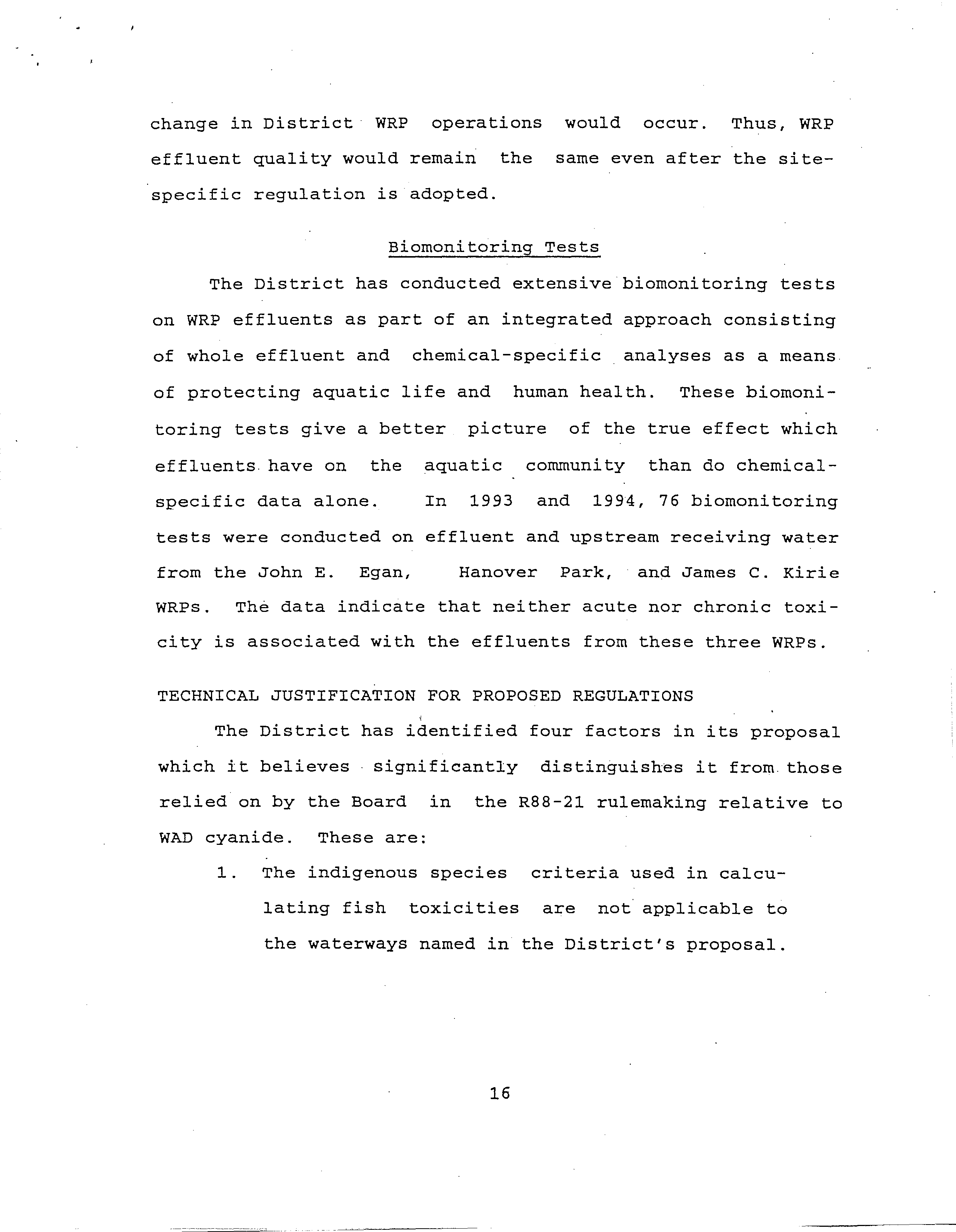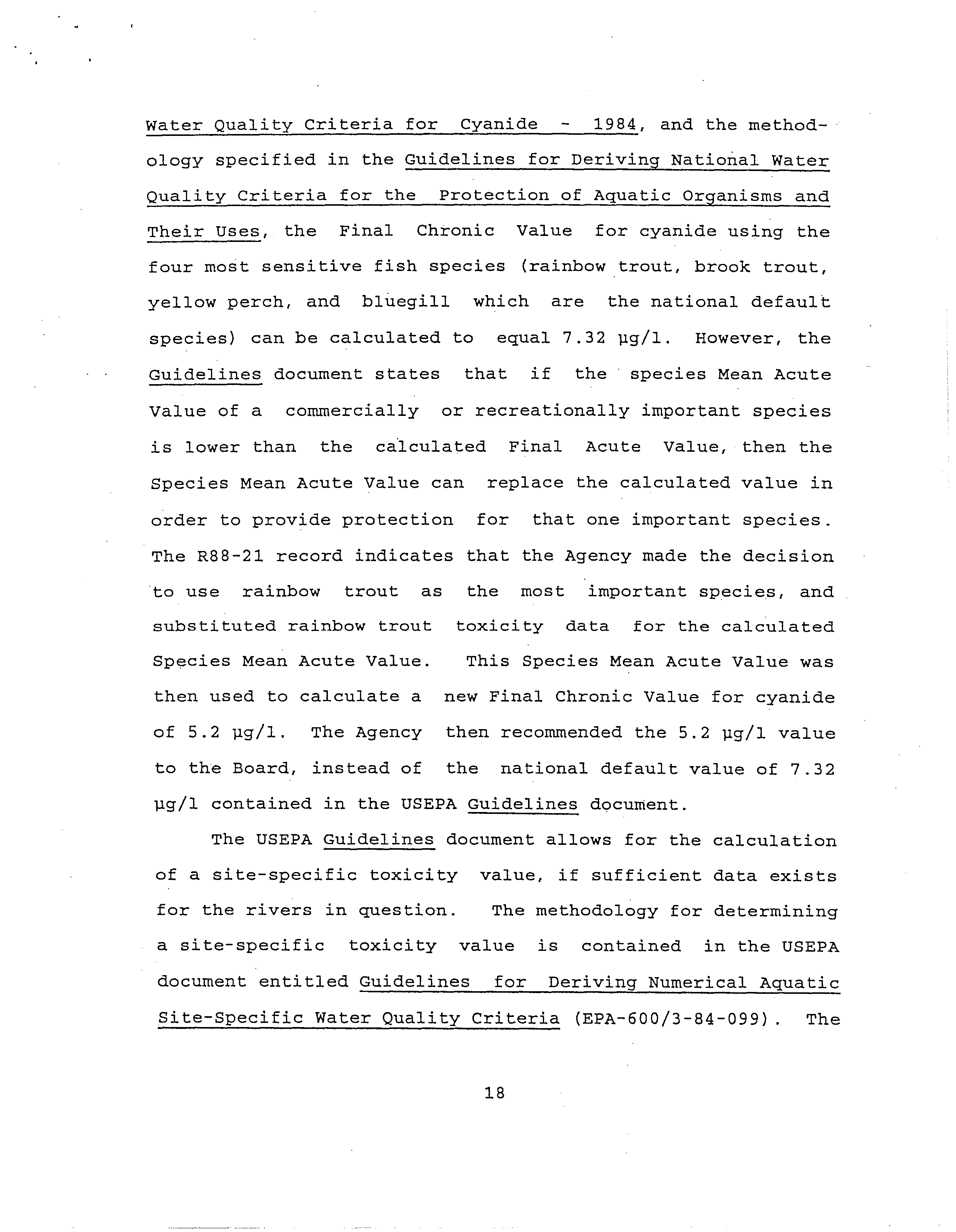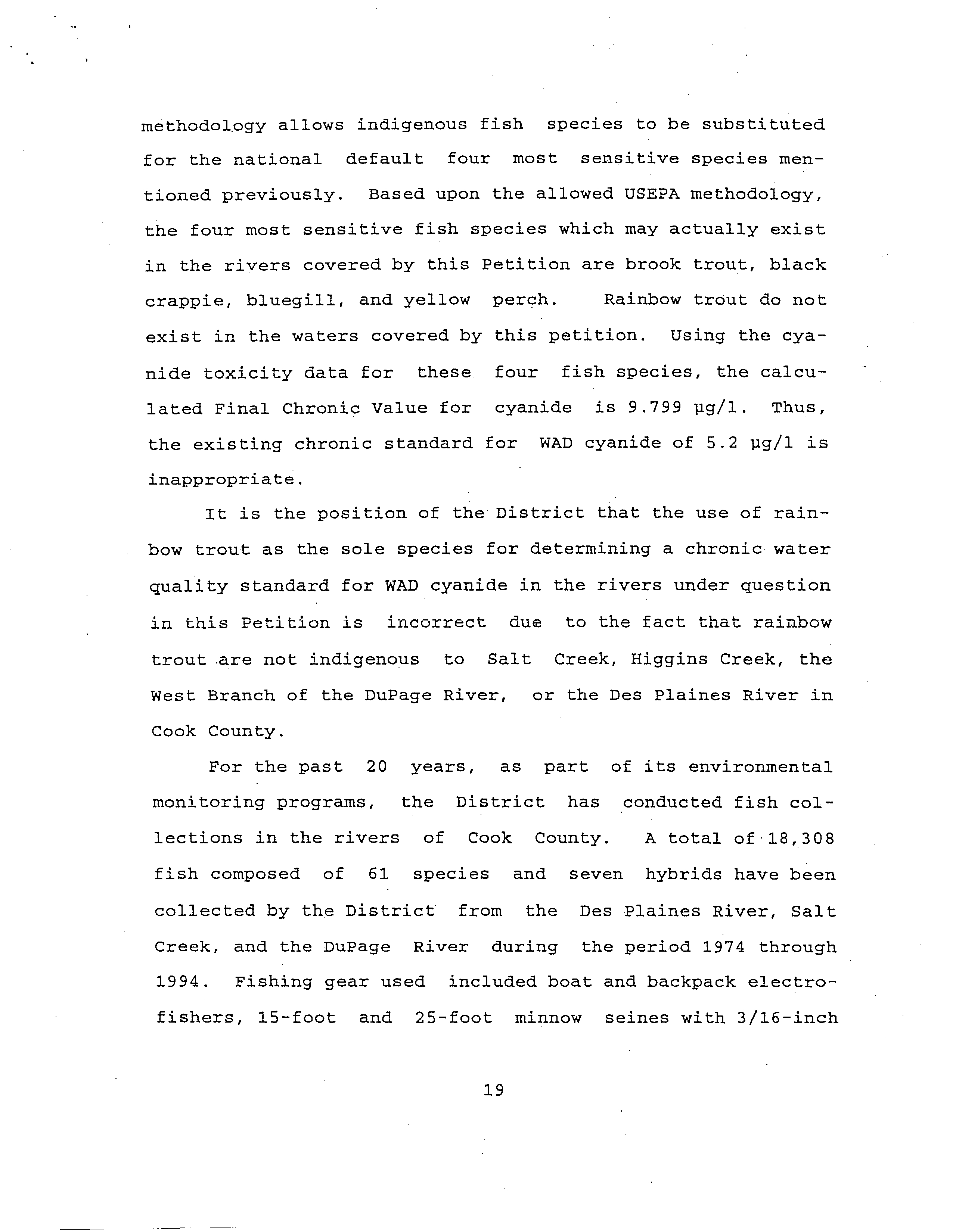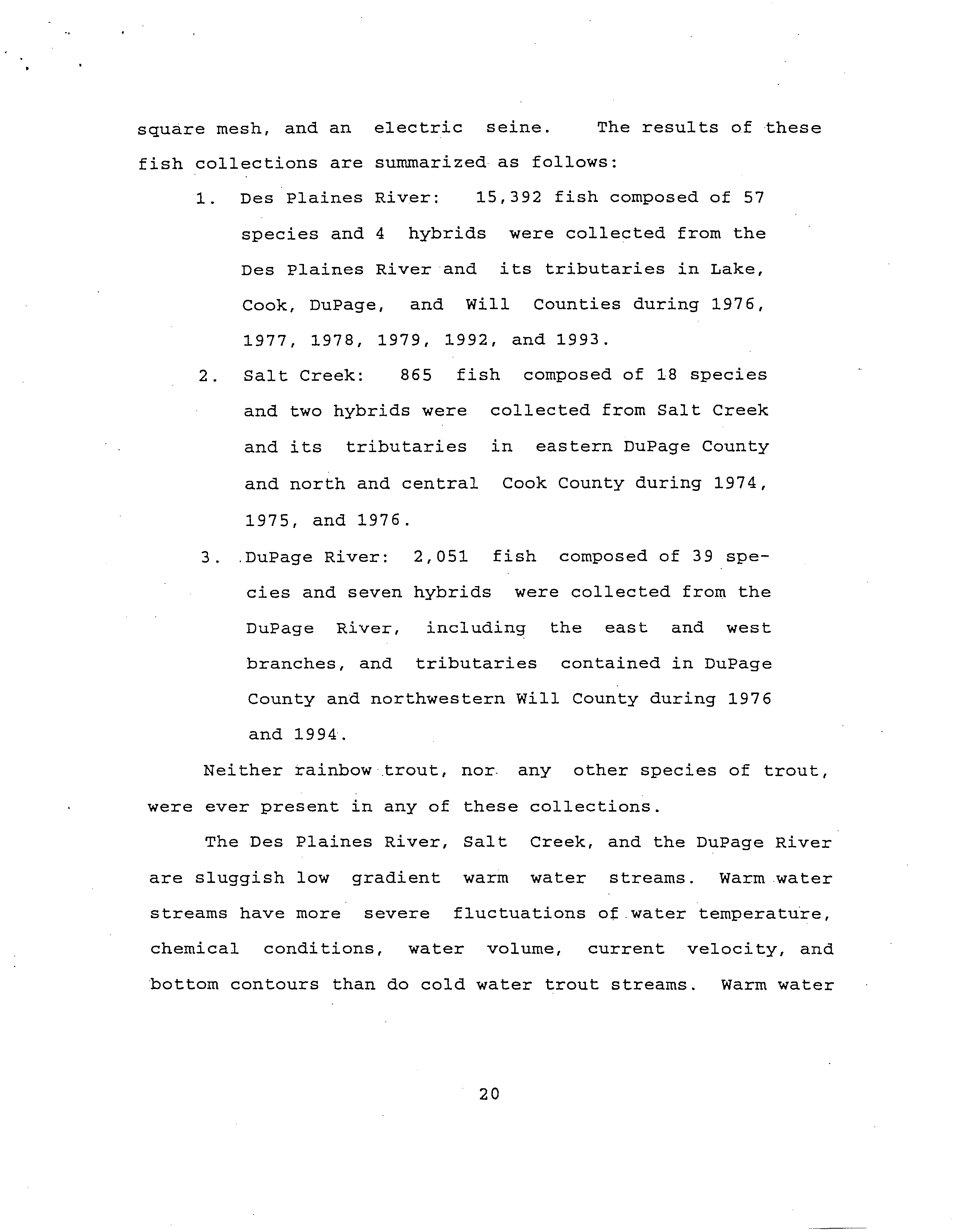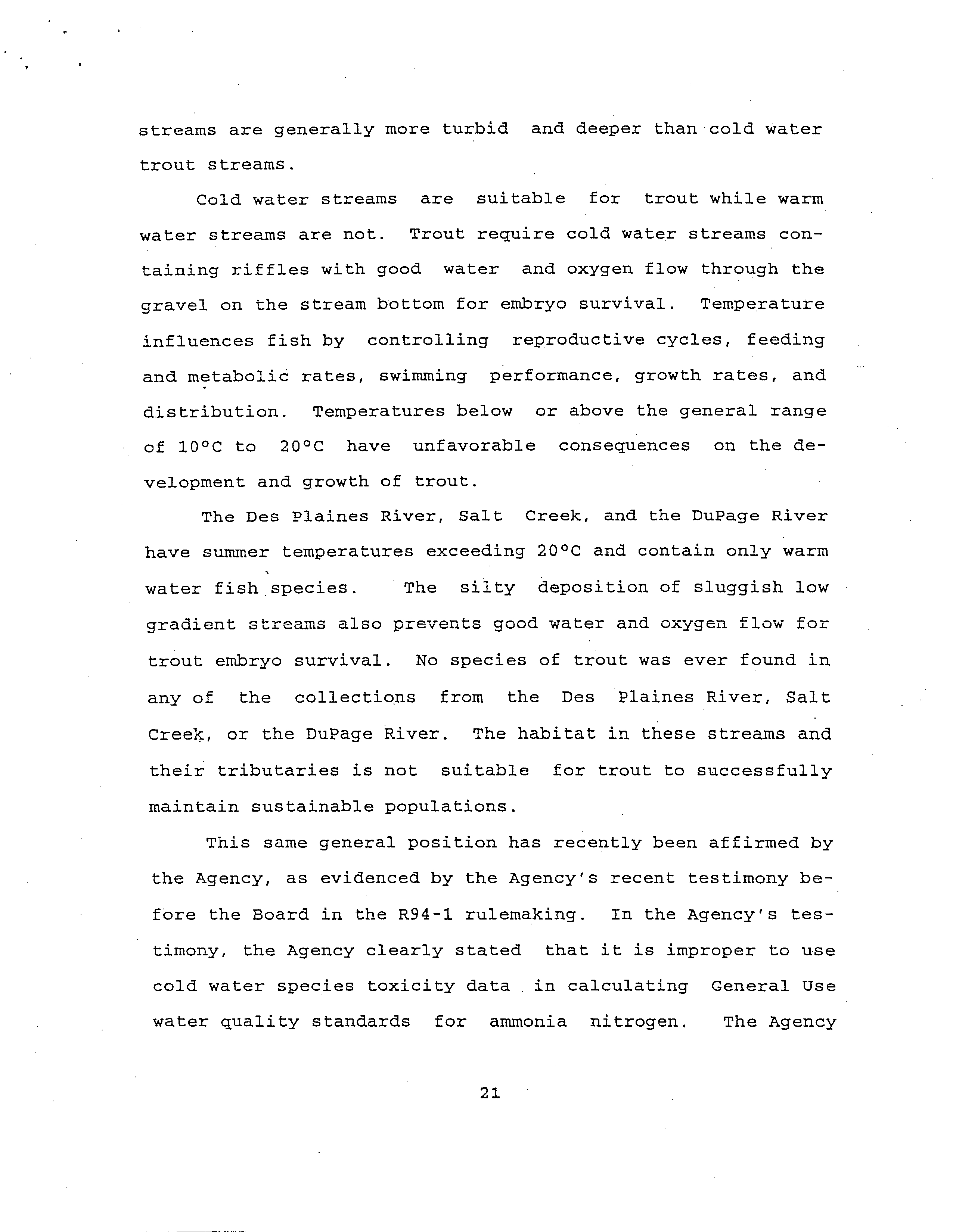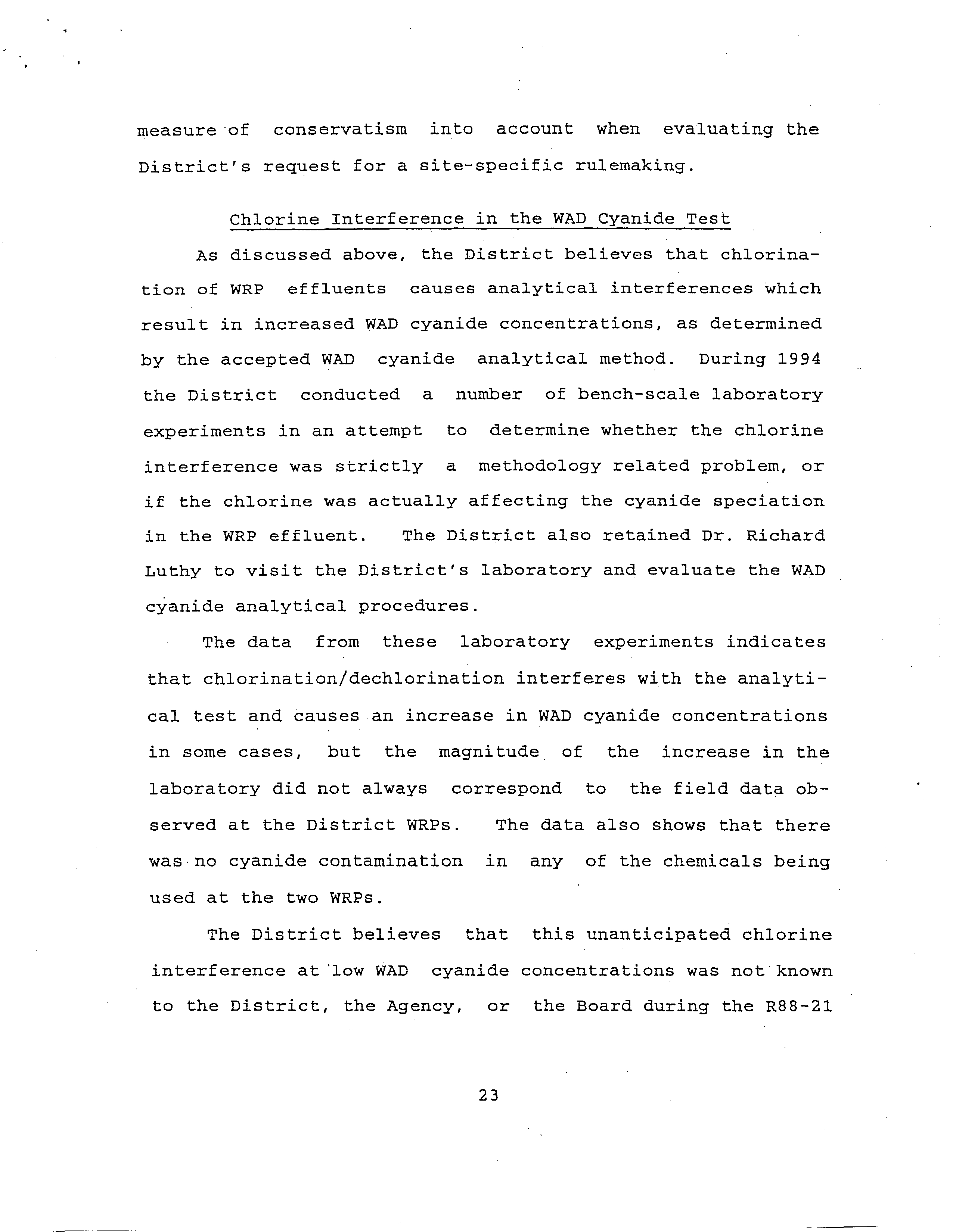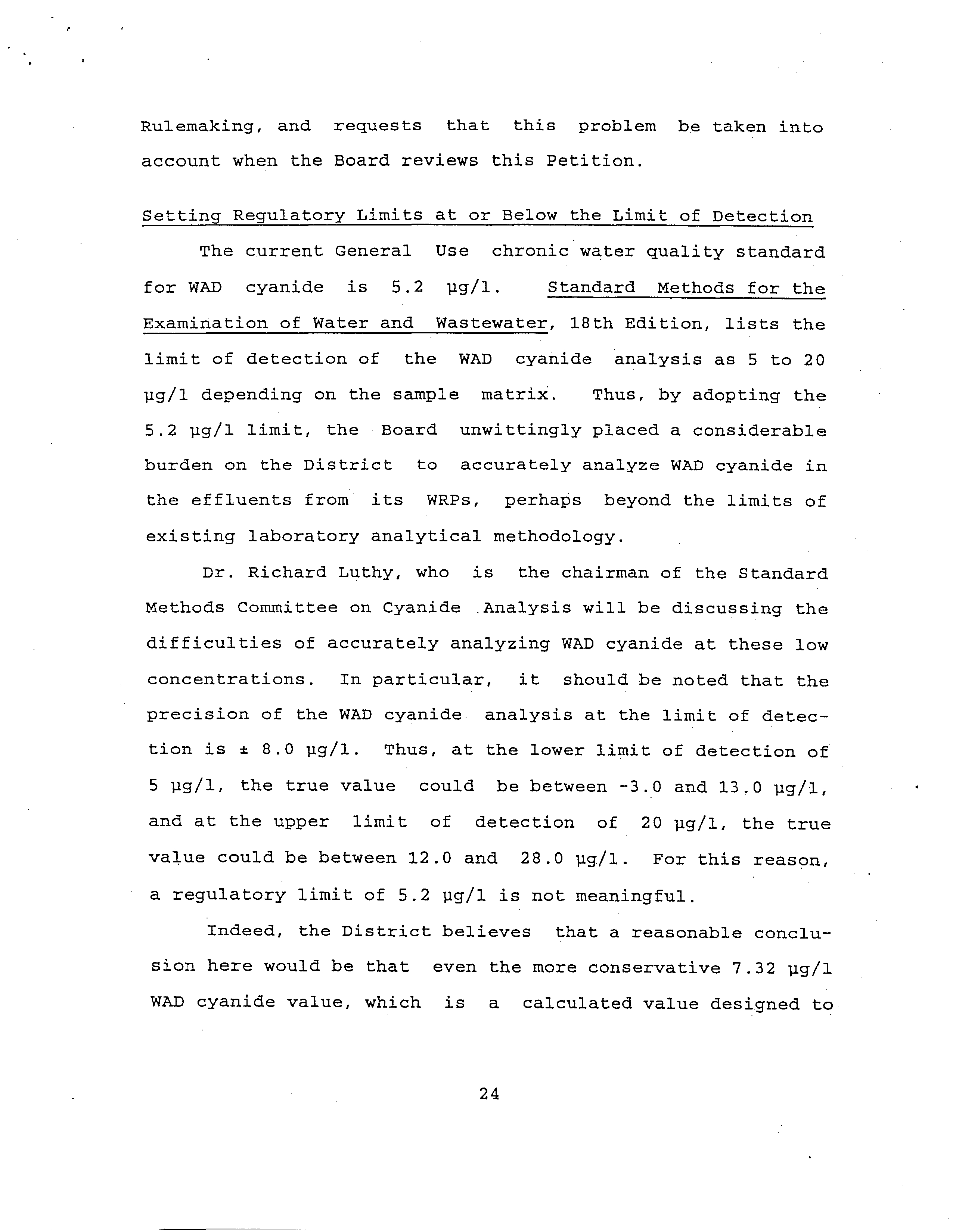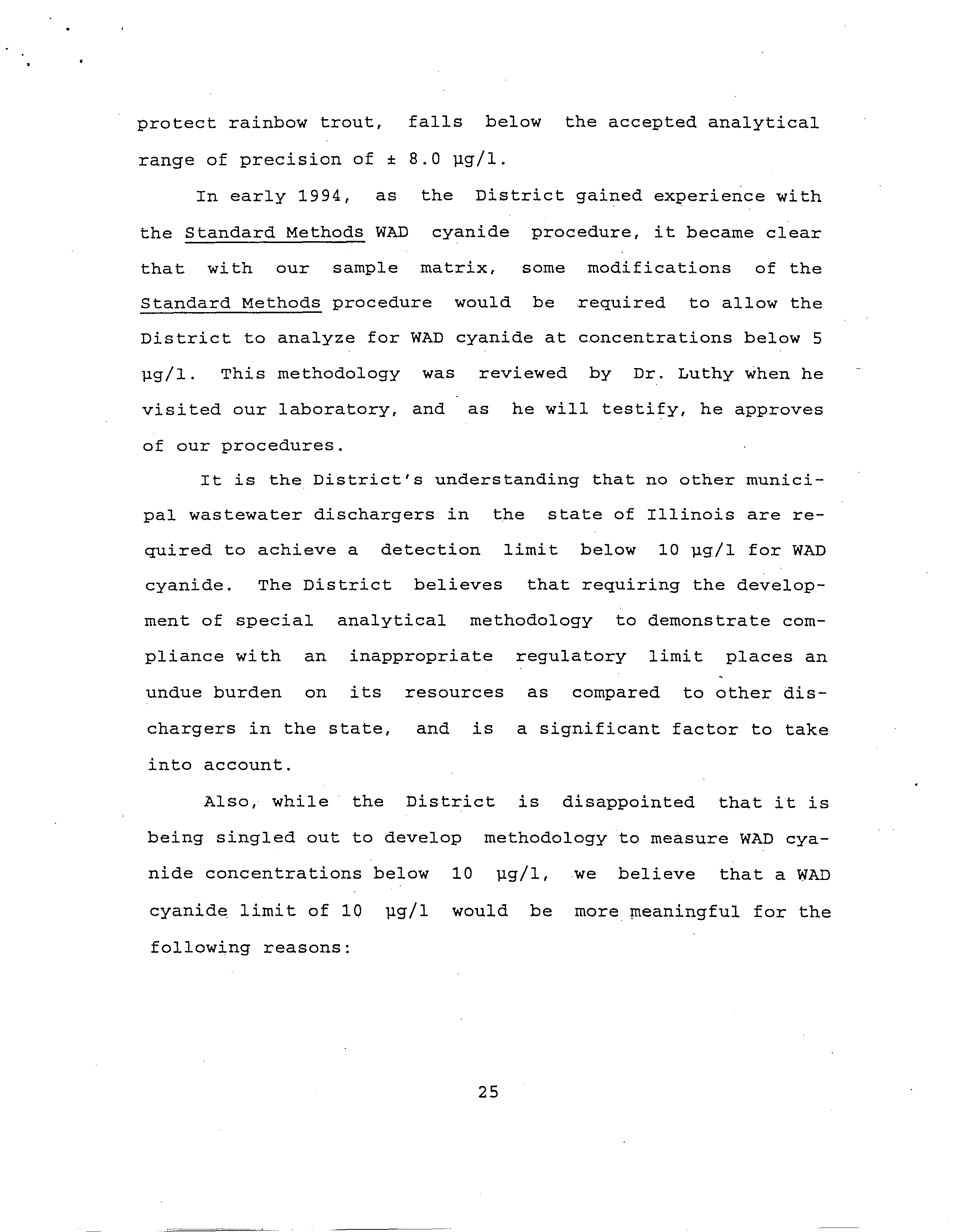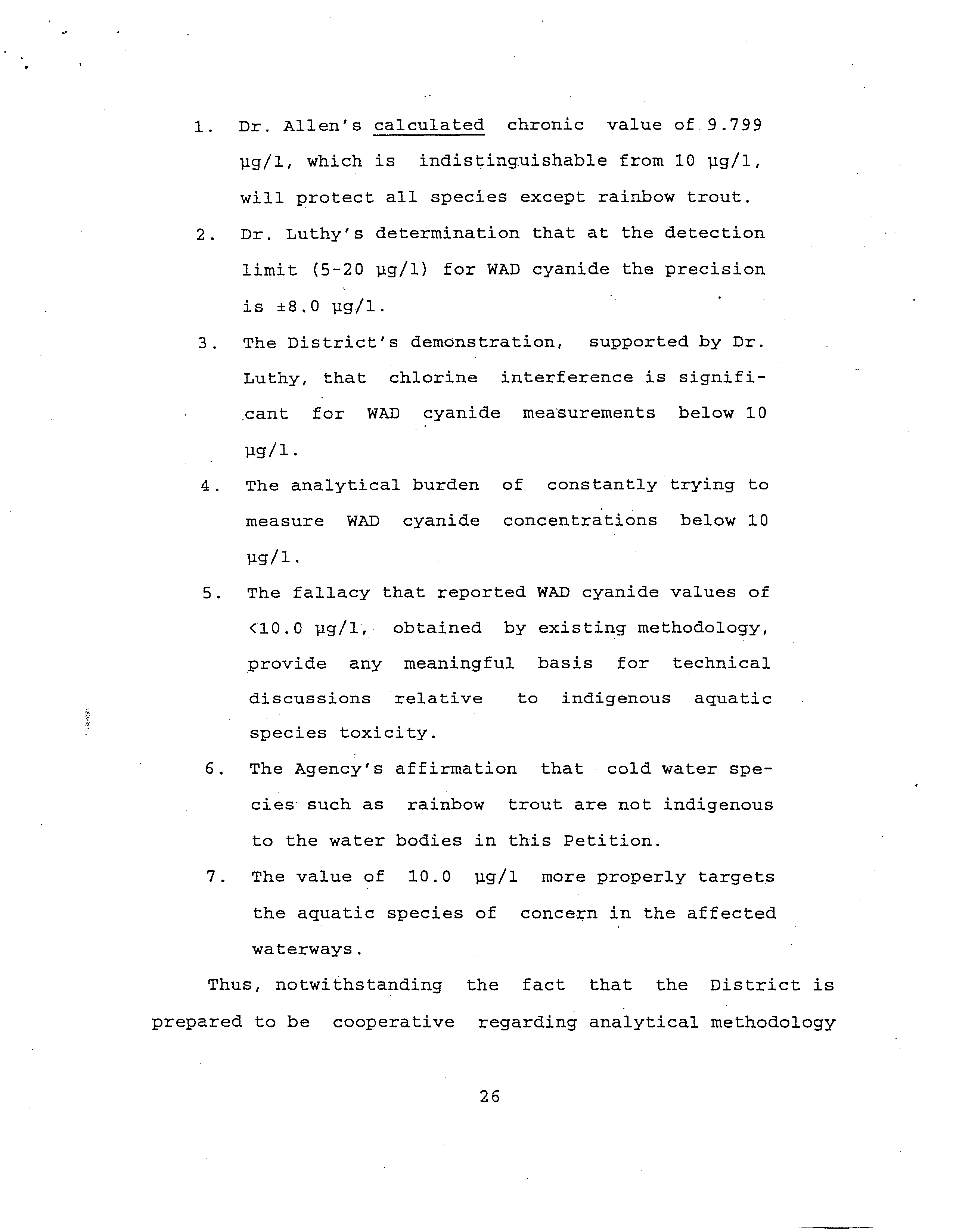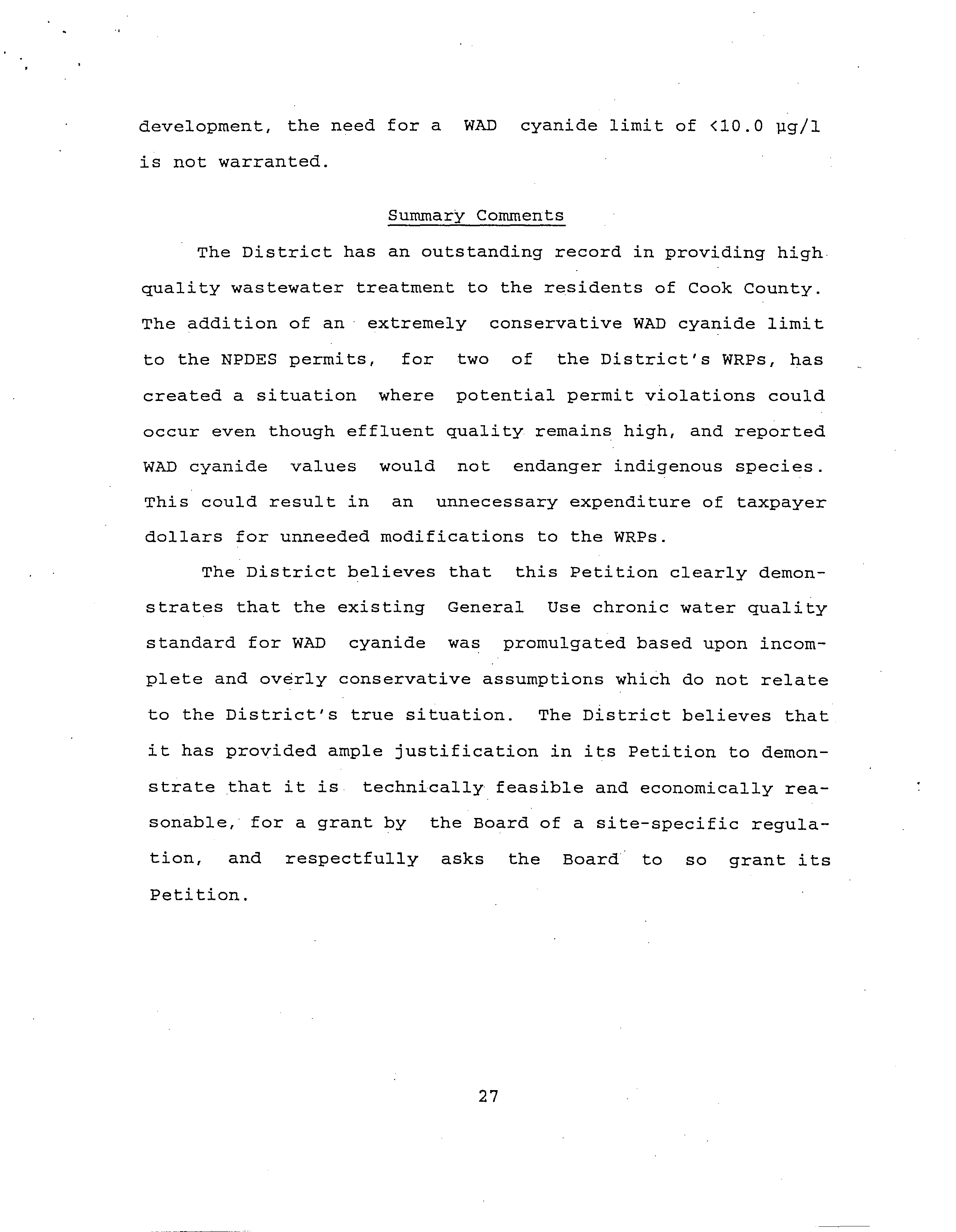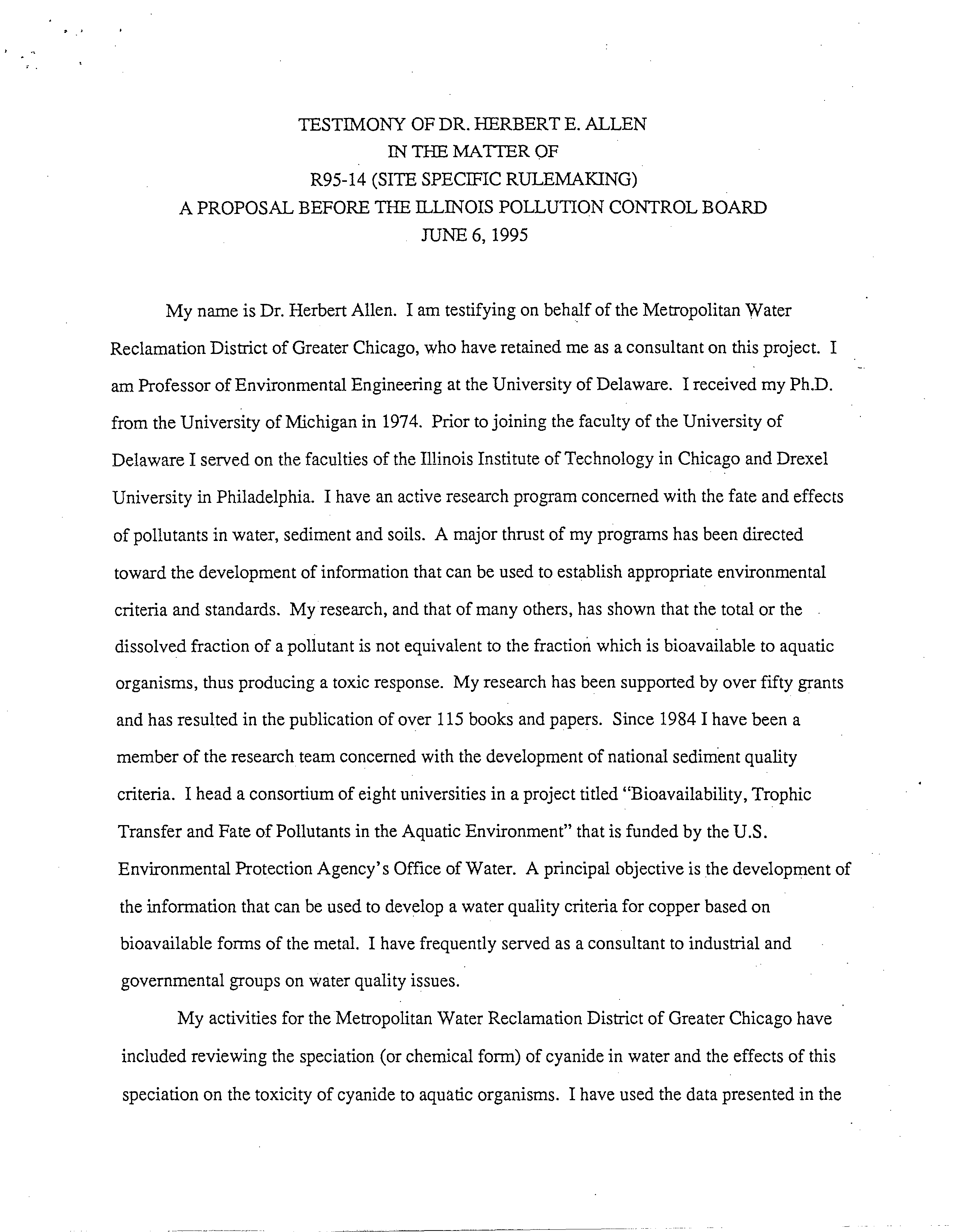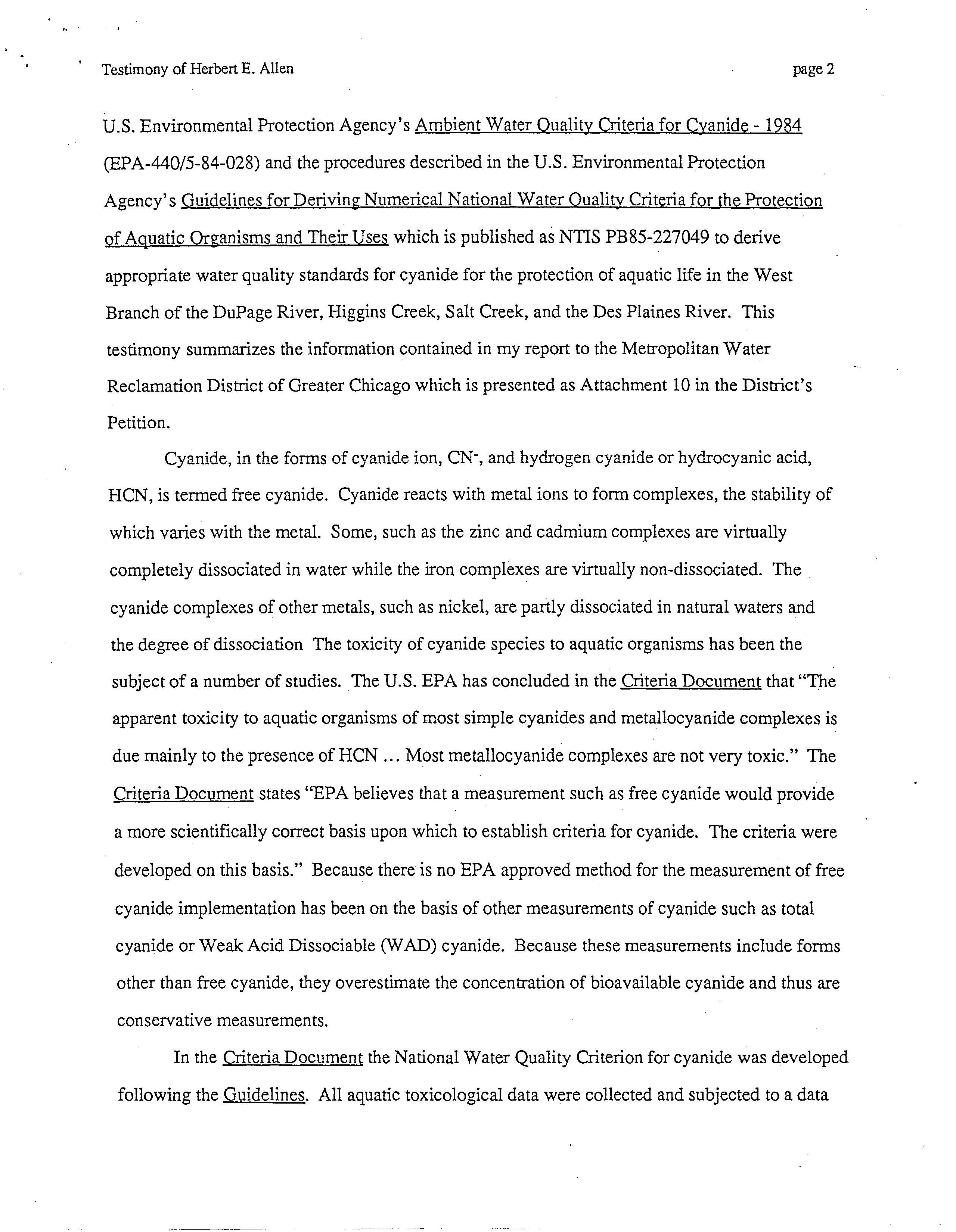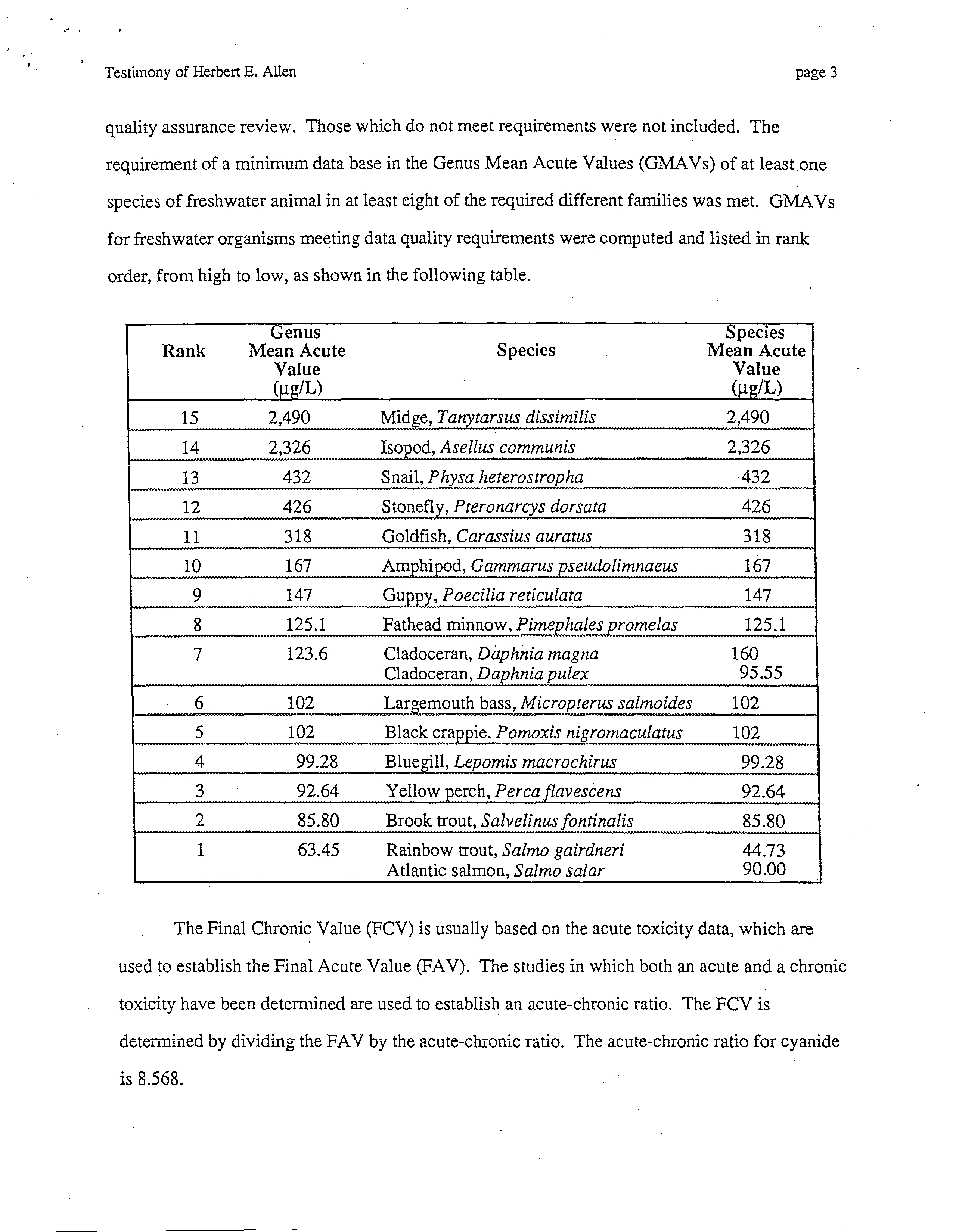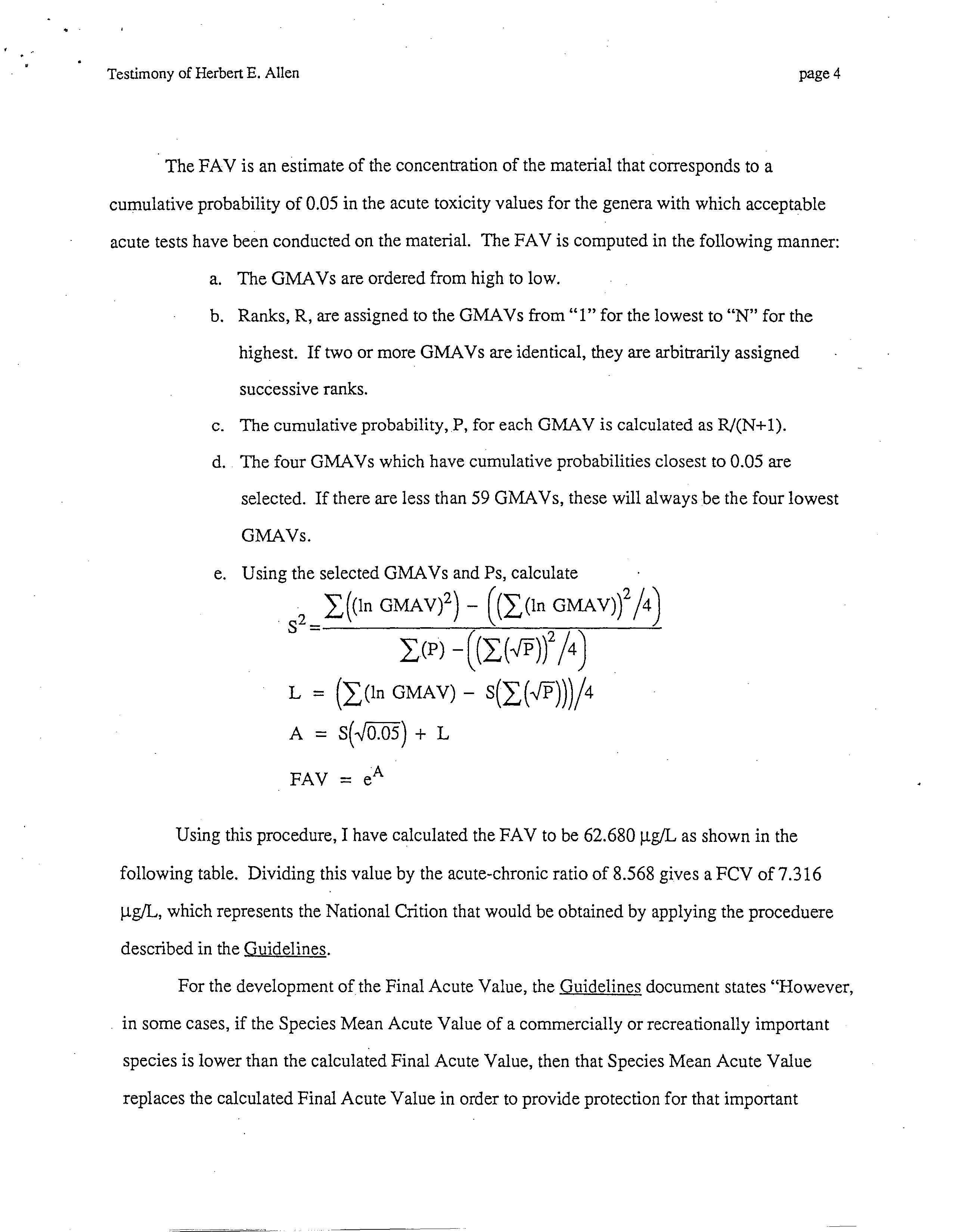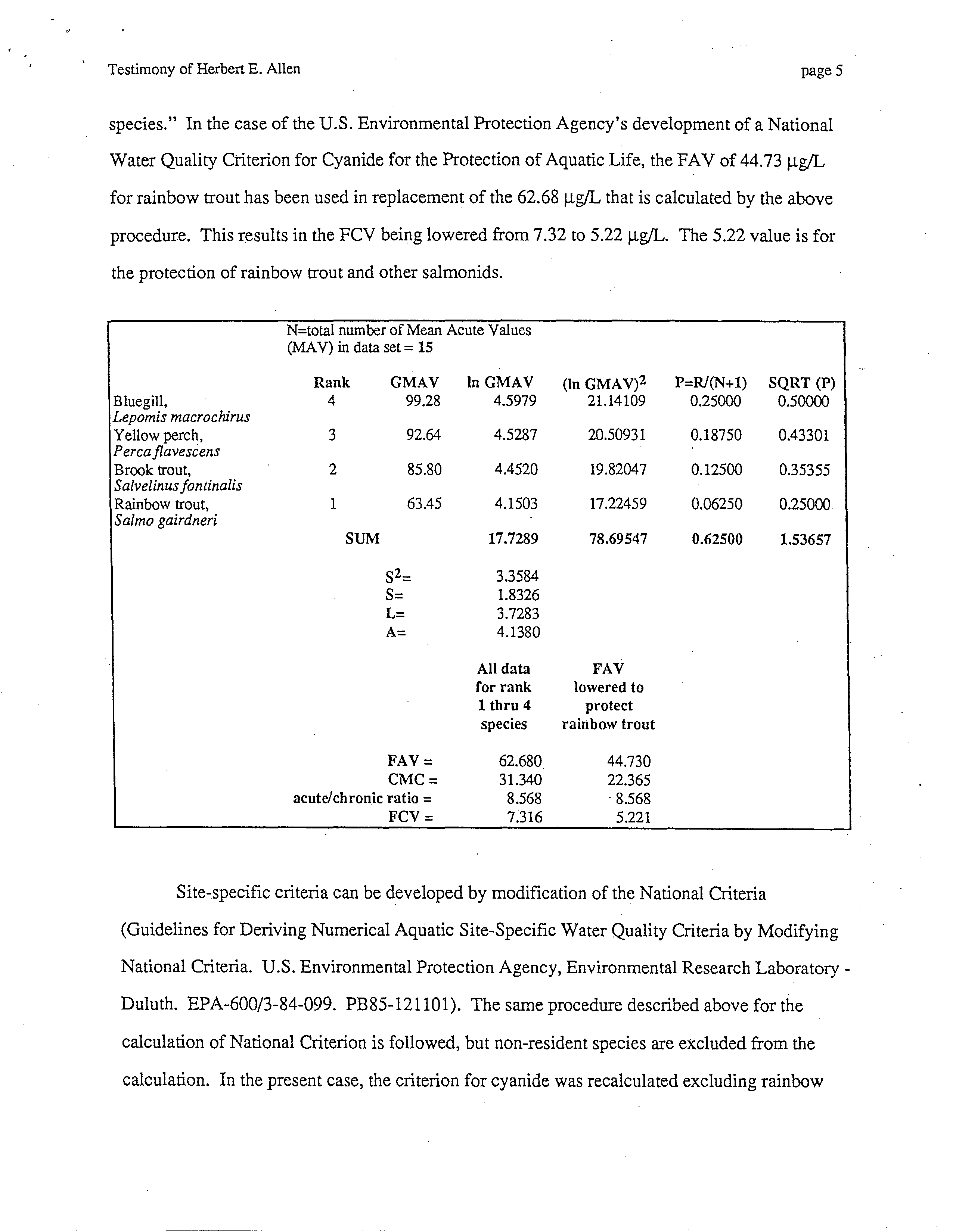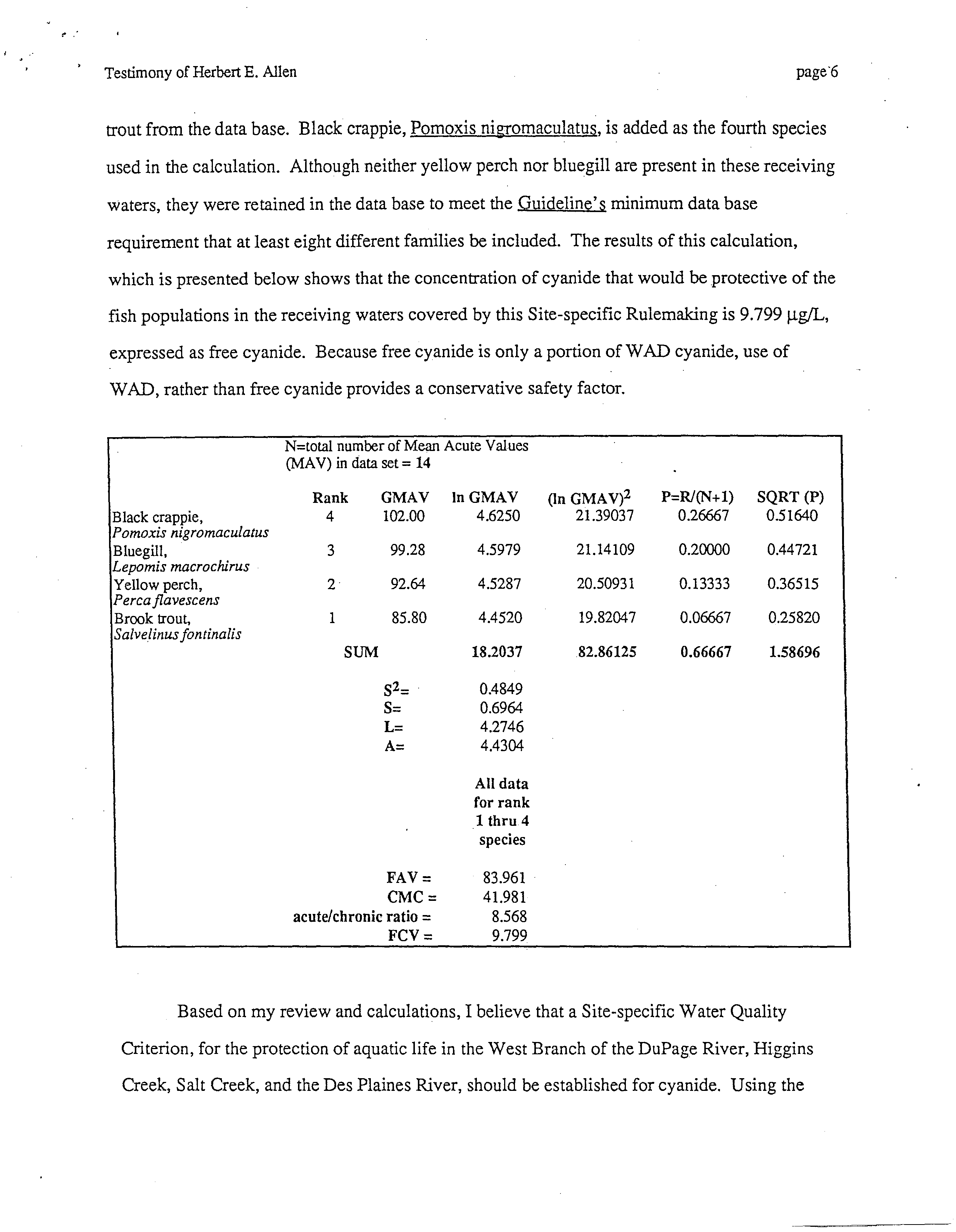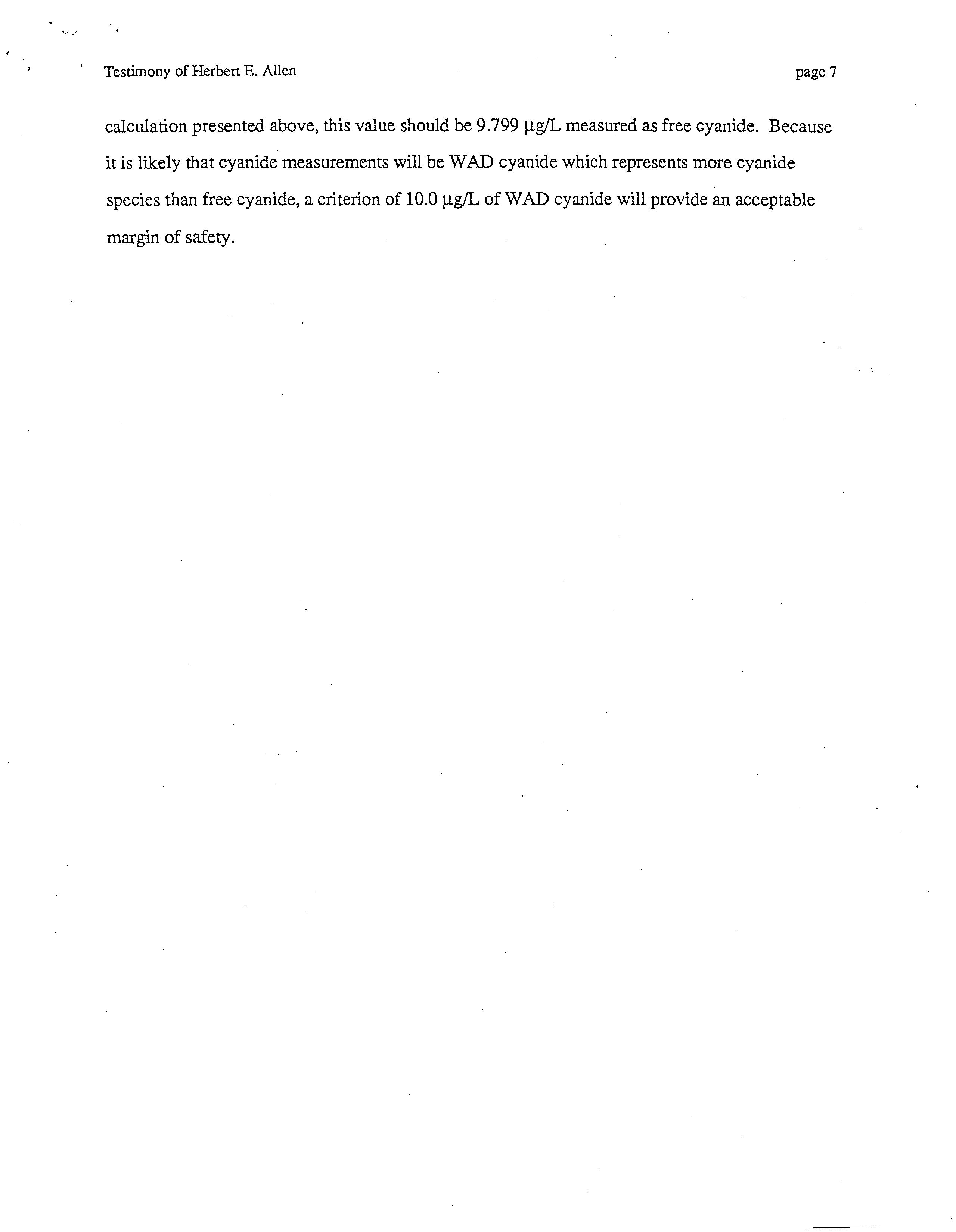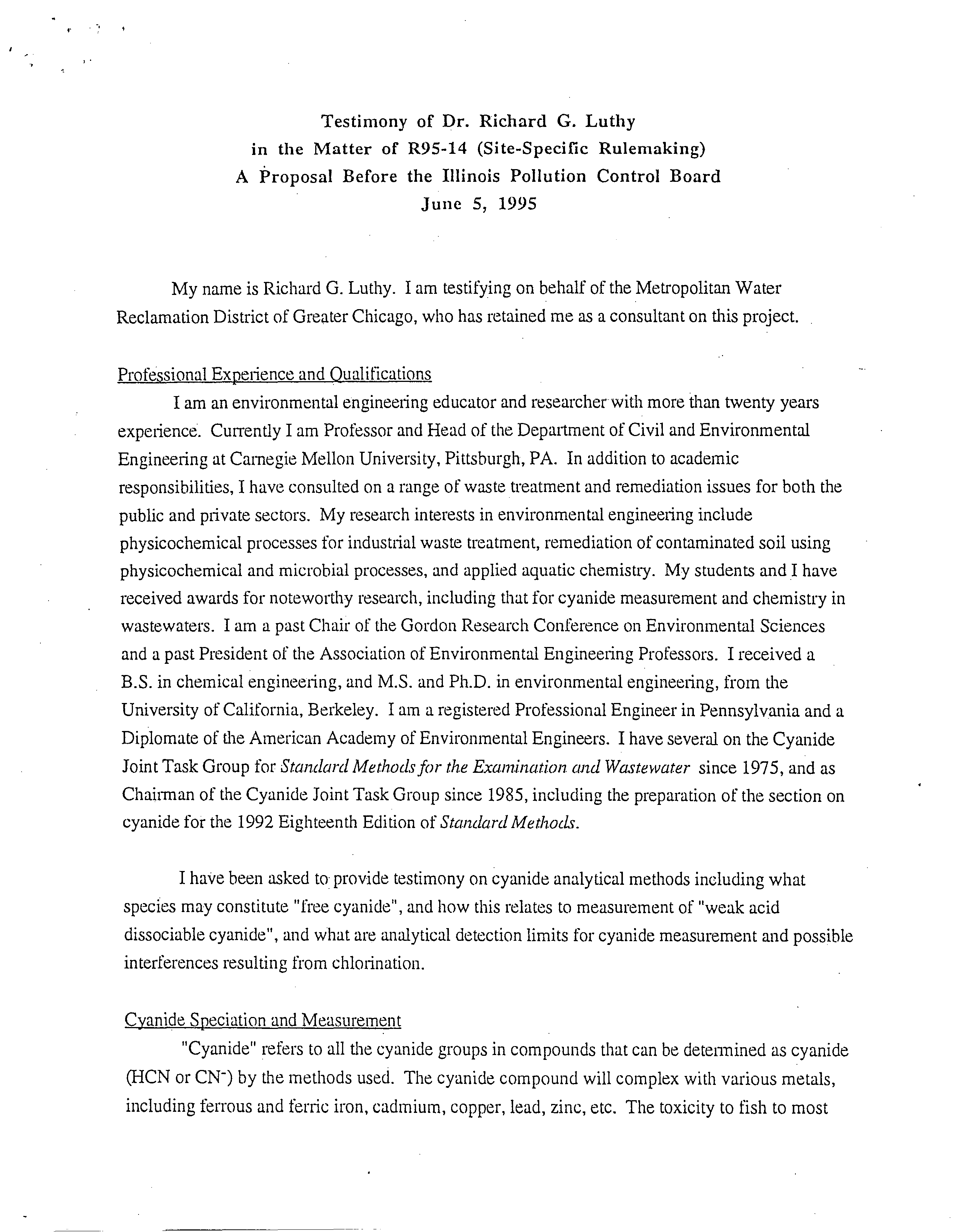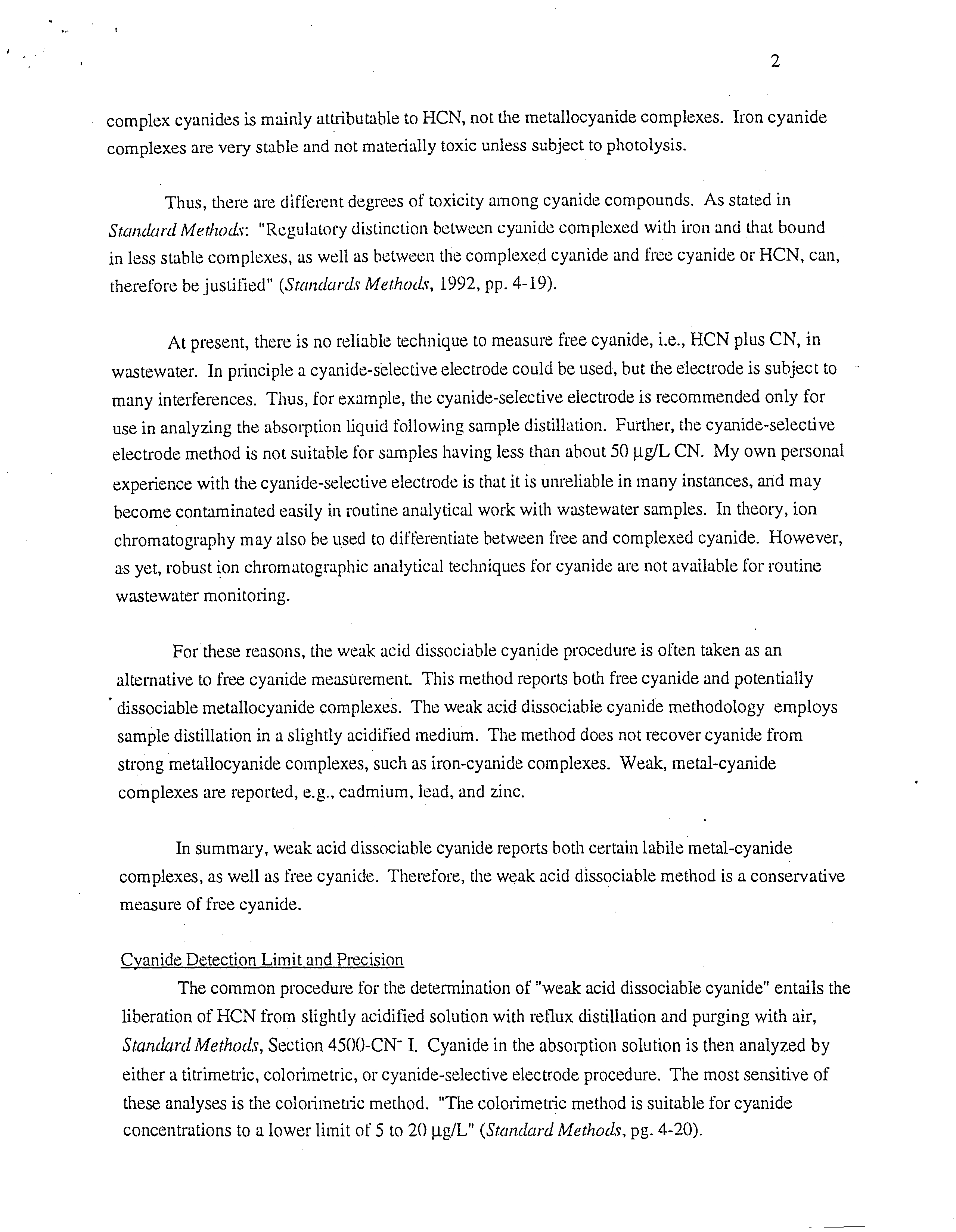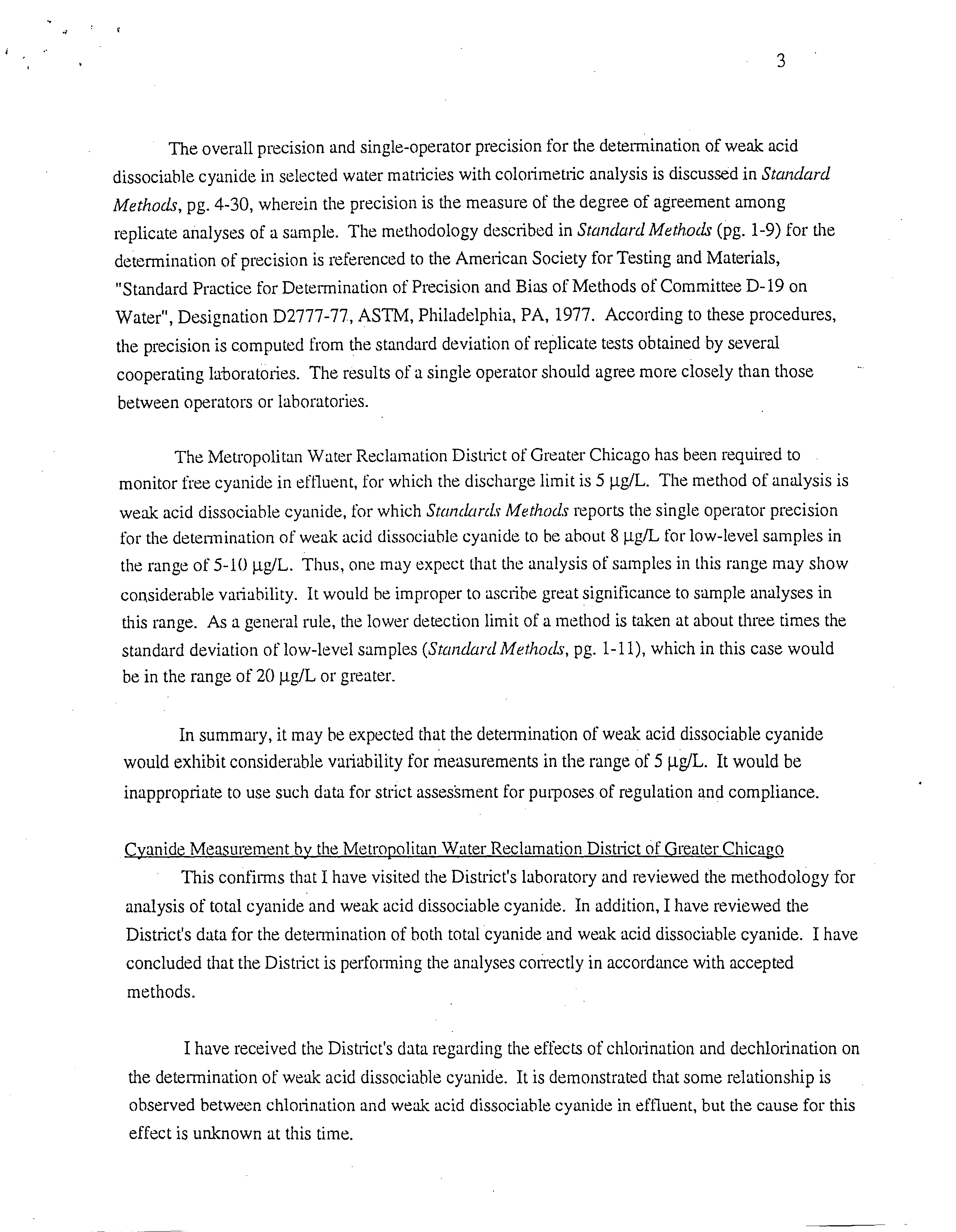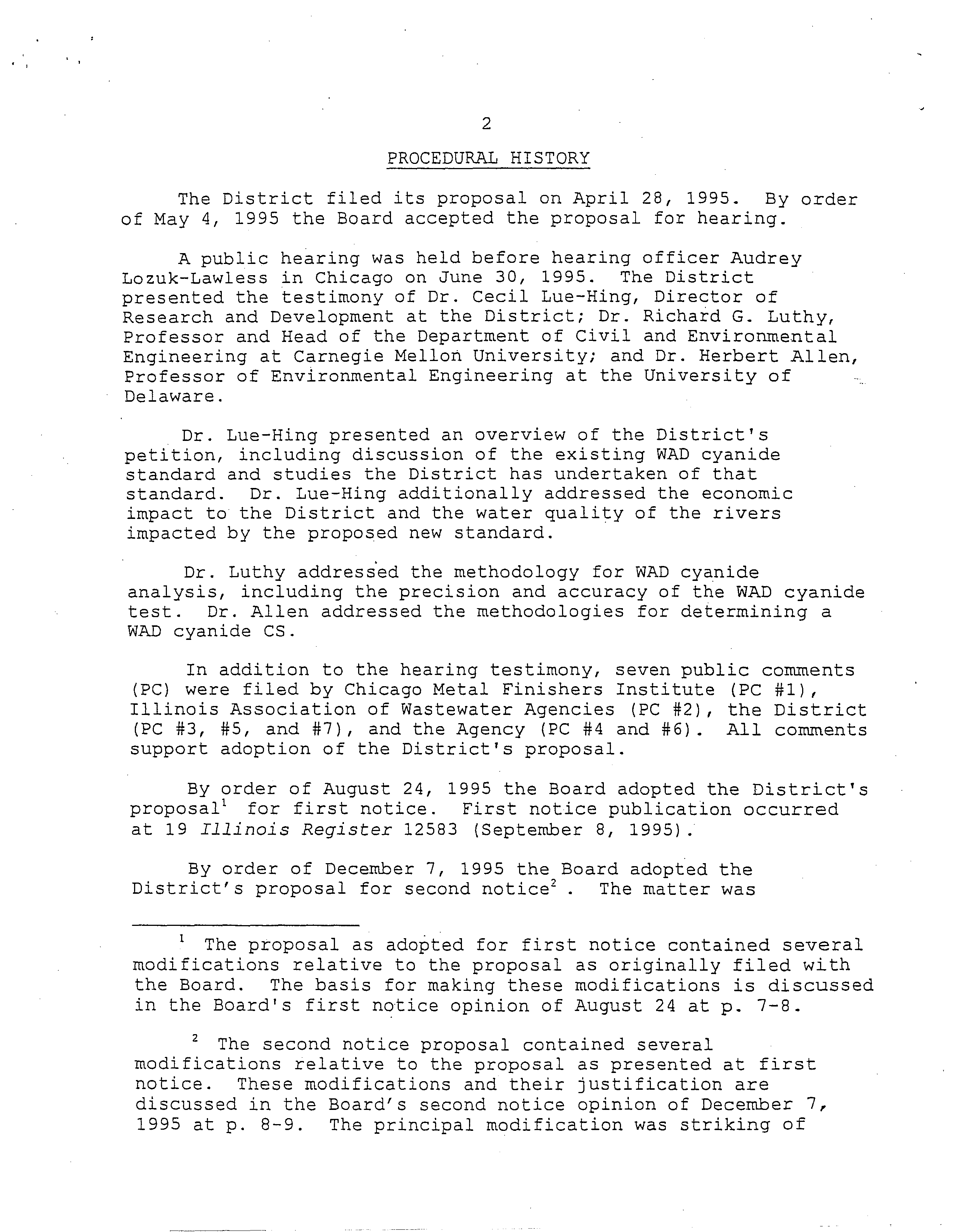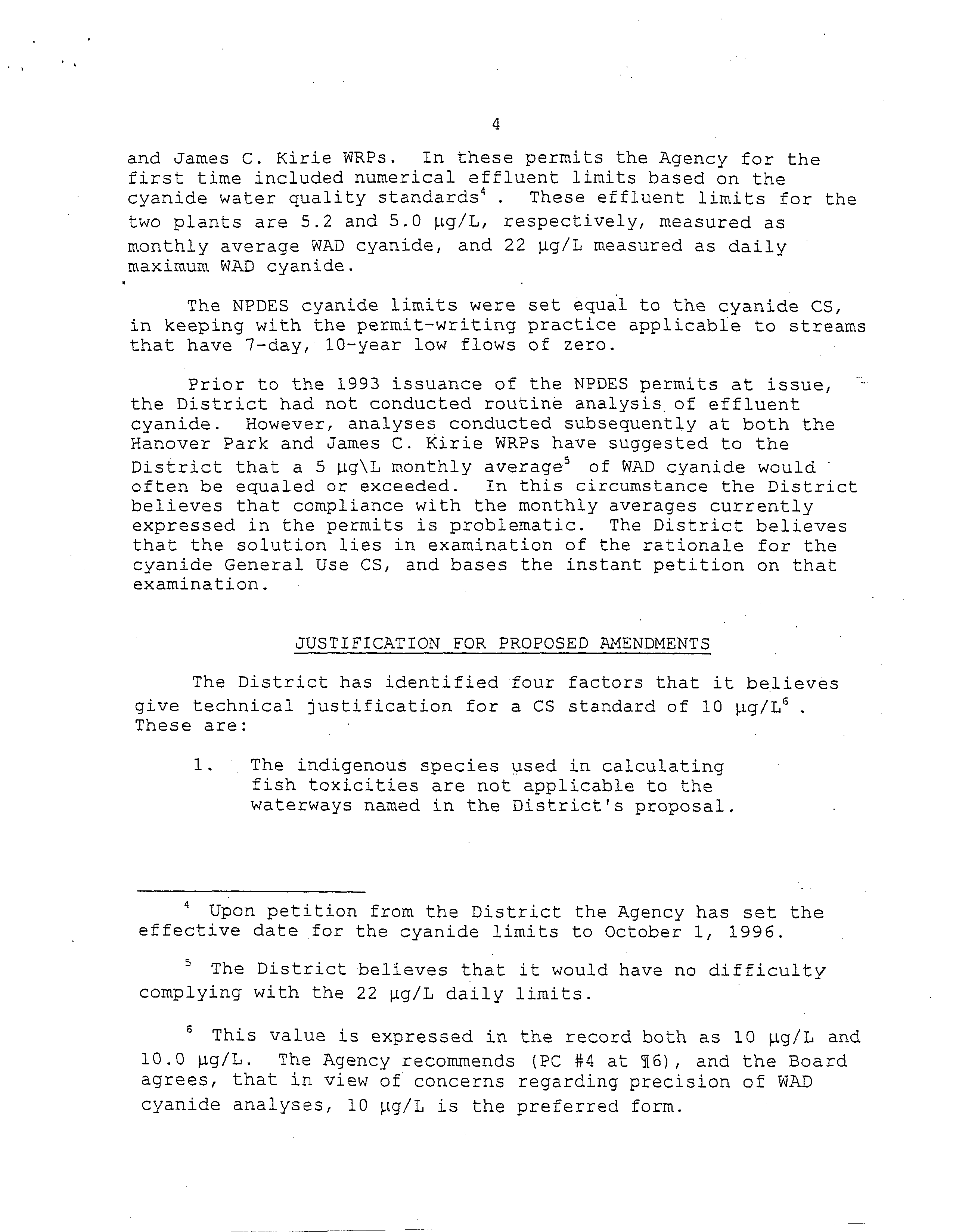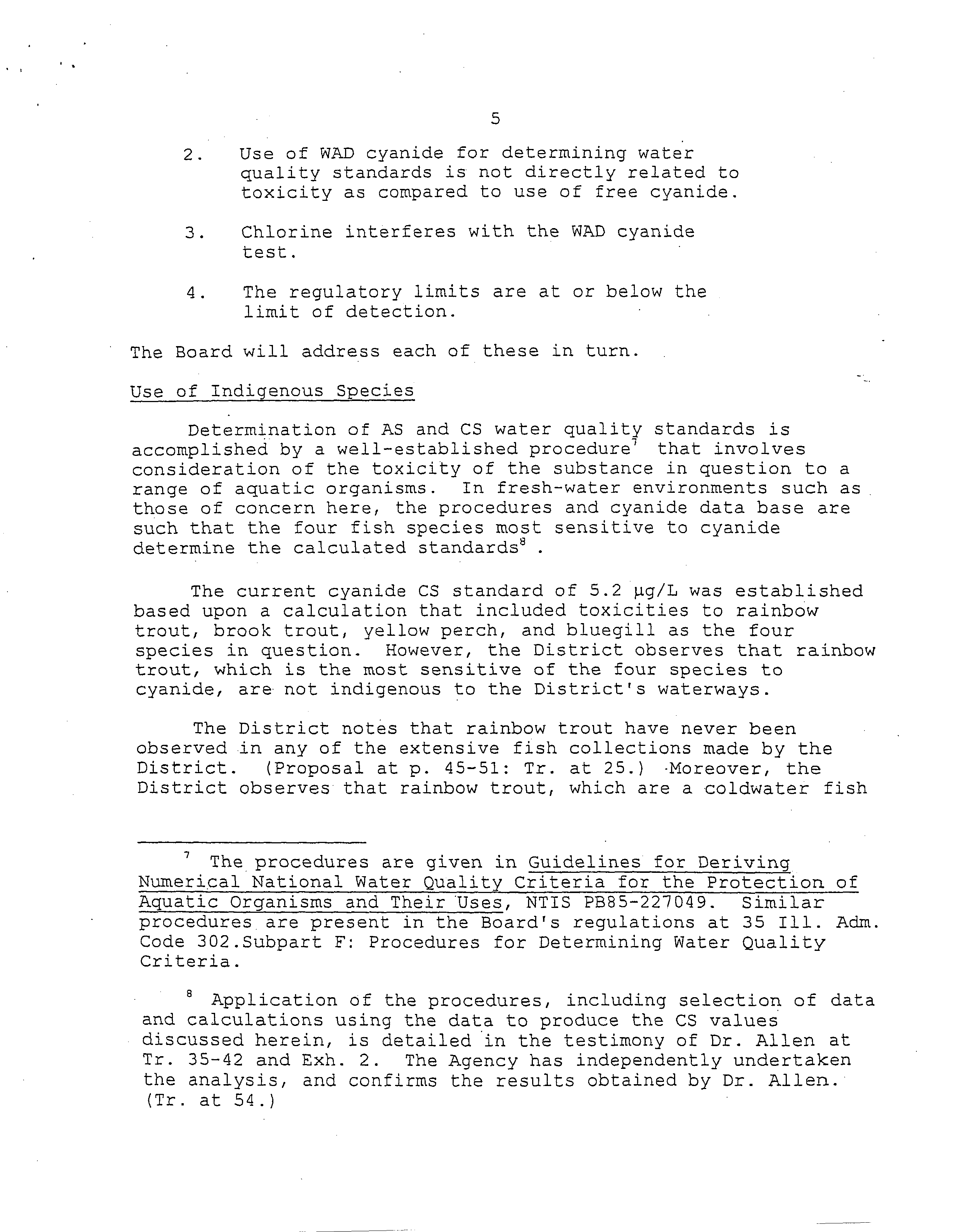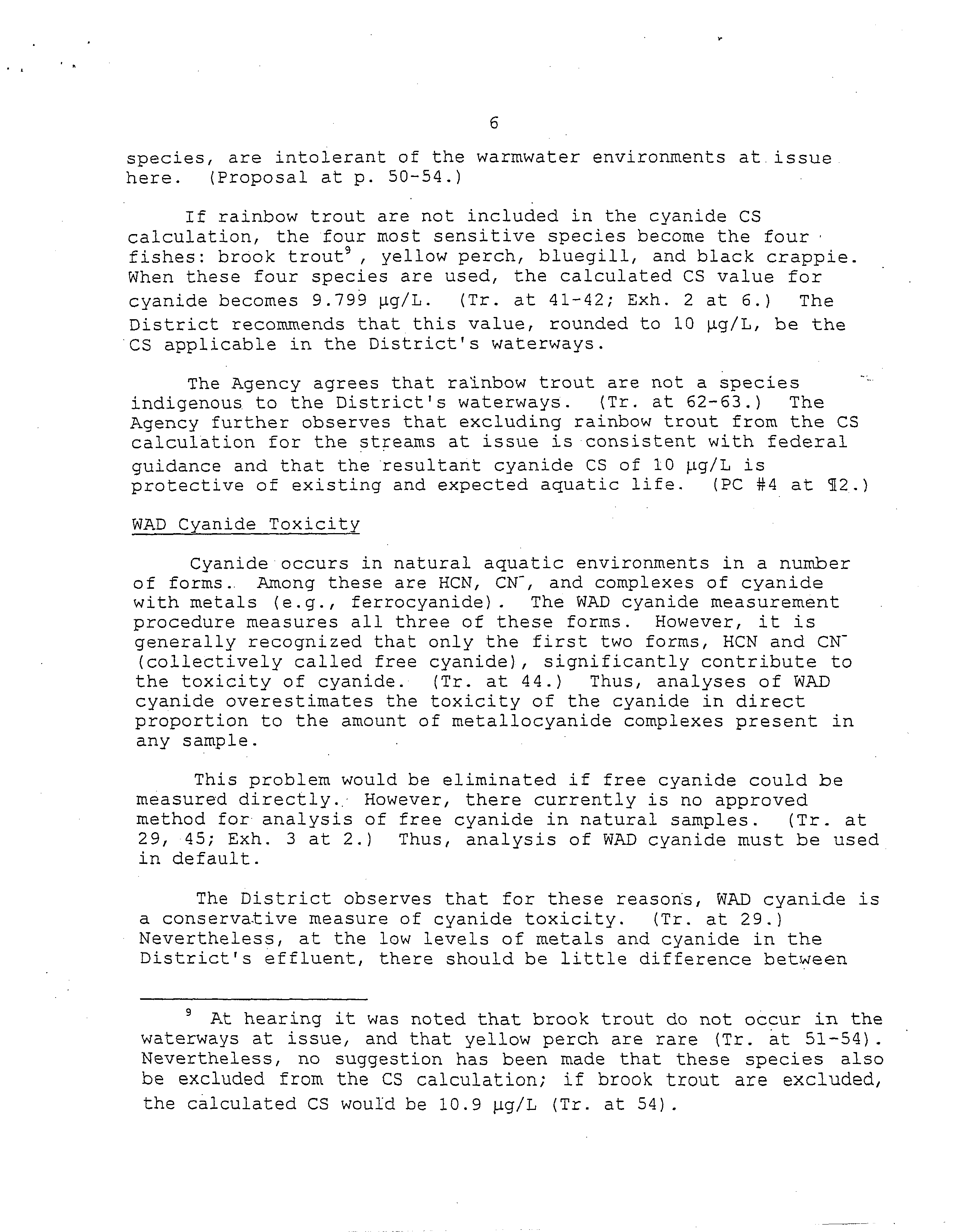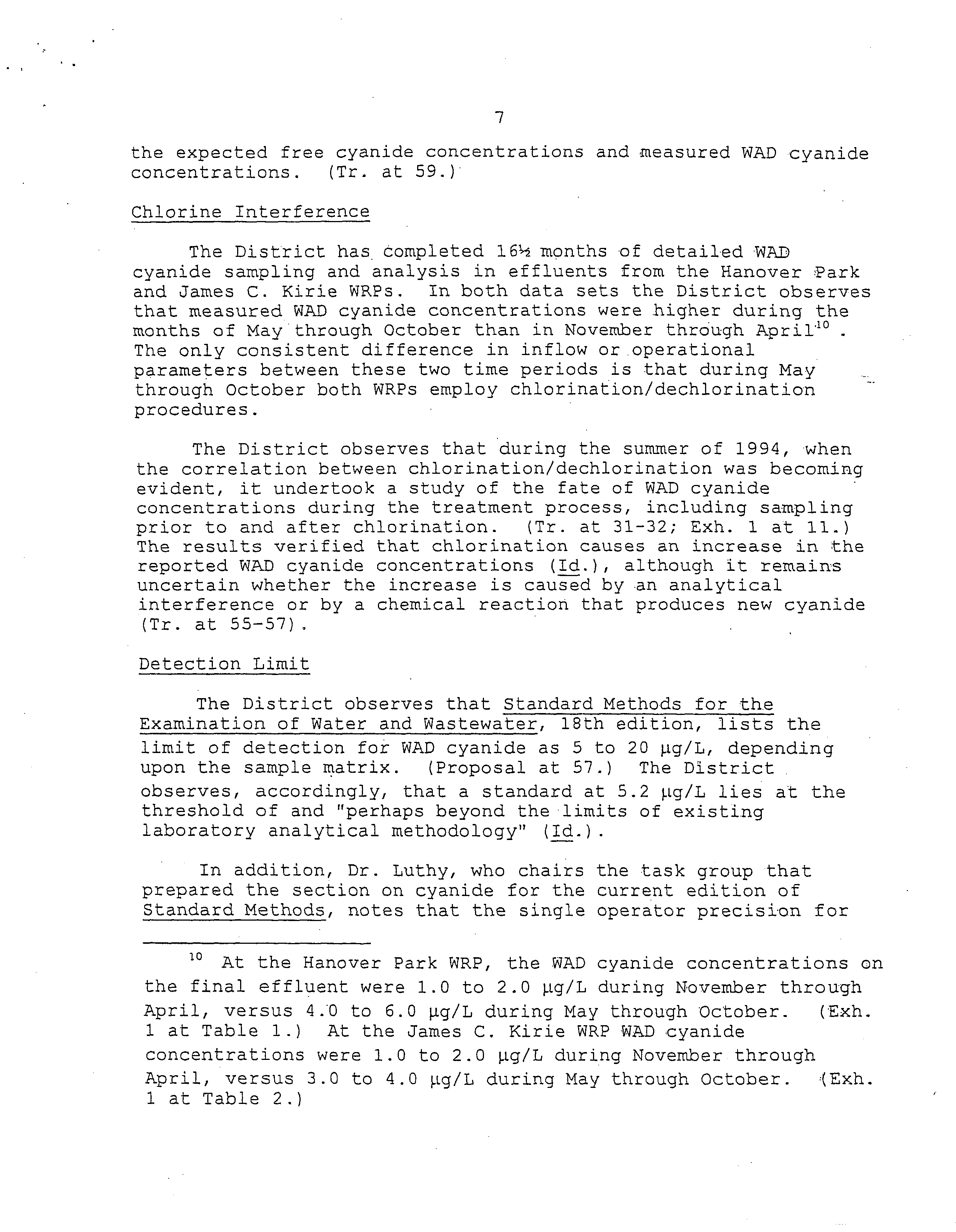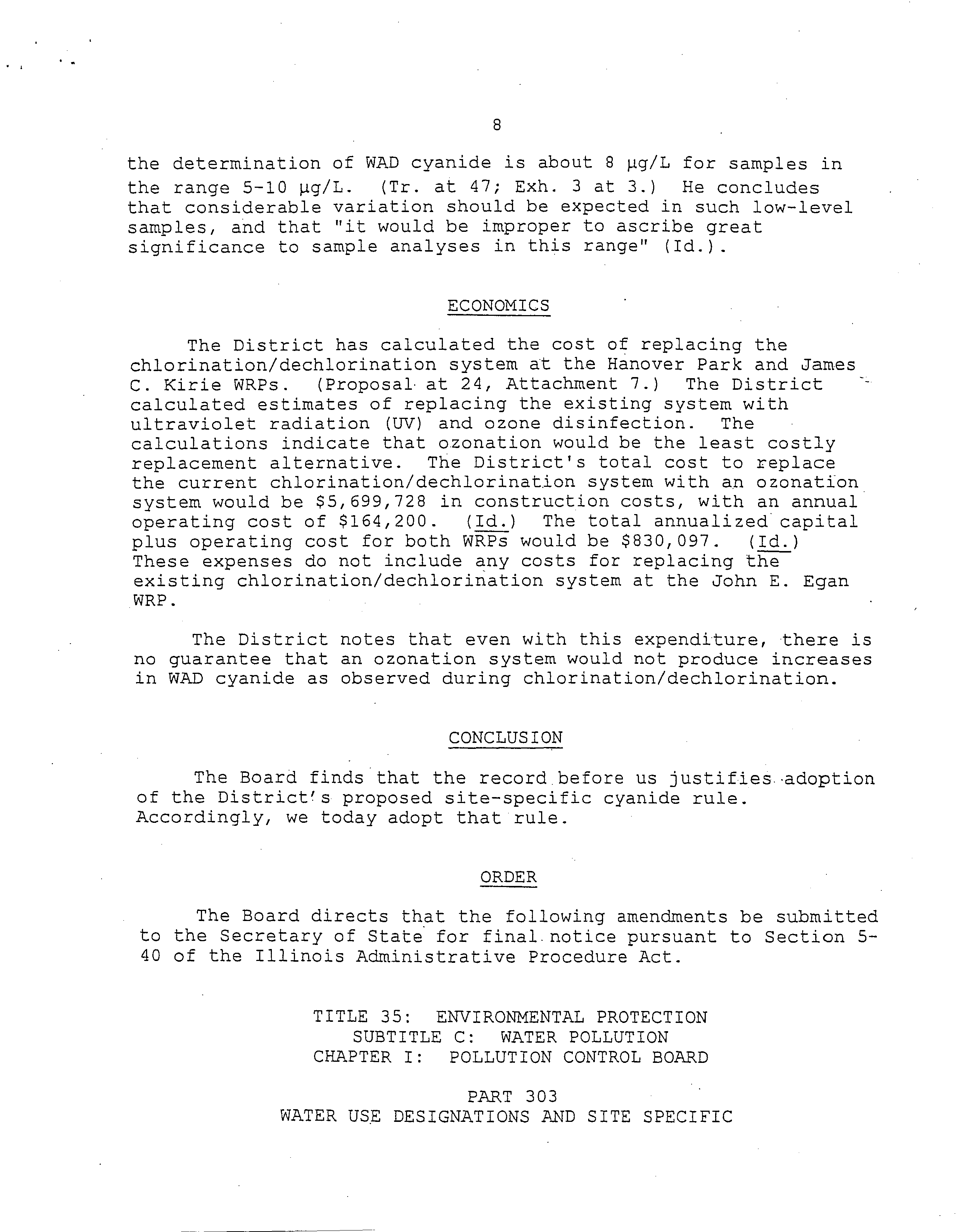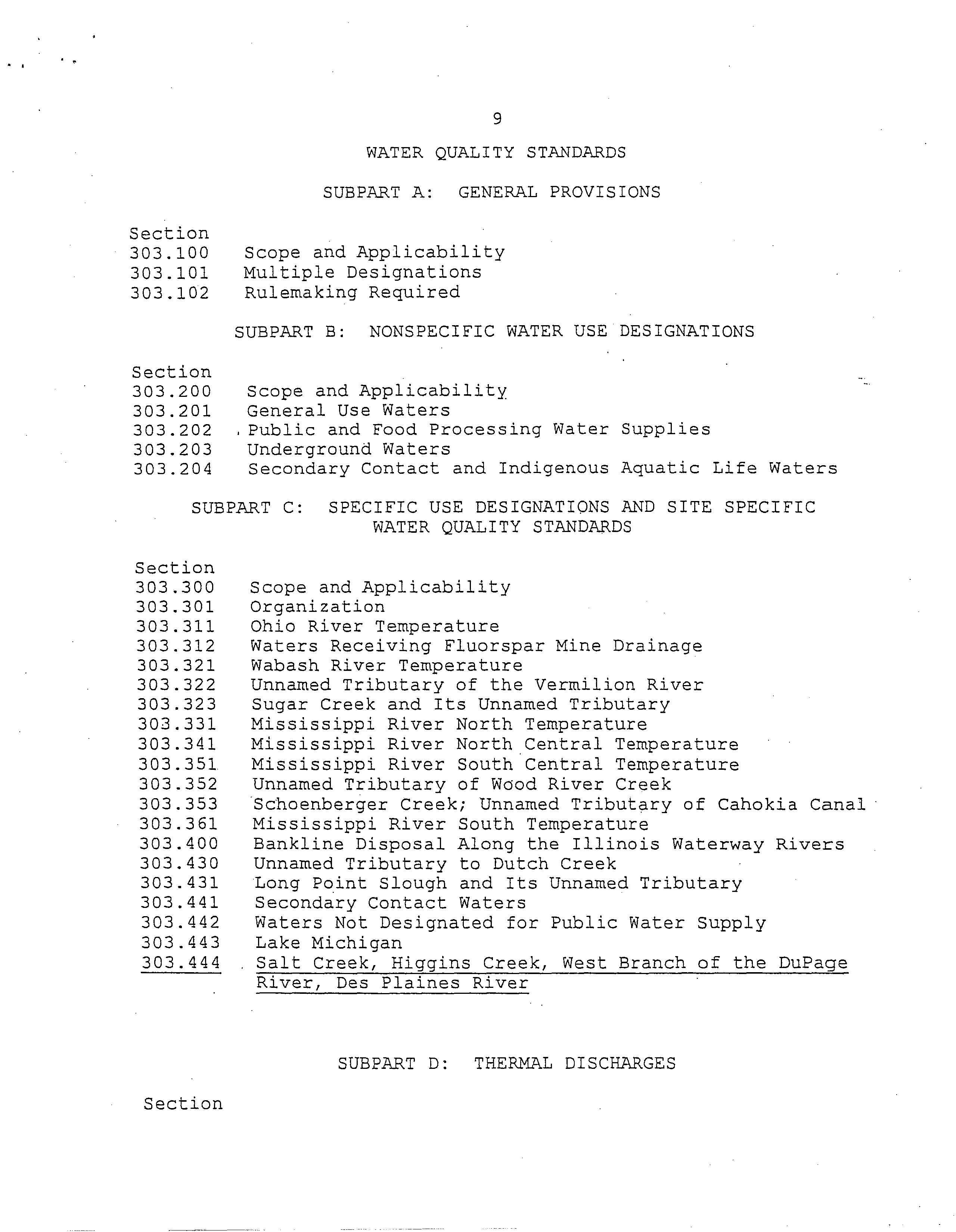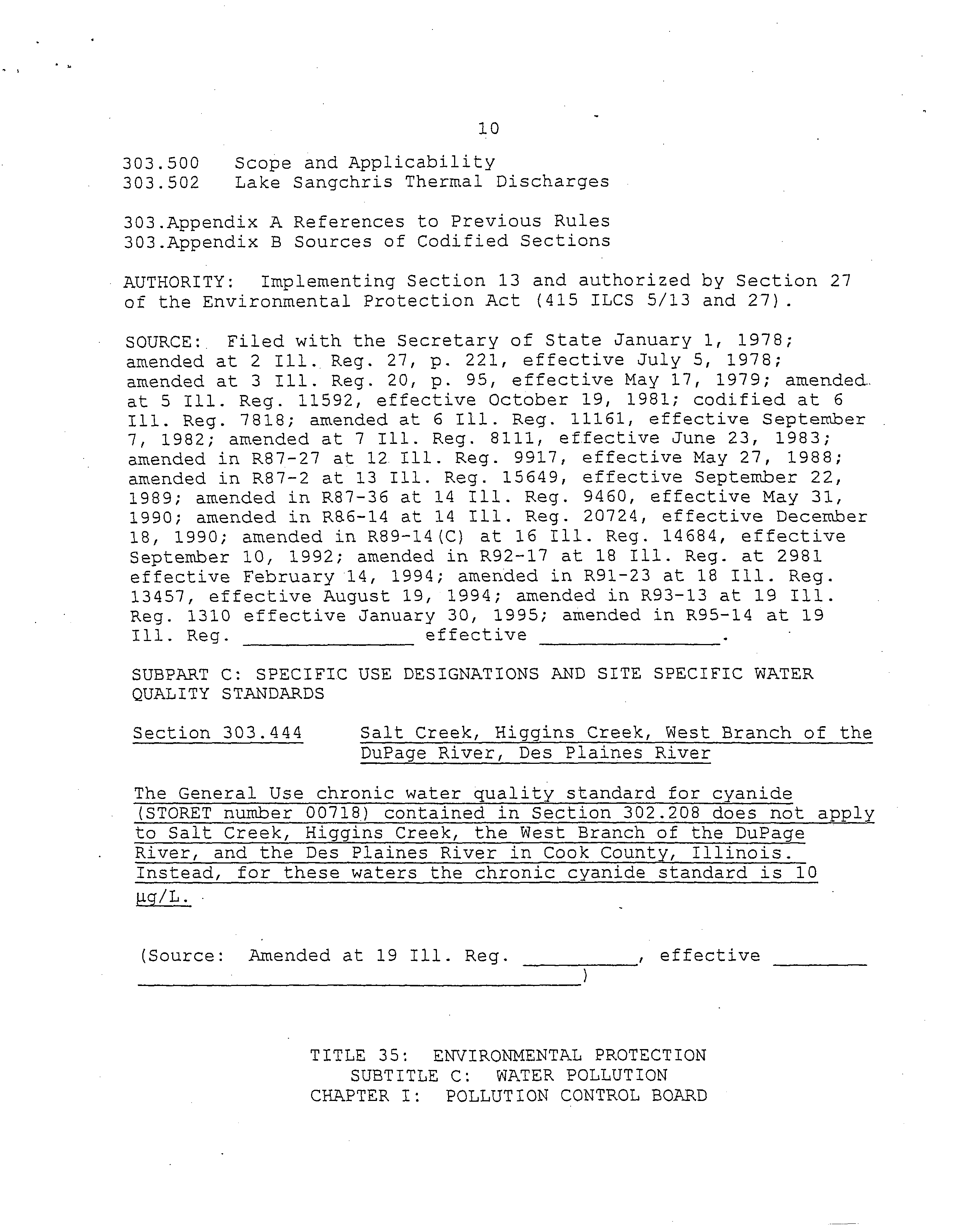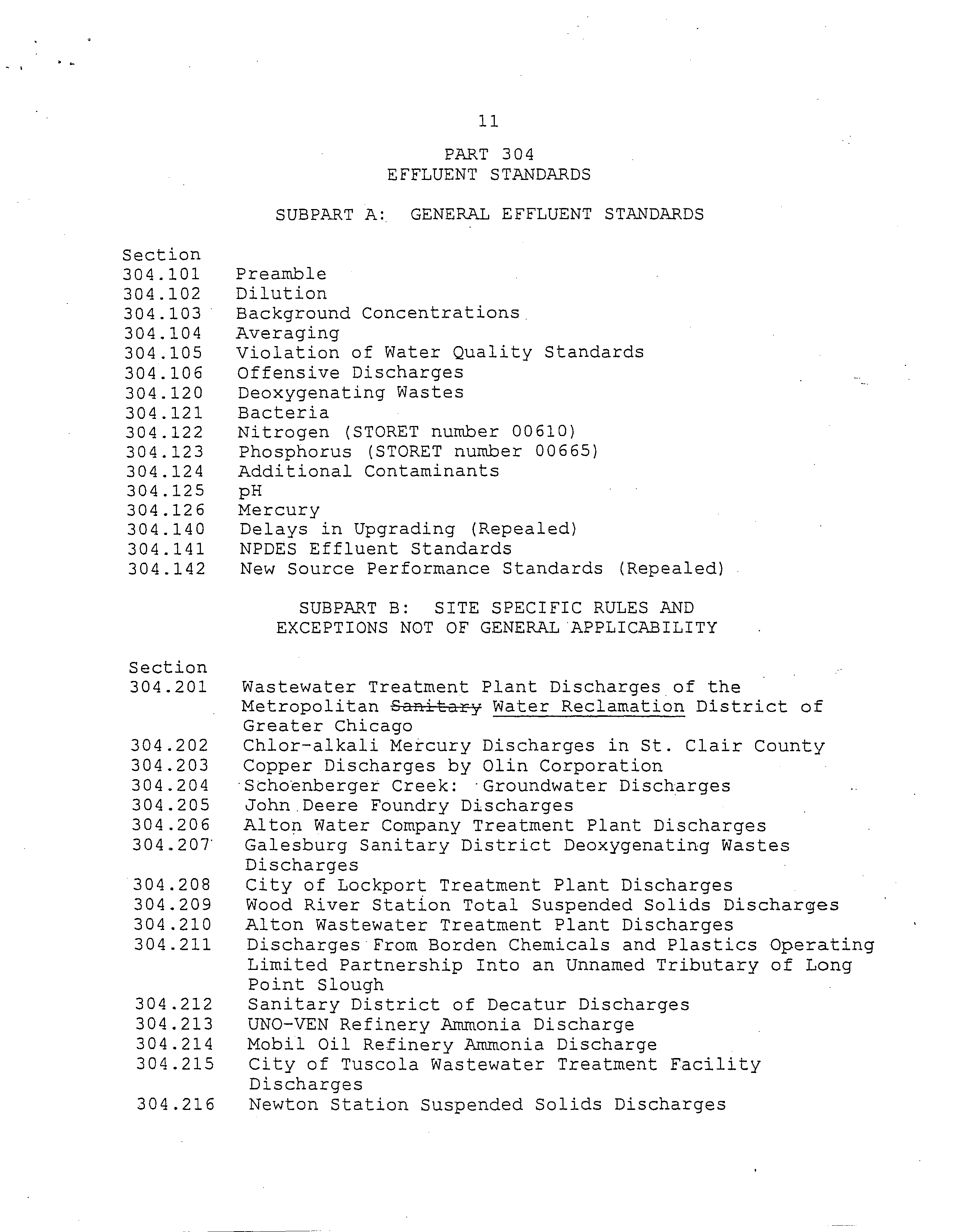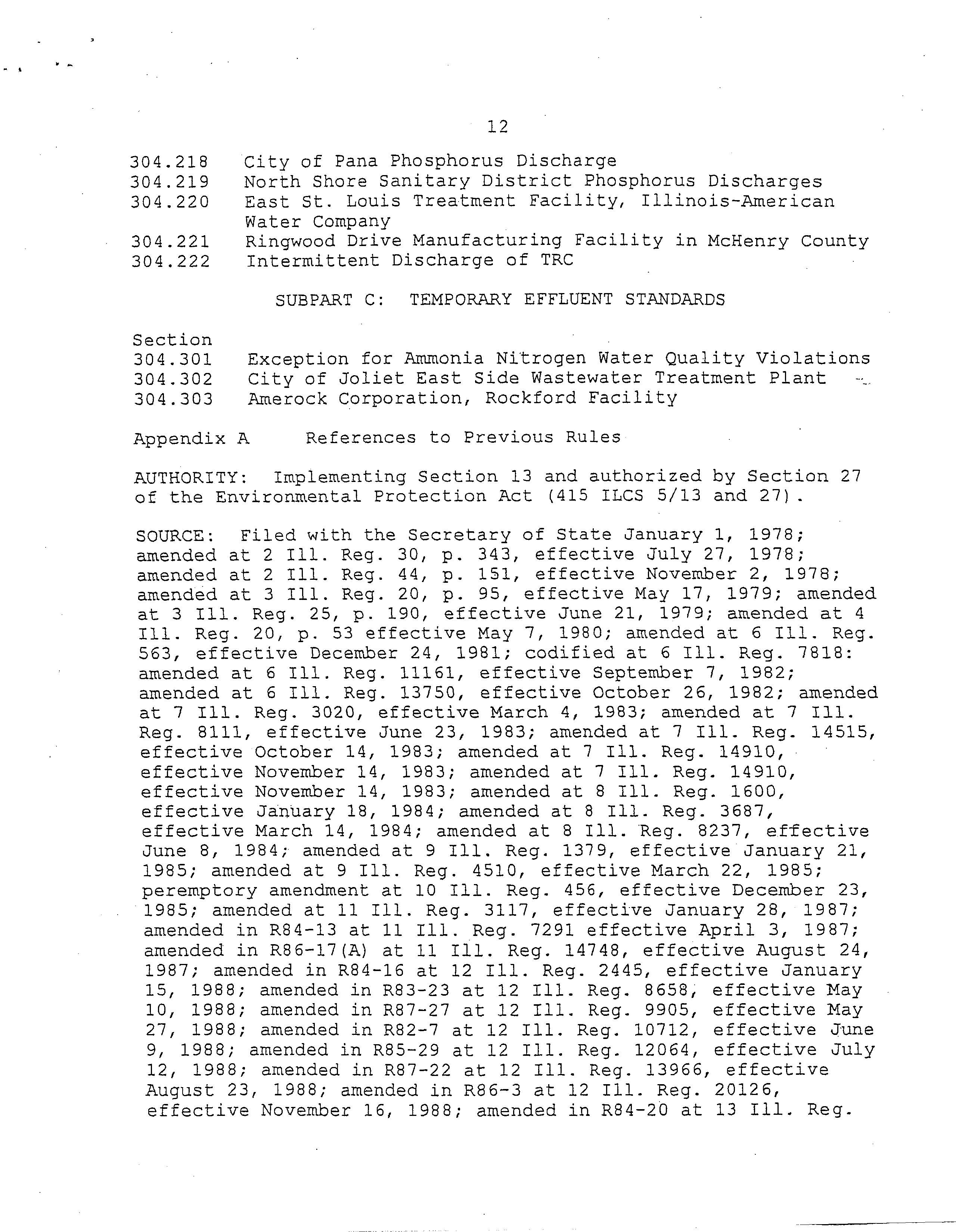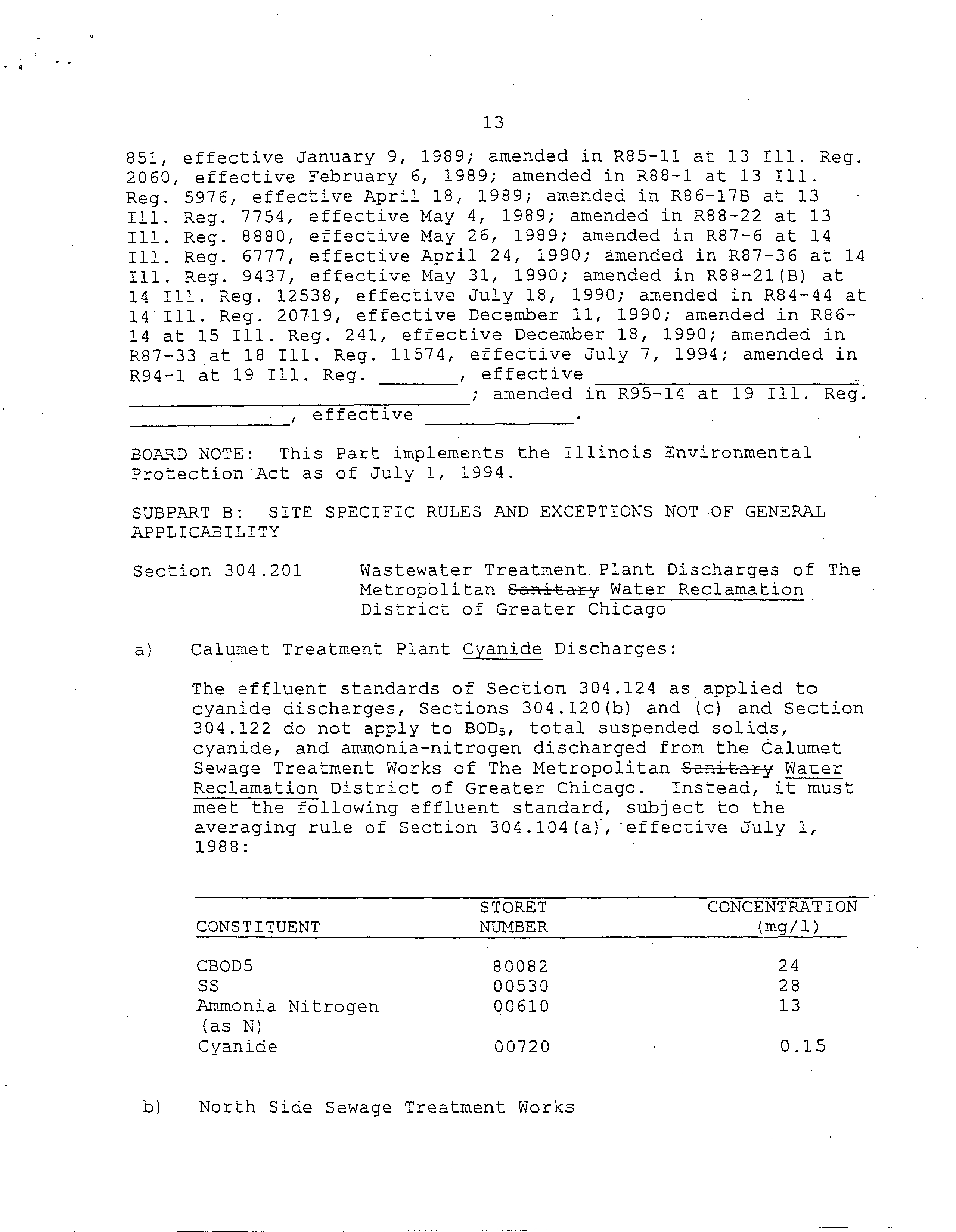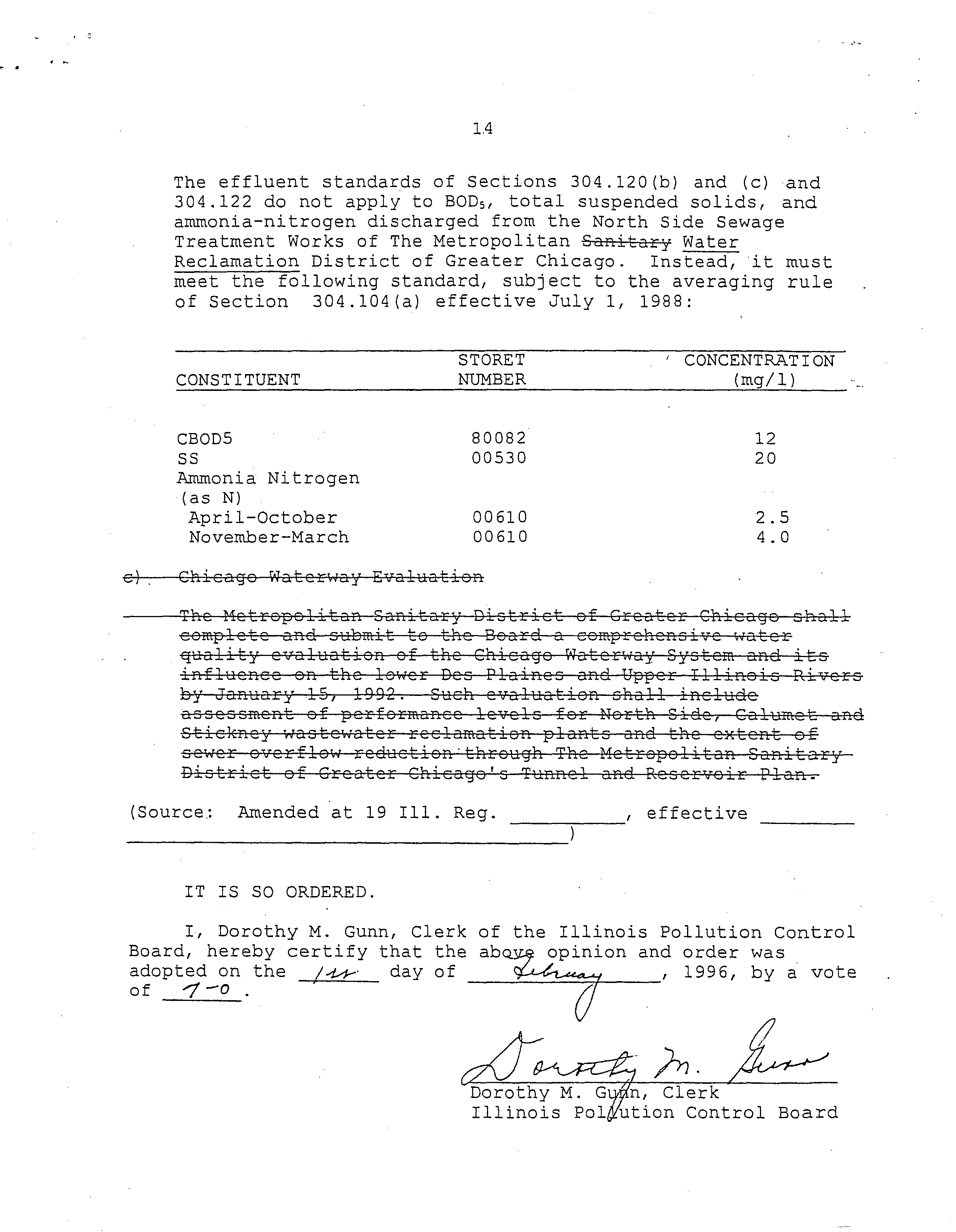BEFORE THE ILLINOIS POLLUTION CONTROL
BO~~CEIVED
CLERK’S OFFICE
IN THE MATTER OF:
)
SEP
0 5 2002
)
STATE OF IWNOIS
WATER QUALITY TRIENNIAL REVIEW
)
R02-1 i
Pollution
Control
Board
AMENDMENTS TO
35
ILL. ADM. CODE
)
(Rulemaking-Water)
302.208(e)-(g), 302.504(a),
)
302.575(d),
303.444,
309.141(h);
)
AND PROPOSED
35
ILL. ADM. CODE
)
/? ~-
301.267,301.313,301.413,
)
‘
304.120 AND 309.157
)
COMMENTS OF THE METROPOLITAN WATER RECLAMATION DISTRICT
OF GREATER CHICAGO TO FIRST NOTICE OF OPINION AND ORDER
The Metropolitan Water Reclamation District of Greater Chicago (“District”) has
reviewed the First Notice, Opinion and Order of the Board, for Rulemaking R02-11, and is
submitting the following comments regarding the Board’s decision to reject the Illinois
Environmental Protection Agency’s (“Agency”) proposal to revise the General Use Water
Quality Standard for weak acid dissociable (“WAD”) cyanide.
The District supports the Agency’s proposal for the following reasons, and respectftilly
requests that the Board reconsider its rejection of the Agency’s proposal regarding WAD
cyanide, and accept the Agency’s proposal to revise the WAD cyanide standard for General Use
Waters.
The District has been very involved in the study of appropriate WAD cyanide water
quality standards since 1993. In 1995, the District submitted a petition to the Illinois Pollution
Control Board for a site-specific rulemaking regarding WAD cyanide water quality standards,
captioned
In the Matter of Petition of the Metropolitan Water Reclamation District of Greater
Chicago for Site-Spec?fIc Water Quality Regulation,
Docket No. R95-14 (“Petition”). Prior to
filing its Petition, the District conducted extensive laboratory studies regarding analytical
methodologies for measuring WAD cyanide and retained nationally recognized consultants
familiar with WAD cyanide chemistry and toxicity. In support of its Petition, the District
submitted testimony from these nationally renowned experts in their fields. Attached hereto is a
copy of certain testimony filed by the District as part of the R95-14 proceedings, which
testimony summarizes the maj or issues covered in the District’s voluminous Petition. (See
Attachment 1)
In this testimony the District clearly demonstrated that the existing General Use Chronic
Water Quality Standard for WAD cyanide of
5.2
~.ig/Lwas calculated using approved United
States Environmental Protection Agency (“USEPA”) methodology, but with the goal of
protecting rainbow trout, which was considered the most sensitive species. Ifthe rainbow trout,
a non-indigenous species, is removed from the calculation, and approved USEPA methodology
is utilized, the chronic water quality standard for WAD cyanide becomes 10 ~.ig/L,which is the
standard that the Agency is now proposing. This 10 ~tg/Lchronic standard is even protective of
such cold water species as brook trout, which are included in the toxicity database in the USEPA
guidance documents.
The District testimony also discusses the complexity of cyanide speciation and analyses
and clearly points out that WAD cyanide is a conservative surrogate indicator for free cyanide
which is the true toxic form of cyanide. Thus, using WAD cyanide as the constituent to be
regulated, automatically assures that a safety factor is built into the water quality standard. The
District testimony also points out the analytical uncertainties in measuring WAD cyanide
concentration at levels below 10 ~ig/L.
On February 1, 1996, the Board published its Final Action for R95-14 and granted the
District’s request for a site-specific change in the General Use Chronic Water Quality Standard
for WAD cyanide from a value of 5.2 ~tg/Lto a value of 10 ~.tg/L,which is the same value as the
Agency now proposes. A copy ofthe Board’s final action is appended hereto as Attachment II.
In the Opinion and Order ofthe Board in the R95-14 Rulemaking, the Board substantially agreed
with all ofthe District’s testimony. Although the R95-14 Rulemaking only dealt with portions of
the Des Plaines River, it is the District’s contention that the Agency has correctly concluded that
the same justifications presented in the R95- 14 Rulemaking can be applied to the entire state of
Illinois.
The District strongly supports Mr. Mosher’s testimony in R02- 11 regarding his use of
approved USEPA methodology for calculating the appropriate toxicity values for WAD cyanide,
and strongly disagrees with the Illinois Department of Natural Resources (“IDNR”) position in
R02-l 1 that unproven methodologies and/or speculations regarding the toxicity ofWAD cyanide
to freshwater mussels should be used in the R02-l 1 Rulemaking. It is the District’s position that
the Board should support the use of approved USEPA methodologies for determining water
quality standards, and not second-guess the Agency based upon unsupported and unapproved
methodology.
In conclusion, the District respectfully requests that the Board review the record of the
R95-14 Rulemaking, reconsider its decision, and accept the Agency’s proposal for a revised
WAD cyanide General Use Water Quality Standard as it is based on sound science and proven
USEPA methodology.
Metropolitan Water Reclamation District
of Greater Chicago,
By:
September 3, 2002
Richard Lanyon, &ector ofR&D
Metropolitan Water Reclamation
District ofGreater Chicago
100 East Erie
Chicago, Illinois 60611
312.751.5190
THIS FILING IS SUBMITTED ON RECYCLED PAPER
2
ATTACHMENT I
BEFORE THE ILLINOIS POLLUTION CONTROL BOAR
~GE1VED
JUN -91g95
STATE OF ILLINOIS
POLLUTION CONTROL BOARD
In.
the Matter of:
Petition of the Metropolitan Water
Reclamation District of
Greater
Chicago for Site-Specific Water
Quality Regulation:
)
R95—14
(Site-Specific Rule-
making 35 Iii. Adm.
Code 302, 303, 304
TO:
NOTICE OF FILING
Mr. Bruce Carison
Illinois Environmental
Protection Agency
2200 Churchill Road
Springfield, IL 62794—9276
Mr. William Seith
Illinois Attorney General
Office
100 West Randolph Street
Chicago, IL 60601
Mr. William Denham
Department of Energy and
Natural Resources
325 West Adams Stree.t
Springfield, IL 62704
Mr. Richard C. Warrington, Jr.
Division of Legal Counsel
Illinois Environmental
Protection Agency
2200 Churchill Road
Springfield, IL 62794
PLEASE TAKE NOTICE that I have today filed with the
Office of the Clerk of the Pollution Control Board testimony
of the Metropolitan Water Reclamation District of Greater
Chicago and two of its consultants (Dr. Herbert Allen and Dr.
Richard Luthy), a copy of which is herewith served upon you.
June 9, 1995
Michael Rosenberg
Attorney
Metropolitan Water Reclamation
District of Greater Chicago
100 East Erie Street
Chicago, Illinois 60611
(312) 751—6565
S ignaturd~,)
THIS FILING IS SUBMITTED ON RECYCLED PAPER
PROOF OF SERVICE
Mr. Bruce Carlson
Illinois Environmental
Protection Agency
2200 Churchill Road
Springfield, IL 62794—9276
Mr. William Seith
Illinois Attorney General
Office
100 West Randolph Street
Chicago, IL 60601
Bernard Sawyer
Metropolitan Water Reclamation
District of Greater Chicago
100 East Erie Street
Chicago, Illinois 60611
(312) 751—6565
Mr. William Denham
Department of Energy and
Natural Resources
325 West Adams Street
Springfield, IL 62704
Mr. Richard C. Warrington, Jr.
Division of Legal Counsel
Illinois Environmental
Protection Agency
2200 Churchill Road
Springfield, IL 62794
Signature
Subscribed and sworn before me this
OFFICIAL SEAL
~
ROSALIE BOTTARI
~ NOTARY PUBLIC, STATE OF ILLINOIS
MY COMMISSION EXPIRES:04/1O/98
~
I, the undersigned, on oath state that I have served the
testimony of the METROPOLITAN WATER RECLAMATION DISTRICT OF
GREATER CHICAGO and two of its consultants (Dr. Herbert Allen
and Dr. Richard Luthy) by first class mail upon the following
persons:
_________
day of
,
1995.
c
THIs
FILING IS SUBMITTED ON RECYCLED PAPER
JUN -91995
TESTIMONY OF DR. CECIL LUE—HING
I
BEFORE THE ILLINOIS POLLUTION CONTROL BOA ~TE OFILLINOIS
IN THE MATTER OF: PETITION OF THE METROPOLIT~ LLUTI ~CONTROL
RECLAMATION DISTRICT OF GREATER CHICAGO FOR
SITE-SPECIFIC WATER QUALITY REGULATION (R95-14)
JUNE 6, 1995
Intro duc t ion
My name is Dr. Cecil Lue-Hing, and I am the Director of
Research and Development at the Metropolitan Water Reclama-
tion District of Greater Chicago (District)
In this petition, the District is asking the Board to
grant a site-specific regulation. The District asks the
Board to do the following:
1. Revise the existing numerical General Use
chronic water quality standard for weak acid
dissociable (WAD) cyanide from 5.2 ~ig/l to 10.0
~ig/1 for the:
a. West Branch of the DuPage River
b. Higgins Creek
c. Salt Creek
d. Des Plaines River (within Cook County)
The existing General Use chronic water quality standard
for WAD cyanide is 5.2 ugh, and was adopted as a result of
the Board’s Hearings in R88-21. The Board’s existing General
Use chronic water quality standard f or cyanide uses the
laboratory analytical test method for WAD Cyanide (Storet
Number 00718) to determine compliance.
1
Background
DESCRIPTION OF THE DISTRICT
The District is located within the boundaries of Cook
County Illinois and serves an area of about 872 square miles.
The area served by the District includes the city of Chicago
and 124 suburban communities with a combined residential
population of 5.1 million people and a waste load equivalent
to 4.9 million people contributed by industrial sources. The
District, on a daily basis, treats an average of 1,500 mil-
lion gallons per day of wastewater at its seven water recla-
mation plants (WRPs).
DISTRICT WRPs ON GENERAL USE STREAMS
Three of the District’s seven WRPs discharge to General
Use streams. These WRPs, the
streams
to which they dis-
charge, and their average daily flows, are as follows:
1994 Average
WRP
Daily Flow
Receiving Stream
Hanover Park
8.87 MGD
West Branch DuPage River
John E. Egan
24.5 MGD
Salt Creek
James C. Kirie
31.8 MGD
Higgins Creek
ILLINOIS ENVIRONMENTAL PROTECTION AGENCY PERMITS
In 1993, the Illinois Environmental Protection Agency
(Agency) issued renewed National Pollutant Discharge Elimina-
tion (NPDES) permits for the Hanover Park and James C. Kirie
WRPS which,
for
the first time, included numerical.effluent
2
limits based upon the General Use Chronic Water Quality Cri-
teria for Cyanide adopted by the Board in R88-21.
following limits in the NPDES
and James C. Kirie WRPs:
Monthly Average
Effluent WAD
WRP
NPDES Permit Number
Cyanide (p.g/1)
Hanover Park
1L0036137
5.2 ~ig/1
James C. Kirie
1L0047741
5.0 ~1g/l
The numerical effluent limits were set equal to the Board’s
General Use chronic water quality standard f or WAD cyanide
since the West Branch of the DuPage River and Higgins Creek
have a 7-day, 10-year low flow of zero. In these NPDES
permits, the District is required to measure the WAD cyanide
concentration in the effluents from these WRPs to determine
compliance. This is in keeping with the Board’s existing
General Use chronic water quality standard for WAD cyanide.
Because the District had never before measured the WAD
cyanide concentration in the effluent from the James C. Kirie
and Hanover Park WRPs, a 12-month delay in the imposition of
the effluent limits fOr cyanide in the new NPDES permits was
requested. The Agency granted the District’s request, and
the effective date for
the new WAD cyanide limits in these
NPDES permits was changed to April 1, 1995.
In anticipation of these Board proceedings, the District
recently requested that the Agency again change the effective
The Agency placed the
permits
for the Hanover Park
3
date for the new WAD cyanide limits to October 1, 1996. The
Agency has granted this extension.
DISTRICT STUDIES
During the past 24 months, the District has been con-
ducting routine monitoring of the WAD cyanide level in the
effluents from the James C. Kirie and Hanover Park WRPs.
In addition, the District has conducted studies on the
following topic areas:
1. Inputs of WAD cyanide from industrial sources
to the James C. Kirie and Hanover Park WRPs.
2. Effect
of wastewater treatment on
WAD cyanide
levels.
3. Accuracy and precision of the laboratory ana-
lytical method for WAD cyanide.
4. Chlorine interference in the WAD cyanide analy-
sis.
The District has also investigated the following:
1. Basis for the existing General Use chronic
water quality standard .f or WAD cyanide.
2. Basis for using the WAD cyanide analytical pro-
tocol for determining compliance with the Gen-
eral Use chronic water quality standard for WAD
cyanide.
In the above mentioned studies and investigations, the
District has used the services of two experts. They are:
4
1. Dr. Richard Luthy
Professor and Head
Department of Civil and Environmental Engineering
Carnegie Mellon University
Pittsburgh, Pennsylvania
2. Dr. Herbert E. Allen
Professor
Department of Civil Engineering
University of Delaware
Newark, Delaware
Dr. Luthy is a nationally recognized expert on cyanide
chemistry and analytical measurements, and is currently the
Chairman of the Standard Methods Joint Task Group on Cyanide.
He has published many papers on these topics.
Dr. Herbert Allen is a nationally recognized expert on
speciation chemistry, including chemical analysis. He has
extensively studied the fate of pollutants in receiving
streams and treatment plants, and the effect of pollutants on
aquatic life. He is currently the Principal Investigator on
the following two United States Environmental Protection
Agency (USEPA) sponsored research projects.
1. Speciation of Metals in Effluents and Receiving
Waters.
2. Speciation, Bioavailability, and Fate of Con-
taminants in the Aquatic Environment.
Both of these individuals are present and will be testi-
fying today.
5
Summary of Site-Specific Relief Sought
The District asks that the Board revise the existing
General Use chronic water quality standard for WAD
cyanide
from 5.2 pg/l to 10.0 ~g/l fior the following streams:
1. West Branch DuPage River
2. Higgins Creek
3. Salt Creek
4. Des Plaines River (in Cook County)
The District
has found that
the existing numerical
chronic
water quality standard of 5.2 ~g/l WAD cyanide assumes that
the receiving stream is capable of supporting a large popula-
tion of the cold water fish species of rainbow trout. These
streams, in fact, do not
support
such populations. Using
USEPA approved procedures, and the fact that rainbow trout
are not indigenous to the waterways in question, a General
Use chronic water quality standard for cyanide of 10.0 ~g/l
WAD cyanide is justified.
With respect to this Petition, three District WRPs will
be directly impacted. They are the John E. Egaa1 James C.
Kirie, and Hanover Park WRPs, all of which discharge to
General Use waters of the state of Illinois. The John E.
Egan WRP discharges to Salt Creek, the James C. Kirie WRP
discharges to Higgins Creek, and the Hanover Park WRP dis-
charges to the West Branch of the DuPage River. All of these
waterways eventually flow into the Des Plaines River.
6
Water Reclamation Plant WAD Cyanide Concentrations
Tables 1 and 2 present detailed data on WAD cyanide
concentrations in the raw sewage, and final effluent from the
Hanover Park and James C. Kirie WRPs for 1994 and five months
of 1995. WAD cyanide is the parameter of concern in this
Petition.
As there had been no previous standard for WAD cyanide,
the District had not analyzed the final effluents from its
WRPs for WAD cyanide prior to receiving the new NPDES per-
mits. Therefore, no database was available on WAD cyanide
levels in WRP effluents. It quickly became apparent that
final effluent WAD cyanide concentrations at both WRPs mea-
sured well below 22 ~g/l on a daily basis, but were often
equal to or greater than 5 ~1g/l, making compliance with the
proposed monthly average NPDES permit limits problematic. As
so little information was available on the sources and fate
of WAD cyanide in the wastewater treatment process, discus-
sions were held with the Agency relative to the NPDES permit
limits for WAD cyanide. The Agency stated that the WAD
cyanide effluent limits were water quality driven based upon
the General Use standards f or cyanide, and could not be
changed without Board action. The Agency agreed, however, to
add a Special Condition to the NPDES permits for both WRPs
which changed the effective date for complying with the WAD
cyanide standard from April 1, 1994 to April 1, 1995. This
7
METROPOLITAN WATER RECLAMATION DISTRICT OF GREATER CHICAGO
TABLE 1
MONTHLY AVERAGE OF RAW SEWAGE AND FINAL
EFFLUENT WAD CYANIDE AT THE HANOVER PARK WRP
Month
Raw
Sewage
WAD Cyanide
(jig/i)
Final Effluent
WAD Cyanide
(~g/l)
January 1994
1.0
1.0
February
1.0
1.0
March
1.0
1.0
April
1.0
1.0
May
1.0
4.0
June
2.0
5.0
July
2.0
.
6.0°
August
1.0
5.0
September
1.0
5.0
October
1.0
5.0
November
1.0
1.0
December
1.0
1.0
January 1995
1.0
1.0
February
1.0
1.0
March
2.0
2.0
April
2.0
2.0
May 1—18
2.0
5.0
8
METROPOLITAN WATER RECLAMATION DISTRICT OF GREATER CHICAGO
TABLE 2
MONTHLY AVERAGES OF RAW SEWAGE AND FINAL
EFFLUENT WAD CYANIDE AT THE JAMES C. KIRIE WRP
.
Month
Raw Sewage
WAD Cyanide
(~g/l)
Final Effluent
WAD Cyanide
(~g/l)
January 1994
2.0
2.0
February
3.0
2.0
March
4.0
.
2.0
April
2.0
2.0
May
1.0
3.0
June.
2.0
°
4.0
July
5.0
4.0
August
.
14.0
.
4.0
September
2.0
3.0
October
1.0
2.0
November
,
2.0
1.0
December
1.0
1.0
January 1995
.
2.0
•
2.0
.
February
3.0
2.0
March
3.0
3.0
April
2.0
.
2.0
May 1-18
3.0
2.0
9
was done to allow the District adequate time to assess the
occurrence, fate, treatability, and distribution, of WAD
cyanide throughout the Hanover Park and James C. Kirie WRP
systems.
From September 1993 to the present, the District has
been studying the WAD cyanide issue relative to the Hanover
Park and James C. Kirie WRPs. These studies have involved
the wastewater treatment processes at the WRP5, laboratory
research work, industrial waste monitoring, and literature
searches.
These studies revealed an unexpected result which can be
seen from the WAD cyanide data presented in Tables 1 and 2.
From November through April, when the chlorination/dechlori-
nation system is not in use, the final effluent WAD cyanide
concentrations measured at the Hanover Park WRP (Table 1)
averaged either 1.0
or 2.0 ~g/l each month. The raw sewage
WAD
cyanide
concentrations also averaged either 1.0 or 2.0
~g/l. For May through October when the chlorination/de-
chlorination system is operational, the monthly average final
effluent WAD cyanide concentrations increased to the 4.0-6.0
~g/1 level, even though the raw sewage WAD cyanide concentra-
tions remained at the 1.0 or 2.0 ~g/l level. These monthly
average values were equal to or exceeded the proposed NPDES
permit limit for WAD cyanide of 5.2 ~g/l at the Hanover Park
WRP.
10
A similar, though not as pronounced, pattern occurred at
the James C... Kirie WRP (Table 2) where November through April
effluent WAD cyanide concentrations typically averaged either
1.0 or 2.0 ~ig/l versus May through October typical monthly
averages of 3.0 and 4.0 ~g/l.
In the summer of 1994 when the correlation between
chlorination/dechlorination and effluent WAD cyanide concen-
trations was becoming evident, a more comprehensive sampling
program was begun at both WRPs to study the fate of WAD cya-
nide through the wastewater treatment process. This involved
collecting special samples for one month of raw sewage, pri-
mary effluent, secondary effluent, chlorine contact tank
effluent, and dechlorinated effluent, and analyzing them for
WAD cyanide. The results verified that chlorination is
causing an increase in WAD cyanide as measured by the WAD
cyanide analytical methodology.
Efforts Needed to Comply With Existing Board
Regulations, Compliance Alternatives and Costs
As documented above, the District ‘believes that the
Hanover Park and James C. Kirie WRP5 cannot consistently
achieve a monthly average effluent WAD cyanide concentration
of 5.2 and 5.0 ~g/l, respectively, as specified in their
NPDES permits.
In order to reduce effluent WAD cyanide concentrations
to levels which will meet the current standards, three
potential options were identified.
11
1. Add an additional treatment process to the WRP
to remove WAD cyanide from the effluent.
2. Reduce the raw sewage loading of WAD cyanide to
each WRP by amending the District’s Industrial
Waste Ordinance relative to cyanide discharges.
3. Replace the existing chlorinatio~i/dech1orina-
tion system with a different disinfection pro-
cess such as ozonation or ultraviolet light.
With
respect
to option 1 above, a review of the techni-
cal literature indicated that no technologically feasible
treatment processes exist for removing WAD cyanide from mu-
nicipal wastewater at the low pg/l levels, which enter these
WRPs.
In respect to option 2, the District has a rigorous
program in place to control discharges from industry in-
cluding those that contain cyanide.
Dedicated continuous monitoring is now being performed
at 69 industries in the north service area. This requires
the District to maintain 83 dedicated automatic samplers in
continuous operation, since some industries have multiple
discharge points.
The District’s dedicated continuous monitoring program
has identified two industrial dischargers of cyanide in the
Hanover Park WRP service area, and six industrial dischargers
of cyanide in the James C. Kirie WRP service area.
12
The highest WAD cyanide concentration measured in the
industrial discharges to the Hanover Park WRP tributary
sewers was 4.0 ~g/l, with most values at the 1.0 ~g/l level.
Taking dilution
from the domestic wastewater into’ account,
the industrial contribution of WAD cyanide to the Hanover
Park WRP is insignificant.
For the six companies discharging to the James C. Kirie
WRP, typical WAD cyanide concentrations are in the 0.2 to 0.4
mg/l range, with the highest observed value being 0.76 rng/l.
However, taking flow dilution. into account, the industrial
contribution of WAD cyanide at the James C. Kirie WRP would
only contribute 1.0
to 2.0 ~g/l of WAD’cyanide to the raw
sewage.
Thus, increased industrial waste enforcement activities
would not be a solution to the WAD cyanide problem at these
two WRPs, as maximum effort is currently being expended to
control such discharges
by the District’s Industrial Waste
Division.
With respect to option 3, technically feasible disinfec-
tion alternatives exist as substitutes for chloriñation/de-
chlorination in the wastewater treatment process.
‘
Since Dis-
trict data indicates that the chlorination/dechlorination
process is causing the increase in effluent WAD cyanide, re-
placing this process with an alternate technology may reduce
effluent WAD cyanide concentrations. However, since the
reasons for the increase in WAD cyanide due to chlorination/
13
dechlorination are not known, there is no guarantee that an
alternative disinfection process would not also cause similar
increases.
‘
.
The District has developed a cost estimate for replacing
the chlorination/dechlorination system at the Hanover Park
and James C. Kirie WRPs. This cost estimate indicates that
ozonation would be the least costly alternative if the
existing chlorination/dechlorination systems had to be re-
placed. For the Hanover Park WRP an ozone disinfection
system is estimated to have a total construction cost of
$1,294,228, and an annual operating cost of $35,400. The
total annualized construction plus operating cost is
$186,604. For the James C. Kirie WRP an ozone disinfection
system is estimated to have a total construction cost of
$4,405,500, and an annual operating cost of $128,800. The
total annualized capital plus operating cost is $643,493.
Thus, the total cost to the District for replacing the
chlorination/dechlorination system with an ozonation system
would be a construction cost of $5,699,728, and an annual
operating cost of $164,200. The total annualized capital
plus operating cost, for both WRPs would be $830,097. It
should be noted that these costs do not include costs for
replacing the existing chlorination/dechlorination system at
the John E. Egan WRP. However, it is the District’s under-
standing that when the current NPDES permit for the John E.
Egan WRP expires on September 30, 1995, the new permit will
14
contain a WAD cyanide effluent limit similar to that of the
Hanover Park and James C. Kirie WRPs. Therefore, the
District anticipates even greater costs than those listed
here f
or
complying
with the existing WAD cyanide standardS.
However, there is no
guarantee that an ozonation system
would not produce increases in WAD cyanide as observed for
chlorination/dechlorination.
The current NPDES permits for the Hanover Park and James
C. Kirie WRPs contain monthly average
WAD cyanide limits
equal to the existing
General Use chronic water quality
stan-
dard, as
no instrearn dilution factor is available. Since the
District anticipates that a similar NPDES permit limit for
WAD cyanide will be imposed at the John E. Egan WRP when its
permit is
renewed, the John E. Egan WRP and Salt Creek are
included in this Petition.
Impact of Site-Specific Rulemaking on the Environment
No qualitative impact on the environment would occur if
the proposed site-specific regulation is adopted since the
waterways in question do not contain rainbow trout. Trout
are not indigenous to these waterways and would not populate
these waterways, even if the existing cyanide standard is
retained. No adverse qualitative effects on the environment
are anticipated if the proposed site-specific regulation is
adopted.
No quantitative impacts on the environment are expected
as a result of adopting
the site-specific regulation as no
15
change in District WRP operations would occur. Thus, WRP
effluent quality would remain the same even after the site-
specific regulation is adopted.
Biomonitoring Tests
The District has conducted extensive biomonitoring tests
on WRP effluents as part of an integrated approach consisting
of whole effluent and chemical-specific analyses as a means
of protecting aquatic life and human health. These biomoni-
toring tests give a better picture of the true effect which
effluents. have on the aquatic community than do chemical-
specific data alone. In. 1993 and 1994, 76 biomonitoring
tests were conducted on effluent and upstream receiving water
from the John E. Egan, Hanover Park, and James C. Kirie
WRPs. The data indicate that neither acute nor chronic toxi-
city is associated with the effluents from these three WRP5.
TECHNICAL JUSTIFICATION FOR PROPOSED REGULATIONS
The District has identified four factors in its proposal
which it believes
.
significantly distinguishes it from. those
relied on by the Board in the R88-21 rulemaking relative to
WAD cyanide. These are:
1. The indigenous species criteria used in calcu-
lating fish toxicities are not applicable to
the waterways named in the District’s proposal.
16
2. Use of WAD cyanide for determining water
quality standards
is not directly related to
toxicity as compared to use of free cyanide.
3. Chlorine interferes with the WAD cyanide test.
4. The regulatory’limits are at or below the limit
of detection.
Each of these factors is discussed in the following
sections.
The Use of Nonindigenous
Species in
Calculating Fish Toxicities
In reviewing the record of the Board’s R88-21 rulemaking
it can be seen that the Board adopted the Agency’s recom-
mendations relative to the General Use water quality stan-
dards for WAD cyanide. The Agency recommendations were based
upon two USEPA documents.
1. Ambient Water Quality Criteria for Cyanide
-
1984, EPA—440/5—84—028.
2. Guidelines for Deriving National Water Quality
Criteria for the Protection of Aquatic Organ-ET?1 w?160 293 m?495 293 l?S?BT?
isms and Their Uses, NTIS, PB85-227049.
Dr. Herbert Allen was retained by the District to review
how the information contained in these two documents was
applied in the R88-21 rulemaking, and how this methodology
relates to the District’s request for an adjusted standard.
Dr. Allen’s findings can be summarized as follows.
Using the cyanide toxicity data presented in the Ambient
17
Water Quality Criteria for Cyanide
-
1984, and the
method-
ology specified in
the Guidelines for Deriving National Water
Quality Criteria for the Protection of
Aquatic Organisms and
Their Uses, the Final Chronic Value for cyanide using the
four most sensitive fish species (rainbow trout, brook trout,
yellow perch, and bluegill which are the national default
species) can be calculated to equal 7.32 ~g/1. However, the
Guidelines document states that if the
‘
species Mean Acute
Value of a commercially or recreationally important species
is lower than
the
calculated
Final
Acute
Value, then the
Species Mean Acute
Value can replace the calculated value in
order to provide protection for that one important species.
The R88-21 record indicates that the Agency made the decision
‘to use rainbow trout as the most important species, and
substituted rainbow trout toxicity data for the calculated
Species Mean Acute Value. This Species Mean Acute Value was
then used to calculate a new Final Chronic Value for
cyanide
of 5.2 p.g/l.
The Agency then recommended the 5.2 ~ig/1 value
to the Board, instead of the national default value of 7.32
~g/l contained in the USEPA Guidelines document.
The USEPA Guidelines document allows for the calculation
of
a site-specific toxicity value, if sufficient data exists
for the rivers in
question. The methodology for determining
a site-specific toxicity value is contained in the USEPA
document entitled Guidelines for Deriving Numerical Aquatic
Site-Specific Water Quality Criteria (EPA-600/3-84-099)
.
The
18
methodology allows indigenous fish species to be substituted
for the national default four most sensitive species men-
tioned previously. Based upon the allowed USEPA methodology,
the four most sensitive fish species which may actually exist
in the rivers covered
by this Petition are brook trout, black
crappie, bluegill, and yellow perch. Rainbow trout do not
exist in the waters covered by this petition. Using the cya-
nide toxicity data for these four fish species, the calcu-
lated Final Chronic Value for cyanide is 9.799 ~g/l. Thus,
the existing chronic standard for WAD cyanide of 5.2 pg/l is
inappropriate.
It is the position of the District that the use of rain-
bow trout as the sole species for determining a chronic water
quality standard for WAD cyanide in the rivers under question
in this Petition is incorrect due to the fact that rainbow
trout are not indigenous to Salt Creek, Higgins Creek, the
West Branch of the DuPage River, or the Des Plaines River in
Cook County.
For the past 20 years, as part of its environmental
monitoring programs, the District has conducted fish col-
lections in the rivers of Cook County. A total of’18,308
fish composed of 61 species and seven hybrids have been
collected by the District from the Des Plaines River, Salt
Creek, and the DuPage River during the period 1974 through
1994. Fishing gear used included boat and backpack electro-
fishers, 15-foot and 25-foot minnow seines with 3/16-inch
19
square mesh, and an electric seine. The results of ‘these
fish collections are summarized as follows:
1. Des Plaines River: 15,392 fish composed of 57
species and 4 hybrids were collected from the
Des Plaines River and its tributaries in Lake,
Cook, DuPage, and Will Counties during 1976,
1977, 1978, 1979, 1992, and 1993.
2. Salt Creek: 865 fish composed of 18 species
and two hybrids were collected from Salt Creek
and its tributaries in eastern DuPage County
and north and central Cook County during 1974,
1975, and 1976.
3. .DuPage River: 2,051 fish composed of 39 spe-
cies and seven hybrids were collected from the
DuPage River, including the east and west
branches, and tributaries
contained
in DuPage
County and northwestern Will County during 1976
and 1994.
Neither rainbow trout, nor, any other species of trout,
were ever present in any of these collections.
The Des Plaines River, Salt Creek, and the DuPage River
are sluggish low gradient warm water streams. Warm water
streams have more severe fluctuations of water temperatu’re,
chemical conditions, water volume, current velocity, and
‘bottom contours than do cold water trout streams. Warm water
20
streams are generally more turbid and deeper than cold water
trout streams.
Cold water streams are suitable for trout while warm
water streams are not. Trout require cold water streams con-
taining riffles with good water and oxygen flow through the
gravel on the stream bottom f or embryo survival. Temperature
influences fish
by controlling reproductive cycles, feeding
and metabolic rates, swimming performance, growth rates, and
distribution. Temperatures below or above the general range
of
10°C to 20°C have unfavorable consequences on the de-
velopment and growth of trout.
The Des Plaines River, Salt Creek, and the DuPage River
have summer temperatures exceeding 20°C and contain only warm
water fish species. The silty deposition of sluggish low
gradient streams also prevents good water and oxygen flow for
trout embryo survival. No species of trout was ever found in
any of the collections from the Des Plaines River, Salt
Creek, or the DuPage River. The habitat in these streams and
their tributaries is not suitable for trout to successfully
maintain sustainable populations.
This same general position has recently been affirmed by
the Agency, as evidenced by the Agency’s recent testimony be-
fOre the Board in the R94-1 rulemaking. In the Agency’s tes-
timony, the Agency clearly stated that it is improper to use
cold water species toxicity data
,
in calculating General Use
water quality standards for ammonia nitrogen. The Agency
21
also stated that cold water species are not resident in
Illinois waters except for Lake Michigan.
The District believes that the above information clearly
demonstrates that the existing General Use chronic water
quality standard for
WAD
cyanide was based upon factors
significantly different
than those relating to the District’s
situation.
Use of WAD Cyanide Instead of Free Cyanide
for Determining Water Quality Standards
The R88-21 rulemaking established General Use water
quality standards for cyanide based upon the measurement of
WAD cyanide. However, the USEPA AltLbient Water Quality
Criteria for Cyanide
-
1984 states that:
.free cyanide would provide a more scientifi-
cally correct basis upon which to establish cr1-
°
teria for cyanide.”
Free cyanide is defined as HCN
+
CN, whereas WAD cya-
nide is defined as HCN
+
CN
+
weak metal cyanide complexes.
Thus,
it is clear that WAD cyanide is a conservative measure
of
the truly toxic form of cyanide, i.e., free cyanide, and
thus overestimates its presence.
Unfortunately, there is no USEPA-approved method for the
analysis of free cyanide. Therefore, it is understandable
that the Board chose WAD cyanide as a regulatory measure.
However, the District requests that the Board take this added
22
measure ‘of conservatism into account when evaluating the
District’s request
for a site-specific rulemaking.
Chlorine Interference in the WAD Cyanide Test
As discussed above, the District believes that chlorina-
tion of WRP effluents causes analytical interferences which
result in increased WAD cyanide concentrations, as determined
by the accepted WAD cyanide analytical method. During 1994
the District conducted a number of bench-scale laboratory
experiments in an attempt to determine whether the chlorine
interference was strictly a methodology related problem, or
if the chlorine was actually affecting the cyanide speciation
in the WRP effluent. The District also retained Dr. Richard
Luthy to visit the District’s laboratory and evaluate the WAD
cyanide analytical procedures.
The data from these laboratory experiments indicates
that chlorination/dechlorination
interferes with
the analyti-
cal test and causes an increase in WAD cyanide concentrations
in some cases, but the magnitude, of the increase
in the
laboratory did not always correspond to the field data ob-
served at the District WRPs. The data also shows that there
wasno cyanide contamination in any of the chemicals being
used at the two WRPs.
The District believes that this unanticipated chlorine
interference at low WAD cyanide concentrations was not known
to the District, the Agency, or the Board during the R88-21
23
Rulemaking, and requests that this problem be taken into
account when
the Board reviews this Petition.
Setting Regulatory Limits at or Below the Limit of Detection
The current General Use chronic water quality standard
f or WAD cyanide is 5.2 pg/l. Standard Methods for the
Examination of Water
and Wastewater, 18th Edition, lists the
limit of detection of the WAD
cyanide analysis as 5 to 20
pg/i depending on the sample matrix. Thus, by adopting the
5.2
pg/i limit, the ‘Board unwittingly placed a considerable
burden on the District to accurately analyze WAD cyanide in
the effluents from its WRP5, perhaps beyond the limits of
existing laboratory analytical methodology.
Dr. Richard Luthy, who is the chairman of the Standard
Methods Committee on Cyanide Analysis will be discussing the
difficulties of accurately analyzing WAD cyanide at these low
concentrations. In particular, it should be noted that the
precision of the WAD cyanide analysis at the limit of detec-
tion is
±
8.0 pg/i. Thus, at the lower limit of detection of
5 pg/i, the true value could be between -3.0 and 13.0 pg/i,
and at the upper limit of detection of
20 pg/l, the true
value could be between 12.0 and 28.0
pg/l.
For this reason,
a regulatory limit of 5.2 pg/i is not meaningful.
Indeed, the District believes that a reasonable conclu-
sion here would be that even the more conservative 7.32 pg/i
WAD cyanide value, which is a calculated value designed to
24
protect rainbow trout, falls below
the accepted analytical
range of precision of
±
8.0 pg/i.
In early 1994, as the District gained experience with
the Standard Methods WAD cyanide procedure, it became clear
that with our sample matrix, some modifications of the
Standard Methods procedure would be required to allow the
District to analyze for WAD cyanide at concentrations below 5
pg/i. This methodology was reviewed by Dr. Luthy when he
visited our laboratory, and as he will testify, he approves
of our procedures.
It is the District’s understanding that no other munici-
pal wastewater dischargers in the state of Illinois are re-
quired to achieve a detection limit below 10 pg/i for WAD
cyanide. The District believes that requiring the develop-
ment of special analytical methodology to demonstrate com-
pliance with an inappropriate regulatory limit places an
undue burden on its resources as compared to other dis-
chargers in
the state, and is a sign.ificant factor to take
into account.
Also, while the District is disappointed that it is
being singled out to develop methodology to measure WAD cya-
nide concentrations below 10 pg/i, we believe that a WAD
cyanide limit of 10 pg/i would be more meaningful for the
following reasons:
25
1. Dr.
Allen’s calculated
chronic value of 9.799
pg/i, which is indistinguishable from 10 pg/i,
will protect
all species except rainbow trout.
2. Dr.
Luthy’s determination that
at the detection
limit (5-20 pg/i) for WAD cyanide the precision
is ±8.0 pg/i.
3. The District’s demonstration, supported by Dr.
Luthy, that chlorine interference is signifi-
cant for WAD cyanide measurements below 10
pg/i.
4. The analytical burden of constantly trying to
measure WAD cyanide concentrations below 10
pg/i.
5. The fallacy that reported WAD cyanide values of
10.0 pg/i, obtained by existing methodology,
provide any meaningful basis for technical
discussions relative to indigenous aquatic
species toxicity.
6. The Agency’s affirmation that cold water spe-
cies such as rainbow trout are not indigenous
to the water bodies in th’is Petition.
7. The value of 10.0 pg/i more properly target,s
the aquatic species of concern in the affected
waterways.
Thus, notwithstanding the fact that the District is
prepared to be
cooperative regarding analytical methodology
26
development, the need for a WAD cyanide limit of 10.0 pg/l
is not warranted.
Summary Comments
The District has an outstanding record in providing high.
quality wastewater treatment to the residents of Cook County.
The addition of an’ extremely conservative WAD cyanide limit
to the NPDES permits, for two of the District’s WRPs, has
created
a situation where potential permit violations could
occur even though effluent quality remains high, and reported
WAD cyanide values would not endanger indigenous species.
This could result in an unnecessary expenditure of taxpayer
dollars for unneeded modifications to the WRPs.
The District believes that this Petition clearly demon-
strates that the existing General Use chronic water quality
standard for WAD cyanide was promulgated based upon incom-
plete and overly conservative assumptions which do not relate
to the District’s true situation. The District believes that
it has provided ample justification in its Petition to demon-
strate that it is technically feasible and economically rea-
sonable, for a grant by the Board of a site-specific regula-
tion, and respectfully asks the Board to so grant its
Petition.
27
TESTIMONY OF DR. HERBERT E. ALLEN
IN THE MATTER OF
R95-14 (SITE SPECiFIC RULEMAKING)
A PROPOSAL BEFORE THE ILLINOIS POLLUTION CONTROL BOARD
JUNE 6, 1995
My name is Dr. Herbert Allen. I am testifying on behalfof the Metropolitan Water
Reclamation District of Greater Chicago, who have retained me as a consultant on this project. I
am Professor ofEnvironmental Engineering at the University of Delaware. I received my Ph.D.
from the University ofMichigan in 1974. Prior to joining the faculty of the University of
Delaware I served on the faculties of the Illinois Institute of Technology in Chicago and Drexel
University in Philadelphia. I have an active research program concerned with the fate and effects
of pollutants in water, sediment and soils. A major thrust of my programs has been directed
toward the development ofinformation that can be used to establish appropriate environmental
criteria and standards. My research, and that of many others, has shown that the total or the
dissolved fraction of a pollutant is not equivalent to the fraction which is bioavailable to aquatic
organisms, thus producing a toxic response. My research has been supported by over fifty grants
and has resulted in the publication of over 115 books and papers. Since 1984 I have been a
member of the research team concerned with the development of national sediment quality
criteria. I head a consortium of eight universities in a project titled “Bioavailability, Trophic
Transfer and Fate of Pollutants in the Aquatic Environment” that is funded by the U.S.
Environmental
Protection Agency’s Office ofWater. A principal objective is the development of
the information that can be used to
develop a water quality criteria for copper based on
bioavailable forms of the metal. I have frequently served as a consultant
to industrial and
governmental groups on
water quality issues.
My activities for the Metropolitan Water Reclamation District of Greater Chicago have
included reviewing the speciation (or chemical form) of cyanide in water and the effects of this
speciation on the toxicity of cyanide to aquatic organisms. I have used the data presented in the
Testimony of Herbert E.
Allen
page 2
U.S. Environmental Protection Agency’s Ambient Water Quality Criteria for Cyanide
-
1984
(EPA-440/5-84-028) and the procedures described in the U.S. Environmental Protection
Agency’s Guidelines forDeriving Numerical National Water Quality Criteria for the Protection
of Aquatic Organisms and Their Uses which is published as NTIS PB 85-227049 to derive
appropriate water quality standards for cyanide for the protection of aquatic life in the West
Branch of the DuPage River, Higgins Creek, Salt Creek, and the Des Plaines River. This
testimony summarizes the information contained in my report to the Metropolitan Water
Reclamation District ofGreater Chicago which is presented as Attachment 10 in the District’s
Petition.
Cyanide, in the forms of cyanide
ion,
CN, and hydrogen cyanide or hydrocyanic acid,
HCN, is termed free cyanide. Cyanide reacts with metal ions to form complexes, the stability of
which varies with the metal. Some, such as the zinc and cadmium complexes are virtually
completely dissociated in water while the iron complexes are virtually non-dissociated. The
cyanide complexes of other metals, such as nickel, are partly dissociated in natural waters and
the degree of dissociation The toxicity of cyanide species to aquatic organisms has been the
subject of a number of studies. The U.S. EPA has concluded in the Criteria Document that “The
apparent toxicity to aquatic organisms of most simple cyanides and metallocyanide complexes is
due mainly to the presence of HCN
...
Most metallocyanide complexes are not very toxic.” The
Criteria Document states “EPA believes that a measurement such as free cyanide would provide
a more scientifically correct basis upon which to establish criteria for cyanide. The criteria were
developed on this basis.” Because there is no EPA approved method for the measurement of free
cyanide implementation has been on the basis of other measurements of cyanide such as total
cyanide or Weak Acid Dissociable (WAD) cyanide. Because these measurements include forms
other
than free
cyanide, they overestimate the concentration of bioavailable cyanide and thus are
conservative measurements.
In the Criteria Document the National Water Quality Criterion for cyanide was developed
following the Guidelines. All aquatic toxicological data were collected and subjected to a data
Testimony of HerbertE. Allen
page 3
quality assurance review. Those which do not meet requirements were not included. The
requirement of a minimum data base in the Genus Mean Acute Values (GMAVs) of at least one
species of freshwater animal in at least eight ofthe required different families was met. GMAVs
for freshwater organisms meeting data quality requirements were computed and listed in rank
order, from high to low, as shown in the following table.
The Final Chronic Value (FCV) is usually based on the acute toxicity data, which are
used to establish the Final Acute Value (FAV). The studies in which both an acute and a chronic
toxicity have been determined are used to establish an acute-chronic ratio. The FCV is
determined by dividing the FAV by the acute-chronic ratio. The acute-chronic ratio for cyanide
is 8.568.
Genus
Species
Rank
Mean Acute
Species
.
Mean Acute
Value
Value
(~.tgIL)
(~LgIL)
15
2,490
Midge,
Tanytarsus dissimilis
2,490
14
2,326
Isopod,Asellus
communis
2,326
13
432
Snail,
Physa heterostropha
432
i2426Stonefly~Pteronarcys
dorsata
426
11
318
,
Goldfish,
Carassius auratus
318
10
,
,
167
,
Amphipod,
Gammarus pseudolimnaeu.s
167
9
147
Guppy,Poecilia reticulata
147
8
125.1
Fathead minnow,
Pimephales promelas
125.1
7
123.6
Cladoceran,
Dàphnia magna
160
ciadoceran,
Daphniapulex
95.55
6
102
Largemouthbass,Micropterussalmoides
102
4
99.28
Bluegill,
Lepomis macrochirus
99.28
3
92.64
Yellow perch,
Percaflaves~ens
,
92.64
2
85.80
Brook
trout,
Salvelinusfontinalis
85.80
1
63.45
Rainbow trout,
Salmo gairdneri
44.73
Atlantic salmon,
Salmo salar
90.00
Testimony ofHerbert E. Allen
page
4
The FAV is an estimate of the concentration of the material that corresponds to a
cumulative probability of 0.05 in the acute toxicity values for the genera with which acceptable
acute tests have been conducted on
the material. The FAV is computed in the following manner:
a.
The GMAVs are ordered from high to low.
b. Ranks, R, are assigned to the GMAVs from “1” for the lowest to “N”
for the
highest.
If two
or more GMAVs
are identical, they are arbitrarily assigned
successive ranks.
c. The cumulative probability, P, for each GMAV is calculated as RJ(N+1).
d. The four GMAVs which have cumulative probabilities closest to 0.05 are
selected.
If there are less than 59 GMAVs, these will always be the four lowest
GMAVs.
e. Using the selected GMAVs and Ps, calculate
Z((ln GMAV)2)
—
((~(ln GMAV))2/4)
~(P)
((~(~))2/)
L
=
(~(ln GMAV)
-
s(~(~)))/4
A
=
s(~Jö~ö~)
+
L
FAV=eA
Using this procedure, I have calculated the FAV to be 62.680 j.tg/L as shown in the
following table. Dividing this value by the acute-chronic ratio of 8.568 gives a FCV of 7.316
jig/L, which represents the National Crition that would be obtained by applying the proceduere
described in the Guidelines.
For the development of the Final Acute Value, the Guidelines document states “However,
in some cases, if the Species Mean Acute Value of a commercially or recreationally important
species is lower
than the calculated Final Acute Value, then that Species Mean Acute Value
replaces
the calculated Final Acute Value in order
to provide protection for that important
Testimony of
Herbert
E. Allen
page 5
species.” In the case of the U.S. Environmental Protection Agency’s development of a National
Water Quality Criterion for Cyanide for the Protection ofAquatic Life, the FAV of 44.73 p.g/L
for rainbow trout has been used in replacement of the 62.68 ~.tg/Lthat is calculated by the above
procedure. This results in the FCV being lowered from 7.32 to 5.22 p.g/L. The 5.22 value is for
the protection of rainbow trout and other salmonids.
Site-specific criteria can be developed by modification of the National Criteria
(Guidelines for Deriving Numerical Aquatic Site-Specific Water Quality Criteria by Modifying
National Criteria. U.S. Environmental Protection Agency, Environmental Research Laboratory
-
Duluth. EPA-600/3-84-099. PB85-121 101). The same procedure described above for the
calculation of National Criterion is followed, but non-resident species are excluded from the
calculation. In the present case, the criterion for cyanide was recalculated excluding rainbow
Bluegill,
Lepomis macrochirus
Yellow perch,
Percaflavescens
Brook trout,
Salvelinusfontinalis
Rainbow
trout,
Salmo gairdneri
N=total number of Mean Acute Values
(MAY) in data set
=
15
Rank
CMAV
4
99.28
3
92.64
2
85.80
1
63.45
(In GMAV)
21. 14109
2
20.5093 1
19.82047
17
.22459
SUM
78.69547
P=Ri(N÷1)
0.25000
0.18750
0.12500
0.06250
0.62500
SQRT (P)
0.50000
0
.43301
0.35355
0.25000
1.53657
s2=
S~
L=
In GMAV
4.5979
4.5287
4.4520
4.1503
17.7289
3.3584
1.8326
3.7283
4.1380
All data
for rank
1 thru4
species
62.680
31.340
8.568
7~316
FAV
=
CMC=
acute/chronic ratio
=
FCV
=
FAV
lowered to
protect
rainbow trout
44.730
22.365
8.568
5.221
r.
Testimony ofHerbert E. Allen
page~6
trout from the data base. Black crappie, Pomoxis nigromaculatus, is added as the fourth species
used in the calculation.
Although
neither yellow
perch nor bluegill are present in these receiving
waters, they
were retained in the data base to meet the Guideline’s minimum data base
requirement that at least eight
different families be included. The results of this calculation,
which is presented below shows that the concentration ofcyanide that would be protective of the
fish populations in the receiving waters covered by this Site-specific Rulemaking is 9.799 ~Ig/L,
expressed as free cyanide. Because free cyanide is only a portion of WAD cyanide, use of
WAD, rather than free cyanide provides a conservative safety factor.
Based on my review and calculations, I believe that a
Site-specific Water Quality
Criterion, for the protection of aquatic life in the West Branch of the DuPage River, Higgins
Creek, Salt Creek, and
the
Des Plaines River, should be established forcyanide. Using the
Black crappie,
Pomoxis nigromaculatus
Bluegill,
Lepomis macrochirus
Yellow perch,
Percaflavescens
Brook trout,
Salvelinusfontinalis
N=total number of
Mean Acute Values
(MAY) in data set
=14
Rank
GMAV
4
102.00
3
99.28
2
92.64
1
85.80
(InGMAV)
21.39037
2
21.14109
20.5093 1
19.82047
SUM
82.86125
P=RJ(N+
1)
0.26667
0.20000
0.13333
0.06667
0.66667
SQRT (P)
0.5 1640
0.44721
0.36515
0.25820
1.58696
s=
L=
A=
In GMAV
4.6250
4.5979
4.5287
4.4520
18.2037
0.4849
0.6964
4.2746
4.4304
All data
for rank
1 thru4
species
83.961
41.98
1
8.568
9.799
FAV
=
CMC =
acute/chronic ratio
=
FCV
=
Testimony of Herbert E. Allen
page 7
calculation presented above, this value
should be 9.799 p..g/L measured as free cyanide. Because
it is likely that cyanide measurements will be WAD cyanide which represents more cyanide
species than free cyanide, a criterion of 10.0 jtg/L of WAD cyanide will provide an acceptable
margin of safety.
Testimony of
Dr. Richard G. Luthy
in the Matter of R95-14 (Site-Specific Rulemaking)
A Proposal Before the Illinois Pollution Control Board
June
5,
1995
My name is Richard G. Luthy. I am testifying on behalf of the Metropolitan Water
Reclamation District of Greater Chicago, who has retained me as a consultant on this project.
Professional Experience and Qualifications
I am an environmental engineering educator and researcherwith more than twenty years
experience. Currently I am Professor and Head of the Department of Civil and Environmental
Engineering at Carnegie Mellon University, Pittsburgh, PA. In addition to academic
responsibilities, I have consulted on a range ofwaste treatment and remediation issues for both the
public and private sectors. My research interests in environmental engineering include
physicochemical processes for industrial waste treatment, rernediation of contaminated soil using
physicochemical and microbial processes, and applied aquatic chemistiy. My students and I have
received awards for noteworthy research, including that for cyanide measurement and chemistry in
wastewaters. I am a past Chair of the Gordon Research Conference on Environmental Sciences
and a past Pi-esident of the Association of Environmental Engineering Professors. I received a
B.S. in chemical engineering, and M.S. and Ph.D. in environmental engineering, from the
University of California, Berkeley. I am a registered Professional Engineer in Pennsylvania and a
Diplomate of the American Academy of Environmental Engineers. I have several on the Cyanide
Joint Task Group for
Standard Methods for the Examination cmd Wastewater
since 1975, and as
Chairman of the Cyanide Joint Task Group since 1985, including the preparation of the section on
cyanide for the 1992 Eighteenth Edition of
Standard MethotLc.
I have been asked to. provide testimony on cyanide analytical methods including what
species may constitute “free cyanide’, and how this relates to measurement of “weak acid
dissociahie cyanide”, and what are analytical detection limits for cyanide measurement and possible
interferences resulting from chlorination.
Cyanide Speciation and Measurement
“Cyanide” refers to all the cyanide groups in compounds that can be determined as cyanide
(HCN or CN-) by the methods used. The cyanide compound will complex with various metals,
including ferrous and ferric iron, cadmium, copper, lead, zinc, etc. The toxicity to fish to most
2
complex cyanides is mainly
attributable to
HCN, not the metallocyanide complexes. Iron cyanide
complexes are very stable and not materially toxic unless subject to photolysis.
Thus, there are different degrees of toxicity among cyanide compounds. As stated in
Standard Methods:
“Regulatory distinction between cyanide complexed
with
iron and that hound
in less stable complexes, as well as between the complexed cyanide and free cyanide or HCN, can,
therefore he justified”
(Standards Methods,
1992, pp. 4-19).
At present, there is no reliable technique to measure free cyanide, i.e., HCN plus CN, in
wastewater. In principle a cyanide-selective electrode could he used, hut the electrode is subject to
many interferences. Thus, for example, the cyanide-selective electrode is recommended only for
use in analyzing the absorption liquid following sample distillation. Further, the cyanide-selective
electrode method is not suitable for samples having less than about 50 ~ig/L CN. My own personal
experience with the cyanide-selective electrode is that it is unreliable in many instances, and may
become contaminated easily in routine analytical work with wastewater samples. In theory, ion
chromatography may also he used to differentiate between free and complexed cyanide. However,
as yet, robust ion chromatographic analytical techniques for cyanide are not available for routine
wastewater monitoring.
For these reasons, the weak acid dissociahie cyanide procedure is often taken as an
alternative to free cyanide measurement. This method reports both free cyanide and potentially
‘dissociahie metallocyanide complexes. The weak acid dissociahie cyanide methodology employs
sample distillation in a slightly acidified medium. The method does not recover cyanide from
strong metallocyanide complexes, such as iron-cyanide complexes. Weak, metal-cyanide
complexes are reported, e.g., cadmium, lead, and zinc.
In summary, weak acid dissociable cyanide reports both certain labile metal-cyanide
complexes, as well as free cyanide. Therefore, the weak acid dissociahie method is a conservative
measure of free cyanide.
Cyanide Detection Limit and Precision
The common procedure for the determination of “weak acid dissociable cyanide” entails the
liberation of HCN from slightly acidified solution with reflux distillation and purging with air,
Standard Methods,
Section 4500-CN I. Cyanide in the absorption solution is then analyzed by
either a titrimetric, colorimetric, or cyanide-selective electrode procedure. The most sensitive of
these analyses is the colorimetric method. “The colorimetric method is suitable for cyanide
concentrations to a lower limit of5 to 20 jig/L”
(Standard Methods,
pg. 4-20).
3
The overall precision and single-operator precision for the determination of weak acid
dissociahie cyanide
in
selected water matricies with colorimetric analysis is discussed in
Standard
Methods,
pg. 4-30, wherein the precision is the measure of the degree of agreement among
replicate analyses of a sample. The methodology described in
Standard Methods
(pg. 1-9) for the
determination of precision is referenced to the American Society forTesting and Materials,
“Standard Practice for Determination of Precision and Bias of Methods ofCommittee D- 19 on
Water”, Designation D2777-77, ASTM, Philadelphia, PA, 1977. According to these procedures,
the
precision
is computed from the standard deviation of replicate tests obtained by several
cooperating laboratories. The results of a single operator should agree more closely than those
between operators at. laboratories.
The Metropolitan Water Reclamation District ofGreater Chicago has been required to
monitor free cyanide in effluent, for which the discharge limit is
5
~igIL.
The method of analysis is
weak acid dissociahie cyanide, for which
Standards Methods
reports
the single operator precision
for the determination of weak acid dissociahie cyanide to he about 8 jig/L for low-level samples in
the range of 5-10 pg/L.
Thus,
one may expect that the analysis ofsamples in this range may show
cor~siderahlevariability. It would
he improper to ascribe
great significance to sample analyses in
this range. As a general rule, the lower detection limit
of a method is taken at about three times the
standard deviation of low-level samples
(Standard Methods,
pg. 1-11),
which in this case would
be in the range of 20 jig/L or greater.
In summary, it may he expected that the determination ofweak acid dissociahie cyanide
would exhibit considerable variability for measurements in the range of 5 ~g!L. It would be
inappropriate to use such data for strict assessment for purposes of regulation and compliance.
Cyanide Measurement by the Metropolitan Water Reclamation District of Greater Chicago
This confirms that I have visited the District’s laboratory and reviewed the methodology for
analysis of total cyanide and weak acid dissociahie cyanide. In addition, I have reviewed the
District’s data for the determination of both total cyanide and weak acid dissociahie cyanide. I have
concluded that the District is performing the analyses correctly in accordance with accepted
methods.
I
have received the District’s data regarding
the etiects of chlorination and dechlorination on
the determination of weak acid dissociahie cyanide. It is demonstrated that some relationship is
observed between chlorination and weak acid dissociahie cyanide In effluent, but the cause for this
effect is unknown at this time.
ATTACHMENT II
ILLINOIS POLLUTION CONTROL BOARD
February 1, 1996
IN THE MP~TTER OF:
PETITION OF THE
METROPOLITAN WATER
)
R95-14
RECL1~MATIONDISTRICT OF GREATER
)
(Site-Specific
CHICAGO FOR SITE-SPECIFIC WATER
)
Rulemaking
-
Water)
QUALITY
REGULATION FOR CYANIDE
(~iaendments to 35 Ill.
Adm. Code
)
303 and 304)
Adopted Rule.
Final Action.
OPINION AND ORDER OF THE BOARD (by R.C. Fleinal):
This matter comes before the Board upon a proposal to amend
the Board’s water quality regulations for cyanide filed by the
Metropolitan Water Reclamation District of Greater Chicago
(District)
.
The District requests that the existing General Use
chronic standard (CS) for weak acid dissociable (WAD) cyanide be
changed from 5.2 j.ig/L to 10 ~tg/Las applied to the West Branch of
the DuPage River, Higgins Creek, Salt Creek, and. the Des Plaines
River within Cook County.
The Board’s responsibility in this matter arises from the
Environmental Protection Act (Act) (415 ILCS 5/1 et seq. (1994)
The Board is charged therein to “determine, define and implement
the environmental control standards applicable in the State. of
IllinOis” (415 ILCS 5/5(b))
.
More generally, the Boar.d’s
rulemaking charge is based on the system of checks and balances
integral to Illinois environmental governance: the Board bears
responsibility for the rulemaking and principal adjudicatory
functions; the Illinois Environmental Protection Agency (Agency)
has primary responsibility for administration of the Act and the
Board’s regulations, including today’s proposed regulation.
Today the Board adopts the amendment as final and sends the
amendment to the Administrative Code Division of the office of
Secretary of State for publication and assignment of an effective
date pursuant to Section 5 of the Illinois Administrative
Procedure Act (5 ILCS 100/5—40(d) (1994)).
2
PROCEDURAL HISTORY
The District filed its proposal on April 28, 1995. By order
of May 4, 1995 the Board accepted the proposal for hearing.
A public hearing was held before hearing officer Audrey
Lozuk-Lawless in Chicago on June 30, 1995. The District
presented the testimony of Dr. Cecil Lue—Hing, Director of
Research and Development at the District; Dr. Richard G.. Luthy,
Professor and Head of the Department of Civil and Environmental
Engineering at Carnegie Mellon University; and Dr. Herbert Allen,
Professor of Environmental Engineering at the University of
Delaware.
Dr. Lue-Hing presented an overview of the District’s
petition, including discussion of the existing WAD cyanide
standard and studies the District has undertaken of that
standard. Dr. Lue-Hing additionally addressed the economic
impact to the District and the water quality of the rivers
impacted by the proposed new standard.
Dr. Luthy address~edthe methodology for WAD cyanide
analysis, including the precision and accuracy of the WAD cyanide
test. Dr. Allen addressed the methodologies for determining a
WAD cyanide CS.
In addition to the hearing testimony, seven public comments
(PC) were filed by Chicago Metal Finishers Institute (PC #1),
Illinois Association of Wastewater Agencies (PC #2)
,
the District
(PC
#3, #5, and #7), and the Agency (PC #4 and #6)
.
All comments
support adoption of the District’s proposal.
By order of August 24, 1995 the Board adopted the District’s
proposal’ for first notice. First notice publication occurred
at 19
Illinois
Register 12583 (September 8, 1995)
By order of December 7, 1995 the Board adopted the
District’s proposal for second notice2
.
The matter was
The proposal as adopted for first notice contained several
modifications relative to the proposal as originally filed with
the Board. The basis for making these modifications is discussed
in the Board’s first notice opinion of August 24 at p. 7—8.
2
The second notice proposal contained several
modifications
relative to the proposal as presented at first
notice. These modifications and their justification are
discussed in the Board’s second notice opinion of December 7,
1995 at p. 8-9. The principal modification was striking of
3
accordingly filed with the Joint Committee on Administrative
Rules (JCAR)
.
On January 23, 1996
JCAR
voted no objection
to
adoption of the proposal.
BACKGROUND
The District is a unit of government with jurisdiction
within part of Cook County, Illinois.
Among the duties of the
District is operation of water reclamation plants (WRPs), which,
as part of their normal activities,
produce discharges to local
waterways.
The Board has established water quality standards for the
streams of the State, including streams within the area served by
the District. Among these standards are two standards for
cyanide3 that apply to the General Use Waterways to which the
District discharges. These are a chronic standard (CS) with a
value of 5.2 p.g/L and an acute standard (AS) of 22 ~tg\L. The
parameter to be measured in both cases is WAD cyanide, identified
by the STORET number 00718.
At issue in the instant proceedings are three of the
District’s seven WRPs and the General Use Water Quality streams
to which they discharge. These are:
WRP
Receiving Stream
ADF*
Hanover Park
West Branch DuPage River
8.87
John E. Egan
Salt Creek
24.5
James C. Kirie Higgins Creek
31.8
*
(ADF
=
Average 1994 daily flow in million gallons per day)
Each of the three receiving streams has a 7—day, 10-year low
flow of zero at the point of discharge. The three receiving
streams are tributary to a fourth stream of interest, the Des
Plaines River.
In 1993 the Agency issued renewed National Pollutant
Discharge Elimination System (NPDES) permits for the Hanover Park
304.201(c), a subsection observed by the Agency to be obsolete
(PC #6)
~ These standards are found at 35 Ill. Adm.
Code 302.208 (d)
They were adopted in Board proceeding R88-21(A) (In the matter
of: Amendments to Title 35, Subtitle C (Toxics Control)),
effective February 13, 1990.
4
and James C. Kirie WRPs. In these permits the Agency for the
first time included numerical
effluent limits based on the
cyanide water quality standards4
.
These effluent limits for the
two plants are 5.2 and 5.0 ~tg/L, respectively,
measured as
monthly average WAD cyanide, and 22 p.g/L measured as daily
maximum WAD cyanide.
The NPDES cyanide limits were set equal to the cyanide CS,
in keeping with the permit-writing practice applicable to streams
that have 7-day, 10-year low flows of zero.
Prior to the 1993 issuance of the NPDES permits at issue,
the District had not conducted routine analysis of effluent
cyanide.
However, analyses conducted subsequently at both the
Hanover Park and James C. Kirie WRPs have suggested to the
District that a 5 ~tg\Lmonthly average5 of WAD cyanide would
often be equaled or exceeded. In this circumstance the District
believes that compliance with the monthly averages currently
expressed in the permits is problematic. The District believes
that the solution lies in examination of the rationale for the
cyanide General Use CS, and bases the instant petition on that
examination.
JUSTIFICATION FOR PROPOSED AMENDMENTS
The District has identified four factors that it believes
giveThese technicalare:
justification for a CS standard of 10 p.g/L6
1. The indigenous species used in calculating
fish toxicities are not applicable to the
waterways named in the District’s proposal.
~ Upon petition from the District the Agency has set the
effective date for the cyanide limits to October 1, 1996.
~ The District believes that it would have no difficulty
complying with the 22 ~.Lg/Ldaily limits.
6
This value is expressed in the record both as 10 p.g/L and
10.0 ~tg/L. The Agency recommends (PC #4 at ¶6), and the Board
agrees, that in view of concerns regarding precision of WAD
cyanide analyses, 10 p.g/L is the preferred form
5
2.
Use of
WAD
cyanide for determining water
quality standards is not directly related to
toxicity as compared to use of free cyanide.
3.
Chlorine interferes with the WAD cyanide
test.
4.
The regulatory limits are at or below the
limit of detection.
The Board will address each of these in turn.
Use of Indigenous Species
Determination of AS and CS water quality standards is
accomplished by a well-established
procedure’ that involves
consideration of the toxicity of the substance in question to a
range of aquatic organisms.
In fresh-water environments such as
those of concern here, the procedures and cyanide data base are
such that the four fish species most sensitive to cyanide
determine the calculated standards~
The current cyanide CS standard of 5.2 p.g/L was established
based upon a calculation that included toxicities
to rainbo~i
trout, brook trout, yellow perch, and bluegill as the four
species in
question. However, the District observes that rainbow
trout, which is the most sensitive of the four species to
cyanide, are not indigenous to the District’s waterways.
The District notes that rainbow trout have never been
observed in any of the extensive fish collections made by the
District. (Proposal at p. 45—51: Tr. at 25.) Moreover, the
District observes that rainbow trout, which are a coldwater fish
The, procedures are given in Guidelines’ for Deriving
Numerical National Water Quality Criteria for the Protection of
Aquatic Organisms and Their Uses, NTIS PB8S-227049. Similar
procedures are present in the Board’s regulations at 35 Ill. Adm.
Code 302.Subpart F: Procedures for Determining Water Quality
Criteria.
8 Application of the procedures, including selection of data
and calculations using the data to produce the CS values
discussed herein, is detailed in the testimony of Dr. Allen at
Tr. 35-42 and Exh. 2. The Agency has independently undertaken
the analysis, and confirms the results obtained by Dr. Allen.
(Tr. at 54.)
6
species, are intolerant of the warmwater environments at issue
here. (Proposal at p. 50-54.)
If rainbow trout are not included in the cyanide CS
calculation, the four most sensitive species become the four
fishes: brook trout9
,
yellow perch, bluegill, and black crappie.
When these four species are used, the calculated CS value for
cyanide becomes 9.799 ~.tg/L.(Tr. at 41-42; Exh. 2 at 6.) The
District recommends that this value, rounded to 10 p.g/L, be the
‘CS applicable in the District’s waterways.
The Agency agrees that rainbow trout are not a species
indigenous to the District’s waterways. (Tr. at 62-63.) The
Agency further observes that excluding rainbow trout from the CS
calculation for the streams at issue is consistent with federal
guidance and that the ‘resultant cyanide CS of 10 p.g/L is
protective of existing and expected aquatic life. (PC #4 at ¶2,.)
WAD Cyanide Toxicity
Cyanide occurs in natural aquatic environments in a number
of forms.. Among these are HCN, CN, and complexes of cyanide
with metals (e.g., ferrocyanide)
.
The WAD cyanide measurement
procedure measures all three of these forms. However, it is
generally recognized that only the first two forms, HCN and CN
(collectively called free cyanide), significantly contribute to
the toxicity of cyanide. (Tr. at 44.) Thus, analyses of WAD
cyanide overestimates the toxicity of the cyanide in direct
proportion to the amount of metallocyanide complexes present in
any sample.
This problem would be eliminated if free cyanide could be
measured directly.: However, there currently is no approved
method for analysis of free cyanide in natural samples. (Tr. at
29, 45; Exh. 3 at 2.) Thus, analysis of WAD cyanide must be used
in default.
The District observes that for these reasor~s, WAD cyanide is
a conservative measure of cyanide toxicity. (Tr. at 29.)
Nevertheless, at the low levels of metals and cyanide in the
District’s effluent, there should be little difference between
~ At hearing it was noted that brook trout do not occur in the
waterways at issue, and that yellow perch are rare (Tr. at 51—54).
Nevertheless, no suggestion has been made that these species also
be excluded from the CS calculation; if brook trout are excluded,
the calculated CS would be 10.9 ~.Lg/L (Tr. at 54)
7
the expected free cyanide concentrations and measured WAD cyanide
concentrations.
(Tr. at 59.)’
Chlorine Interference
The District has completed 164 months ‘of detailed ~
cyanide sampling and analysis in effluents from the Hanover Park
and James C. Kirie WRP5. In both data sets the District observes
that measured WAD cyanide concentrations were higher during the
monthsThe
onlyof consistentMay
throughdifferenceOctober thanin
inflowin
Novemberor
operationalthrough
April’0
parameters between these two time periods is that during May
through October both WRP5 employ chlorination/dechlorination
procedures.
The District observes that during the summer of 1994, when
the correlation between chlorination/dechlorination was becoming
evident, it undertook a study of the fate of WAD cyan.ide
concentrations during the treatment process, including sampling
prior to and after chlorination. (Tr. at 31-32; Exh. 1 at 11.)
The results verified that chlorination causes an increase in the
reported WAD cyanide concentrations (Id.), although it remains
uncertain whether the increase is caused by .an analytical
interference or by a chemical reaction that produces new cyanide
(Tr. at 55—57)
.
.
Detection Limit
The District observes that Standard Methods for the
Examination of Water and Wastewater, 18th edition, lists the
limit of detection for WAD cyanide as 5 to 20 p.g/L, depending
upon the sample matrix. (Proposal at 57.) The District
observes, accordingly, that a standard at 5.2 ~.1g/Llies a’t the
threshold of and “perhaps beyond the limits of existing
laboratory analytical methodology” (Id.)
In addition, Dr. Luthy, who chairs the task group that
prepared the section on cyanide for the current edition of
Standard Methods, notes that the single operator precision for
10
At the Hanover Park WRP, the WAD cyanide concentrations on
the final effluent were 1.0 to 2.0 p.g/L during November through
April, versus 4.0 to 6.0 ~tg/Lduring May throu’gh October. (Exh.
1 at Table 1.) At the James C. Kirie WRP ‘WAD cyanide
concentrations were 1.0 to 2.0 p.g/L during November through
April, versus 3.0 to 4.0 ~.ig/Lduring May through October. (Exh.
1 at Table 2.)
8
the determination of WAD cyanide is about S p.g/L for samples in
the range 5—10 ~.ig/L.
(Tr. at 47; Exh. 3 at 3.)
He concludes
that considerable variation should be expected in such low-level
samples, and that “it would be improper to ascribe great
significance to sample analyses in this range” (Id.).
ECONOMICS
The District has calculated the cost of replacing the
chlorination/dechlorination
system
at
the Hanover Park and James
C. Kirie WRPs.
(Proposal. at 24, Attachment 7.)
The District
calculated estimates of replacing the existing system with
ultraviolet radiation (tJV) and ozone disinfection. The
calculations indicate that ozonation would be the least costly
replacement alternative. The District’s total cost to replace
the current chlorination/dechlorination system with an ozonati’on
system would be $5,699,728 in construction costs, with an annual
operating cost of $164,200. (Id.) The total annualized capital
plus operating cost for both WRP5 would be $830,097. (Id.)
These expenses do not include any costs for replacing the
existing chlorination/dechlorination system at the John E. Egan
WRP.
The District notes that even with this expenditure, there is
no guarantee that an ozonation system would not produce increases
in WAD cyanide as observed during chlorination/dechlorination.
CONCLUSION
The Board finds that the record before us justifies. adoption
of the District’s proposed site—specific cyanide rule.
Accordingly, we today adopt that rule.
ORDER
The Board directs that the following amendments be submitted
to the Secretary of State for final, notice pursuant to Section 5—
40 of the Illinois Administrative Procedure Act.
TITLE 35: ENVIRONNENTAL PROTECTION
SUBTITLE C: WATER POLLUTION
CHAPTER I: POLLUTION CONTROL BOARD
PART
303
WATER USE DESIGNATIONS
AND SITE SPECIFIC
9
WATER QUALITY STANDARDS
SUBPART A:
GENERAL PROVISIONS
Section
303.100
303.101
303.102
Section
303.200
303.201
303.202
303.203
303.204
Scope and Applicability
Multiple Designations
Rulemaking Required
SUBPART B: NONSPECIFIC WATER USE DESIGNATIONS
Scope and Applicability
General Use Waters
Public and Food Processing Water Supplies
Underground Waters
Secondary Contact and Indigenous Aquatic Life Waters
SUBPART C: SPECIFIC USE DESIGNATIONS AND SITE SPECIFIC
WATER QUALITY STANDARDS
Section
303.300
303.301
303.311
303.312
303.321
303.322
303.323
303.331
303.341
303.351
303.352
303. 353
303. 361
303.400
303.430
303.431
303.441
303
.
442
303.443
303.444
Scope and Applicability
Organi zation
Ohio River Temperature
Waters Receiving Fluorspar Mine Drainage
Wabash River Temperature
Unnamed Tributary of the Vermilion River
Sugar Creek and Its Unnamed Tributary
Mississippi River North Temperature
Mississippi River North Central Temperature
Mississippi River South Central Temperature
Unnamed Tributary of Wood River Creek
‘Sc’hoenberger Creek; Unnamed Tributary of Cahokia Canal
Mississippi River South Temperature
Bankline Disposal Along the Illinois Waterway Rivers
Unnamed Tributary to Dutch Creek
Long Point Slough and Its Unnamed Tributary
Secondary Contact Waters
Waters Not Designated for Public Water Supply
Lake Michigan
•Salt Creek, Higgins Creek, West Branch of the DuPage
River, Des Plaines River
SUBPART D: THERMAL DISCHARGES
Section
10
303.500
Scope and Applicability
303.502 Lake Sangchris Thermal Discharges
303.Appendix A References to Previous Rules
303.Appendix B Sources of Codified Sections
AUTHORITY: Implementing Section 13 and authorized by Section 27
of the Environmental Protection Act (415 ILCS 5/13 and 27)
SOURCE: Filed with the Secretary of State January 1, 1978;
amended at 2 Ill. Reg. 27, p. 221, effective July 5, 1978;
amended at 3 Ill. Reg. 20, p. 95, effective May 17, 1979; amended~.
at 5 Ill. Rag. 11592, effective October 19, 1981; codified at 6
Ill. Reg. 7818; amended at 6 11.1. Rag. 11161, effective September
7, 1982; amended at 7 Ill. Rag. 8111, effective June 23, 1983;
amended in R87-27 at 12 Ill. Reg. 9917, effective May 27, 1988;
amended in R87—2 at 13 Ill. Reg. 15649, effective September 22,
1989; amended in R87—36 at 14 Ill. Reg. 9460, effective May
31,
1990; amended in R8.6—14 at 14 Ill. Reg. 20724, effective December
18, 1990; amended in R89—14(C) at 16 Ill. Reg. 14684, effective
September 10, 1992; amended in R92—17 at 18 Ill. Reg. at 2981
effective February 14, 1994; amended in R91-23 at 18 Ill. Reg.
13457, effective August 19, 1994; amended in R93—13 at 19 Ill.
Reg. 1310 effective January 30, 1995; amended in R95—14 at 19
Ill. Reg.
_______________
effective
________________
SUBPART C: SPECIFIC USE DESIGNATIONS AND SITE SPECIFIC WATER
QUALITY STANDARDS
Section 303.444
Salt Creek, Higgins Creek, West Branch of the
DuPage River, Des Plaines River
The General Use chronic water quality standard for cyanide
(STORET number 00718) contained in Section 302.208 does not apply
to Salt Creek, Higgins Creek, the West Branch of the DuPage
River, and the Des Plaines River in Cook County, Illinois.
Instead, for these waters the chronic cyanide standard is 10
~tg/L.
•
(Source: Amended at 19 Ill. Reg.
__________,
effective
TITLE 35: ENVIRONMENTAL PROTECTION
SUBTITLE C: WATER POLLUTION
CHAPTER I: POLLUTION CONTROL BOARD
11
PART 304
EFFLUENT STANDARDS
SUBPART A:
GENERAL EFFLUENT STANDARDS
Section
304.101
304.102
304.103
304.104
304 .105
304.106
304. 120
304.121
304.122
304.123
304.124
304.125
304.126
304.140
304.141
304.142
Preamble
Dilution
Background Concentrations
Averaging
Violation of Water Quality Standards
Offensive Discharges
Deoxygenating Wastes
Bacteria
Nitrogen (STORET number 00610)
Phosphorus (STORET number 00665)
Additional Contaminants
pH
Mercury
Delays in Upgrading (Repealed)
NPDES Effluent Standards
New Source Performance Standards (Repealed)
SUBPART B:
SITE SPECIFIC RULES AND
EXCEPTIONS NOT OF GENERAL ‘APPLICABILITY
Wastewater Treatment Plant Discharges of the
Metropolitan &anit~ry Water Reclamation District of
Greater Chicago
Chlor-alkali Mercury Discharges in St. Clair County
Copper Discharges by Olin Corporation
Schoenberger Creek: Groundwater Disch,arges
John.Deere Foundry Discharges
Alton Water Company Treatment Plant Discharges
Galesburg Sanitary District Deoxygenating Wastes
Dischrges
City of Lockport Treatment Plant Discharges
Wood River Station Total Suspended Solids Discharges
Alton Wastewater Treatment Plant Discharges
Discharges From Borden Chemicals and Plastics Operating
Limited Partnership Into an Unnamed Tributary of Long
Point Slough
Sanitary District of Decatur Discharges
UNO-VEN Refinery Ammonia Discharge
Mobil Oil Re.finery Ammonia Discharge
City of Tuscola Wastewater Treatment Facility
Discharges
304.216 Newton Station Suspended Solids Discharges
Section
304.201
304.202
304 .203
304.204
304.205
304.206
304. 207
304.208
304.209
304.210
304.211
304.212
304.213
304.214
304.215
12
304.218 City of Pana Phosphorus Discharge
304.219
North Shore Sanitary District Phosphorus Discharges
304.220
East St. Louis Treatment Facility, Illinois-American
Water Company
304.221
Ringwood Drive Manufacturing Facility in McHenry County
304.222
Intermittent Discharge of TRC
SUBPART C:
TEMPORARY EFFLUENT STANDARDS
Section
304.301
Exception for Ammonia Nitrogen Water Quality Violations
304.302
City of Joliet East Side Wastewater Treatment Plant
304.303 Amerock Corporation, Rockford Facility
Appendix A
References to Previous Rules
AUTHORITY: Implementing Section 13 and author’ized by Section 27
of the Environmental Protection Act (415 ILCS 5/13 and 27)
SOURCE: Filed with the Secretary of State January 1, 1978;
amended at 2 Ill. Reg. 30, p. 343, effective July 27, 1978;
amended at 2 Ill. Reg. 44, p. 151, effective November 2, 1978;
amended at 3 Ill. Rag. 20, p. 95, effective May 17, 1979; amended
at 3 Ill. Rag. 25, p. 190, effective June 21, 1979; amended at 4
Ill. Rag. 20, p. 53 effective May 7, 1980; amended at 6 ILl. Rag.
563, effective December 24, 1981; codified at 6 Ill. Reg.. 7818:
amended at 6 Iii. Reg. 11161, effective September 7, 1982;
amended at 6 Ill. Rag. 13750, effective October 26, 1982; amended
at 7 Ill. Rag. 3020, effective March 4, 1983; amended at 7 Iii.
Reg. 8111, effective June 23, 1983; amended at 7 Ill. Rag. 14515,
effective October 14, 1983; amended at 7 Ill. Reg. 14910,
effective November 14, 1983; amended at 7 Ill. Reg. 14910,
effective November 14, 1983; amended at 8 Ill. Reg. 1600,
effective JanUary 18, 1984; amended at 8 Ill. Rag. 3687,
effective March 14, 1984; amended at 8 Ill. ‘Reg. 8237, eftective
June 8, 1984; amended at 9 Ill. Reg. 1379, effective January 21,
1985; amended at 9 Ill. Reg. 4510, effective March 22, 1985;
peremptory amendment at 10 Ill. Rag. 456, effective December 23,
1985; amended at 11 Ill. Rag. 3117, effecti’ve January 28, 1987;
amended in R84—l3 at 11 Ill. Rag. 7291 effective April 3, 1987;
amended in R86—17(A) at 11 Ill. Reg. 14748, effective August 24,
1987; amended in R84-l6 at 12 Ill. Rag. 2445, effective January
15, 1988; amended in R83-23 at 12 Ill. Reg. 8658, effective Nay
10, 1988; amended in R87-27 at 12 Ill. Reg. 9905, effective Nay
27,
1988; amended in R82—7 at 12 Ill. Reg. 10712, effective June
9, 1988; amended in R85—29 at 12 Ill. Reg. 12064, effective July
12, 1988; amended in R87—22 at 12 Ill. Req. 13966, effective
August 23, 1988; amended in R86—3 at 12 Ill. Rag. 20126,
effective November 16, 1988; amended in R84—20 at 13 Ill. Rag.
13
851, effective January 9, 1989; amended in R85-ll at 13 Ill. Req.
2060, effective February 6, 1989; amended in R88—1 at 13 Ill.
Rag. 5976, effective April 18, 1989; amended in R86—173 at 13
Ill. Req. 7754, effective May 4, 1989; amended in R88—22 at 13
Ill. Reg. 8880, effective May 26, 1989; amended in R87—6 at 14
Ill. Rag. 6777, effective April 24, 1990; amended in R87—36 at 1.4
Ill. Req. 9437, effective May 31, 1990; amended in R88—21(B) at
14 Ill. Req. 12538, effective July 18, 1990; amended in R84—44 at
14 Ill. Rag. 20719, effective December 11, 1990; amended in R86-
14 at 15 Ill. Rag. 241, effective December 18, 1990; amended in
R87—33 at 18 Ill. Reg. 11574, effective July 7, 1994; amended in
R94—l at 19 Ill. Req.
_______,
effective _______________________
______________________________; amended in R95—l4 at 19 Ill. Reg.
effective
_______________
BOARD NOTE:
This Part implements the Illinois Environmental
ProtectionAct
as of July 1, 1994.
SUBPART B:
SITE SPECIFIC RULES AND EXCEPTIONS NOT OF GENERAL
APPLICABILITY
Section,304.201
Wastewater Treatment. Plant
Discharges of The
Metropolitan Spnitary Water Reclamation
District of Greater Chicago
a)
Calumet Treatment Plant Cyanide Discharges:
The effluent standards of Section 304.124 as applied to
cyanide discharges, Sections 304.120(b) and
(C)
and Section
304.122 do not apply to BOD5, total suspended solids,
cyanide, and ammonia-nitrogen discharged from the ~alumet
Sewage Treatment Works of The Metropolitan Sanitar-y Water
Reclamation District of Greater Chicago.
Instead, it must
meet the following effluent standard, subject to the
averaging rule of Section 304.104 (a), effective July 1,
1988:
STORET
CONCENTRATION
CONSTITUENT
NUMBER
(mg/l)
CBOD5
80082
24
SS
00530
28
Ammonia Nitrogen
00610
13
(as N)
Cyanide
00720
.
0.15
b) North Side Sewage Treatment Works
14
The effluent standards of Sections 304.120(b) and (c) and
304.122 do not apply to SOD5, total suspended solids, and
ammonia-nitrogen discharged from the North Side Sewage
Treatment Works of The Metropolitan ?-anitary Water
Reclamation District of Greater Chicago. Instead, ‘it must
meet the following standard, subject to the averaging rule
of Section 304.104(a) effective July 1, 1988:
STORET
CONCENTRATION
CONSTITUENT
NUMBER
(mg/l)
CBOD5
80082
12
SS
00530
20
Ammonia Nitrogen
(as N)
April—October
00610
2.5
November—March
00610
4.0
c)
.
Chicago Waterway Evaluation
The Metropolitan Sanitary District of Greater Chicago ohall
complete and cubmit to the Beard a comprehensive water
quality evaluation of the Chicago Wpterway Sy9tem and it~
influence on thc lowcr
Dec Plainec and Upper Illinoic River-c
______________
by Janua~ 15, 19~2. Such ~luati~
~ ~
ohall
Side,
i~
~1fll
iic~r
Ca1~~ ~4
Stickney wastcwater reclamation plants and the extent of
cewer overflow rcduction’through The Metropolitan Sa~-ita-ry
Dictrict of Cre~tcr Chicago’o Tunnel and Recervoir Plan.
(Source.: Amended at 19 Ill. Reg.
__________,
effective
IT IS SO ORDERED.
I, Dorothy M. Gunn, Clerk of the Illinois Pollution Control
Board, hereby certify that the abQ~ opinion and order was
adopted on the
/-~-
day of
~
,
1996, by a vote
of
T ~0.
~.
Dorothy M. Gi~?n, Clerk
Illinois Pol~(ution Control Board
